Everything You Need to Know About Taking the Train in France
Enzojz/Getty Images
- Getting Around
- Types of Trains

International Train Services
- How to Buy Tickets
- Tips for Taking the Train
France is the largest country in western Europe, so train travel makes sense. Happily, France has a fast and efficient train system, and the French government has invested massively in high-speed trains (the TGV train or Train a Grande Vitesse ) and high-speed lines (LGV or Ligne a Grande Vitesse) .
There are over 1,056 miles of dedicated high-speed lines and thousands more main lines and smaller lines, so almost everywhere is accessible by train travel in France.
The French rail network links all the major towns and links up many small towns in rural France. With careful planning, you can get around just using train travel during your vacation. Generally, the trains are on time, comfortable and relatively cheap.
However, some trains run only at certain times on certain days, so you need meticulous planning if you are traveling in rural France by train.
Getting Around France From Paris
Like many capital cities, Paris suffers from having no central railway hub, but a number of mainline termini. Here are some of the main destinations served from the main stations .
- Gare du Nord: Northeast France, London (Eurostar) , Brussels, Amsterdam (Thalys), Lille, Valenciennes, Calais
- Gare de l'Est: Nancy, Metz, Reims , Strasbourg , Germany, Luxembourg
- Gare de Lyon: Lyon , Dijon, Besançon, Geneva, Mulhouse, Zurich, Clermont-Ferrand, Marseille , Nice , Nimes, Montpellier , Perpignan; Italy and the east of Spain
- Gare d'Austerlitz: Tours, Poitiers, Limoges, Bordeaux , Toulouse , Biarritz, western Spain
- Gare Montparnasse: All western TGVs, Brittany , Brest, Rennes, Nantes
- Gare St. Lazare: Caen , Cherbourg, Rouen , Le Havre
Types of Trains in France
All types of trains run in France, from the special TGV and other high-speed trains to smaller branch lines. While some lines are operating old carriages, most of the trains are now comfortable, modern, and have high-tech additions like WiFi. Many have massive picture windows along the sides; others have an upper deck that gives you a fantastic view of the French countryside you are powering through.
The main types of trains in France are:
- The TGV Train network ( Train a Grande Vitesse ) runs to major cities in France and Europe.
- Intercites trains cover many of the medium distance routes between cities like Amiens, Orleans, Bordeaux, Caen, Lyon, Reims, Troyes, Toulouse, and Paris. They link cities in French regions like Nantes, Bordeaux, and Lyons-Nantes-Tours.
- TER is the French regional service running from towns and villages over 21 regional networks in France.
- AutoTrain sleeper service runs from Paris Bercy Station down to the south of France, taking you and your car.
Other national rail carriers use TGV train technology in Europe:
- TGV Lyria trains run through France into Switzerland
- Eurostar runs between the UK, Lille, Paris, and Brussels
- Thalys trains run to Belgium, the Netherlands, and Germany
How and Where to Buy Tickets
Like most countries, ticket prices vary widely. If you can book early, you will get good bargains, but you may have to stick to a specific time. If you book that and miss the train, you may not get reimbursed.
Ticket prices are no higher on a TGV or express train than on a local line. And to compete with the low-cost airlines, TGV trains offer reasonable prices for early bookings and for the less popular times of trains. Internet booking is always a good idea.
All French train tickets can also be ordered online, and you can then print them out on your computer as an e-ticket, exactly as the airlines do.
Visitors from the USA can buy online with Rail Europe , and visitors from the U.K. can buy online with Voyages sncf (formerly Rail Europe UK).
Tips for Taking the Train in France
- Arrive early to find out which platform the train goes from. Paris train stations can be quite confusing.
- There might not be good refreshments on the train; check in advance and, if necessary, buy your own snacks/light lunches at the station.
- You will have to validate your ticket. Look for the yellow machines ( ‘compostage de billets’ ) usually just before reaching the platform. Insert your tickets into the slot and retrieve them. Ticket inspectors will check your ticket on the train, and if it is not validated will probably find you.
How to Travel From Zurich to Paris by Train, Bus, Car, and Plane
How to Travel from Frankfurt to Paris by Train, Bus, Car, and Plane
France Guide: Planning Your Trip
How to Travel from Paris to Aix-en-Provence by Train, Car, Bus, and Plane
How to Ride the High-Speed TGV Trains in France
How to Travel From Paris to Strasbourg by Train, Bus, Car, and Plane
One Week in France: The Ultimate Itinerary
Guide to Major Train Stations in Paris
How to Travel From Paris to Montpellier
How to Get to France From Barcelona and Other Spanish Cities
Traveling to Arles by Train, Plane, and Car
Getting Around Paris: Guide to Public Transportation
France Railways Map and French Train Travel Information
How to Travel from Paris to Colmar by Train, Bus, Car, and Plane
How to Navigate Paris Train Stations and Transfers
How to Travel from Paris to Toulon by Train, Bus, Car, and Plane

The Man in Seat 61
A beginner's guide to
Train travel in france.
- Buy train tickets
- Buy ferry tickets
- Book a hotel
- Privacy & cookies
- Home
Train travel UK & Ireland...
Train travel in europe..., train travel in asia..., train travel in africa..., train travel in america..., train travel in australasia, paris to nice, lyon or bordeaux from €25.
The best way to travel between French town & cities is by train, in comfort at ground level. France's world-famous TGV travels at up to 199 mph, from city centre to city centre, and if you pre-book direct with the operator you can find some really cheap fares, too.
International trains to/from France
Station guides, general train travel information, useful country information, how to check schedules & fares.
You can check train times & fares for any journey in France at the French Railways website www.sncf-connect.com , called voyages-sncf.com until 2017. There's no booking fee and if booking 1st class on a TGV you can choose your seat from a seat map. It can be a little fiddly and has occasionally been known to struggle with non-European credit cards, but normally anyone from any country can use it.
You can also use either www.raileurope.com (formerly Loco2.com, prices in €, £ or $) or www.thetrainline.com (formerly Captaintrain.com, in €, £ or $). These are easy to use, in plain English, international cards no problem and they sell tickets for other European operators too, not just for French Railways. Both sites charge a small booking fee.
Maps of the French rail network
How to buy train tickets, do you need to buy in advance.
TER regional, local & suburban trains, no . This includes all TER (Trains Express Régionaux), Paris suburban trains, and all other local trains. For example, Lyon-Grenoble or Dijon-Lyon by TER, Cannes-Nice-Monte Carlo by half-hourly local train, Paris to Versailles or CDG airport by RER. No reservation is necessary or even possible, the train can never sell out, and the fare is fixed so there's no price advantage in pre-booking. Simply buy a ticket at the station ticket office or from the self-service machines, you may still need to validate it ( composter ) in the little yellow machines on the platform (although this requirement is being phased out), hop on the next train and sit where you like.
Intercités, probably . A few shorter-distance Intercité trains don't have compulsory seat reservation, so they can never sell out, you can always buy a full-price ticket at the station and hop on, sitting wherever you like. Routes include Nantes-Bordeaux, Nantes-Lyon, Toulouse-Hendaye, Béziers-Clermont. But you can still save some money by booking a cheap train-specific non-refundable prems fare in advance, so it's worth checking online.
However, most Intercités such as Paris-Limoges-Brive-Toulouse, Paris-Vichy-Clermont, Bordeaux-Toulouse-Montpellier-Marseille and Intercités de nuit require compulsory reservation, just like the TGVs explained below.
TGV high-speed trains, yes . TGV high-speed trains are all-reserved. All tickets for these trains come with a seat reservation automatically included and the price varies like air fares, so pre-book for the cheapest prices. In practice there are almost always places available on most trains even just before departure, the issue is price. On the day of departure you'd have to pay the expensive full-flex fare, for example Paris-Nice €140, but if you pre-book you can buy a cheap Prems fare, Paris-Nice from €25 upwards. So it pays to book ahead! Booking now opens up to 4 months ahead .
Fares explained
SNCF simplified TGV & Intercité fares in 2019 and there's now just one type of fare in 2nd class, although they call the higher prices Seconde and the cheaper prices Prems , which is SNCF's long-established brand name for cheap fares.
So you'll now see only one 2nd class price against each train, in contrast to the flexible, inflexible and semi-flexible fares they used to have. In 1st class there are two fare types, Première & Business Première.
Prices are dynamic like air fares, cheaper in advance, more expensive closer to departure, cheaper on quiet trains, days & dates, more expensive on popular trains, days & dates. All tickets commit you to a specific train.
All 1st & 2nd class fares are now changeable & refundable, free of charge until 30 days before travel, then there's a €5 fee until 3 days before travel, then a €15 fee until 30 minutes before departure. You have to pay any difference in fare.
From 30 minutes before the train departs, tickets can be changed up to two times for the same day and the same journey, but they become non-refundable once exchanged. Tickets are non-refundable and non-exchangeable after departure.
Business première fares are totally flexible, changeable without any fee until 30 minutes after departure. From 30 minutes before the train departs, tickets can be changed up to two times for the same day and the same journey, but they are non-refundable once exchanged. These fares are expensive, aimed at business travellers as their name suggests.
Local and regional ( TER ) trains just have one fixed price fare, usually termed Tariff normal . These tickets are valid for one journey on any train leaving until midnight on the day they're booked for or (in some cases) after you validate it in a little composter machine on the platform. Sometimes there are cheaper tariffs at off-peak times, but that depends on the region.
How to buy tickets at the station
It's easy to buy tickets at the station even if you don't speak French. For local journeys such as Paris-Versailles or Nice-Cannes, you just turn up, buy a ticket and hop on, no reservation necessary. You can buy tickets from the multi-lingual self-service machines at main stations. Just touch the UK flag for English.
For long-distance trains including all TGV , Intercités & Intercités de Nuit overnight trains, reservation is compulsory, but there are usually seats available even on the day of travel and you can buy a ticket immediately before the train departs. But there are much cheaper fares if you pre-book.
In some cases you need to validate your tickets by putting them into the little yellow machines marked Compostez votre billet at the entrance to every platform - there's a fine if you don't! Print-at-home tickets don't need to be validated, and SNCF are steadily phasing out the need to validate tickets. You already don't need to in some regions.
How to buy train tickets online
Bookings open 4 months ahead for TGV & Intercités , 3-5 months for TER regional trains.
Over the summer, booking horizons get longer: In 2024 sales opened on 24 January for travel until 22 May, on 7 March until 5 July, on 13 March until 11 September.
Google SNCF ticket sales opening to find the page on www.sncf-connect.com where they give current sales opening dates.
For Christmas & New Year horizons get shorter: Dates after the mid-December timetable change usually open in mid-October.
Buy direct from SNCF at www.sncf-connect.com
This is French Railways' own website selling tickets in € with no booking fee . You print your own ticket or can show it on your phone.
It's a little fiddly until you get used to it, it's almost as if they made it that way deliberately. The language selector is out of sight towards the bottom of the page and their home page has just one mysterious all-purpose entry field which confuses a lot of people, instead of having from and to fields like a normal site. However, I've set up all links to www.sncf-connect.com to go to a page in English with conventional from and to fields, at least I can help you with that!
A key advantage of www.sncf-connect.com is that when booking a 1st class ticket on a TGV or Intercité you can usually select your seat from a seat map.
Another key advantage is that it can sell all SNCF products including Billets Bambin (which gives infants under 4 their own reserved seat) and Espace Privatif (sole occupancy of a couchette compartment on French overnight trains). It can sell tickets with the Carte Avantage discount applied (SNCF's discount card) and can sell tickets for Ouigo lo-cost trains as well as full-service TGV InOui.
The vast majority of tickets can be printed or shown on your phone. In rare cases where www.sncf-connect.com only offers you a collect-at-station ticket you'll need a chip & PIN credit card to collect from the machines (without chip & PIN you'll need to use the busy staffed ticket counter) but if you buy at Raileurope.com or Thetrainline.com no credit card is necessary to collect tickets, just the booking reference.
www.sncf-connect.com normally works for anyone from any country, so give it a try. In the past I've occasionally known it to reject some overseas credit cards, but if you have any problems you can simply switch to www.thetrainline.com .
Buy at www.thetrainline.com
Three young French entrepreneurs thought they could sell SNCF tickets better than SNCF themselves, and they were right. They started a website called Capitainetrain which was later acquired by well-known UK ticket retailer The Trainline and absorbed into www.thetrainline.com . It connects to SNCF's ticketing system and sells the same tickets at the same prices, with a small booking fee. You can pay in €, £ or $. Who are Thetrainline.com?
It's easier to use than www.sncf-connect.com , anyone of any nationality can buy tickets at www.thetrainline.com , international credit cards are welcome. You print your ticket or show it on your phone. They ask you to print in A4 size, but if you're American printing tickets on Letter size paper is absolutely fine.
Like sncf-connect, when booking a 1st class ticket on a TGV or Intercité you can usually select seats from a seat map, a big plus.
Thetrainline.com can sell Billets Bambin , Espace Privatif and tickets for Ouigo lo-cost trains , and can apply the Carte Avantage discount.
Buy at www.raileurope.com
Two young British entrepreneurs started Loco2.com, aiming to make buying train tickets easier. Loco2 was acquired by SNCF in 2018, rebranded Raileurope.com in 2019 and sold on again in 2020. It links to SNCF's ticketing system and sells the same tickets as SNCF at the same prices, with a small booking fee. You can pay in €, £ or $. Who are Raileurope.com?
It can sell Billets Bambin to give your infant under 4 their own reserved seat.
However, it can't sell tickets for Ouigo lo-cost trains or Espace Privatif on overnight trains, nor can it sell tickets with a Carte Avantage discount. It offers a wide range of seating options including upper and lower deck on a TGV Duplex, but unlike SNCF-connect and Thetrainline it doesn't offer seat selection from a seat map.
It's easier to use than www.sncf-connect.com , international credit cards welcome. You print your ticket or show it on your phone. They ask you to print in A4 size, but if you're American printing tickets on Letter size paper is absolutely fine.
Which website should you use to buy French train tickets ?
Here's a summary of the features of each website, you can draw your own conclusions. As far as price is concerned, all the sites below charge the same basic fare (give or take exchange rates).
Type = offers basic choice of aisle, window, table-for-four or (in 1st class) a table-for-two or solo seat.
Deck = offers choice of upper or lower deck on a double-decker TGV Duplex, I recommend top deck for the best views.
Map = you can select your seat from a seat map when booking 1st class on a TGV nor Intercité.
Ouigo = Special lo-cost budget-airline-on-rails TGV trains branded Ouigo, see the Ouigo page for information .
FB = Billet Bambin , allows you to pay a few euros to reserve a seat for your infant aged 0-3, more information here .
EP = Espace Privatif , allows you to book sole occupancy of a 4-berth couchette on a French night train, more information here .
CA = Carte Avantage , can this website sell tickets if you have SNCF's Carte Avantage discount card?
* www.sncf-connect.com usually works with any credit card, very occasionally I receive an It's rejected my credit card email from overseas users such as Americans or Australians, but give it a go, with one of the other sites as a fall-back if it doesn't.
Buy train tickets by phone in the UK
If you live in the UK you can buy French train tickets by phone with a number of UK-based train travel specialists, see the list of agencies and phone numbers here . But it's quicker and easier and cheaper to book online.
How to contact SNCF
You can call SNCF telesales & customer service on 00 33 184943635 , listen out for option 85 for English. Lines open 08:00-20:00 French time, 7 days a week.
Back to top
SNCF's discount card : Carte Avantage
What is a carte avantage.
Carte Avantage is SNCF's discount card for leisure travel. You buy it for a year and it gives discounts on travel. It may justify the price even for one or two long trips, especially if you're booking close to your departure date when fares would normally be expensive.
Man in Seat 61's top tip: You can read the small print until you're blue in the face, but the only way you can be really sure what the benefit of a Carte Avantage is by running a specific enquiry and seeing what effect adding the card has. So before buying a Carte Avantage, run an enquiry for the journeys you actually plan to make, on the same days of the week, using www.thetrainline.com or www.sncf-connect.com (a) without a Carte Avantage and (b) with a Carte Avantage discount added. See what that does to prices in reality. If you see no difference, the discount may not apply to your particular journey. If you see a difference, do the savings justify the cost of the card?
Types of Carte Avantage
Carte Avantage Adulte costs €49 at the time I write this and lasts one year, see details & buy online at sncf-connect.com .
It can be bought by anyone regardless of nationality or country of residence.
It gives 30% discount on French domestic TGV & Intercité journeys and 25%-50% on some TER regional trains if your journey is:
(a) one-way on a Saturday or Sunday; or
(b) a return journey on any day of the week which includes a Friday, Saturday or Sunday night away; or
(c) one-way or return on any day of the week if accompanied by at least one child under 12.
One accompanying adult also gets the same discount - in other words, if there are 2 of you, you only need one Carte Avantage.
Up to 3 accompanying children under 12 years old get 60% off TGV & Intercité fares, and a varying amount off TER fares.
In addition, fares are capped if you have a Carte Avantage so they remain affordable even close to travel date where they'd otherwise be high.
The 30% discount also applies to some international journeys, notably the Paris-Luxembourg TGVs, Paris-Milan TGVs , Paris-Barcelona TGVs ; TGVs & ICEs between Paris & Frankfurt, Stuttgart, Munich; and TGV-Lyria between Paris & Switzerland.
However, there is no discount on Eurostar or Eurostar (formerly Thalys) , and no discount on TER trains in some French regions.
There is no discount on one-way journeys on weekdays (unless you're travelling with a child), or on some international journeys, so see my top tip above to check whether a Carte Avantage will work for your own specific journeys.
Carte Avantage Jeune is for anyone aged 12 but under 28 years old, see details & buy online . This costs the same as the adult version, but the discounts apply one-way or round trip on any day of the week, without the weekend or accompanying child restriction. However, there's no discount for a second adult. You can buy wherever you live and whatever your nationality.
Carte Avantage Senior for anyone over 60, see details & buy online . This costs the same as the adult version, but the discounts apply one-way or round trip on any day of the week, without the weekend or accompanying child restriction. However, there's no discount for a second adult. You can buy wherever you live and whatever your nationality.
How to buy a Carte Avantage
See details & buy online
The card is digital, you can either print it out and carry it as a .pdf document or load it into the SNCF-Connect app to show on your phone. Either way, there's a QR code which conductors can scan.
In theory, you can upload a photo of yourself to make the card fully digital with no separate ID needed (your photo will appear on the conductor's device the moment he scans your ticket). However, SNCF's photo upload system doesn't work and will repeatedly reject any photo you try to upload. So don't waste your time on it, if you can't upload a photo (which you can't), you simply need to carry some alternative form of photo ID, such as a passport or driving licence.
How to buy tickets with Carte Avantage discount
As soon as you've bought your Carte Avantage, you can buy tickets with the relevant discount at either www.thetrainline.com (small booking fee) or www.sncf-connect.com (a little more fiddly, no fee).
When using www.thetrainline.com , don't click Add railcard as you'll only see UK railcards, first set up a journey with a French origin and/or destination, then click Add loyalty and railcards, then click SNCF - Discount cards .
You can also use your Carte Avantage if buying French train tickets at Omio.com . Unfortunately, you can't use a Carte Avantage at www.raileurope.com .
What are French trains like ?
Trains à grande vitesse (tgv).
TGVs or Trains à Grande Vitesse are SNCF's premier high-speed trains. They run on major routes covering most of France at up to 300 km/h (186 mph). In fact, they run at up to 320 km/h (198 mph) on the new TGV-Est route from Paris to Reims, Strasbourg, Metz, Luxembourg & Basel, opened in 2007. Smooth & quiet even at high speed, it's a very relaxing way to travel. All but a handful of shorter-distance TGVs have a cafe-bar, and all have power outlets, free WiFi, toilets, wheelchair accessible spaces and luggage space.
Seat reservation is compulsory on TGV services, and all tickets come with a seat reservation automatically included.
SNCF's full-service TGVs are branded TGV InOui , to distinguish them from the no-frills lo-cost Ouigo trains .
See the TGV page for more photos, tips & information about travelling by TGV .
SNCF used to have a subsidiary company called iDTGV to run special cheap TGVs, but iDTGV was discontinued in December 2017.
Intercités is the name given to SNCF's remaining non-high-speed long-distance express trains. They come in two varieties, Intercités with compulsory reservation and Intercités without compulsory reservation.
Intercités with compulsory reservation are mostly smart locomotive-hauled trains running at up to 125mph, many using stylish air-conditioned cars formerly branded Téoz like the ones shown below, although SNCF has ceased using the Téoz branding. New electric units are slowly coming on stream for Intercité services to replace the locomotive-hauled cars. All seats have access to power sockets. Intercité routes include the Paris-Limoges-Brive-Toulouse (POLT) route and Nantes-Bordeaux-Toulouse-Perpignan-Marseille. All tickets for these trains come with a seat reservation for a specific train automatically included. See seating plan .
Intercités without compulsory reservation usually use similar locomotive-hauled coaches with a plainer interior. There are only a few routes left now, Nantes-Bordeaux, Nantes-Lyon, Toulouse-Hendaye, Béziers-Clermont. Most other routes in this category have now been handed over to the French regions and have become TER, notably Paris-Boulogne-Calais & Paris-Normandy. As the name suggests, you don't need a reservation for these trains, you can just turn up, buy an open ticket which can never sell out, get on and sit where you like. Seat reservation is an optional extra if you want it. Although these trains don't need to be pre-booked, if you book in advance you can often find cheaper train-specific prems fares which save money over the on-the-day full-flex price.
All Intercités have plenty of room for luggage, toilets, and often some form of catering - either a trolley service or a cafe-bar.
Some routes formerly branded Intercité have become TER (for example, Paris-Amiens-Boulogne-Calais), whilst Paris-Normandy Intercités have been rebranded Train Nomad with modern unit trains replacing or about to replace the old locomotive-hauled carriages.
Tip: It's possible to pre-order drinks & snacks for delivery to your seat on most Intercités. Go to www.sncf-connect.com/train/services-train/restauration-intercites (please let me know if that link stops working), order what you want (the cut-off seems to be just hours before departure), enter your train number, you car & seat number, your name & email, and pay.
Intercités de Nuit
SNCF's overnight sleeper trains are called Intercités de Nuit . Taking an overnight train with couchettes can be great fun and the most time-effective way to travel, in effect faster than flying. Sleep your way to the south of France in a comfy couchette, from Paris to Cannes, Nice, Narbonne, Perpignan, Toulouse, Rodez, Briancon or Latour de Carol for as little as €29 each way booked at www.raileurope.com or www.thetrainline.com . You can book sole or dual occupancy of a couchette compartment as explained here .
For more information, photos & a video guide see the Intercités de Nuit page .
Trains Express Régionaux (TER )
Trains Express Régionaux (TER) come in all shapes and sizes, typical single-deck and double-deck TERs are shown below. TERs are local regional trains, with affordable fixed-price open tickets and no advance-purchase discounts so you may as well just buy at the station on the day - these trains can never 'sell out'. There are no seat reservations, you just sit where you like. Some TERs are double-deck such as the Cannes-Nice-Monaco-Ventimiglia TERs and a few use locomotive-hauled mainline carriages including the Paris-Dijon-Lyon and Marseille-Nice TER trains. All TER trains have space for luggage on various racks, and many carry bikes too. Most have toilets.
Travel tips
Maps of the French rail network: See the maps section on the Train travel in Europe page .
Printing your ticket : These days you'll often get a print-at-home ticket for a French train journey. You should print it out full-size on normal A4 paper, but if you're American it's absolutely fine to print on US Letter Size paper which is very similar.
Collecting your ticket : Some tickets can't be self-printed so need to be collected from the self-service ticket machines at any French station. If you bought your tickets online at www.raileurope.com or www.thetrainline.com or any Rail Europe site, all you need is the booking reference and lead passenger name, you don't need the credit card you used. However, if you bought online at www.sncf-connect.com (any version) you'll need to insert the original credit card, which will need to be chip n PIN for the machine to work. If your credit card isn't chip n PIN and you bought from www.sncf-connect.com you'll need to collect from the staffed counter, rather than from the machines. See photos showing how to collect tickets .
Ticket validation (compostage) : Originally, all French train tickets had to be validated just before you boarded your train, by putting them into the small yellow machines marked Compostez votre billet at the entrance to each platform. There was a fine if you didn't! This process is being phased out and machines removed, it's already unnecessary for TER tickets in some regions of France, and unnecessary if you have a train-specific ticket for a TGV or Intercité. And of course you can't validate an e-ticket on your phone! But the need to validate still exists with some tickets in some regions, so be aware of it and if in doubt where there's a machine, validate your ticket.
Language problems : First-time visitors often think this will be a problem, but it hardly ever is. At stations, signs are usually in English as well as French, or easy-to-understand pictograms are used.
Food & drink on French trains : Most long-distance trains have a cafe-bar, serving tea, coffee, wine, beer & snacks. French domestic trains no longer have restaurant cars, though a few key Monday-Friday business services offer pre-bookable at-seat meals in first class. However, feel free to bring your own food and drink (even a bottle of wine, if you like) onto the train, there's no rules against that on the rails!
A meal at the Gare de Lyon? If you're passing through Paris via the Gare de Lyon, consider dining at the famous Train Bleu restaurant inside the station . It was originally the Gare de Lyon's grand buffet, opened in 1903 and decorated in a sumptuous art nouveau style. It's not the cheapest restaurant around, but the food is superb and the surroundings are perhaps the most spectacular you will ever eat a meal in. It's an experience in itself, and well worth it! The restaurant's website is www.le-train-bleu.com , just email them to book a table. You can also use their bar section to wait for your train while you have a coffee or beer, far better than waiting for your train at one of the draughty cafe tables downstairs on the concourse!
Luggage on trains : You don't check your bags in, you simply take them with you onto the train, placing them on the racks at the end of each car, or above your head. More about luggage on trains .
Luggage limits: Since February 2024 SNCF has had a more formal luggage policy for its TGV InOui trains which will be enforced from September: There are no weight limits, but you must be able to carry it yourself in one go. You can carry either 1 hand luggage + 2 suitcases or 1 hand luggage + 1 suitcase + 1 specific item. Your hand luggage can measure up to 40 cm x 30 cm x 15 cm. Your suitcase(s) can measure up to 90 cm x 70 cm x 50 cm. Your specific item (musical instrument, pushchair, bike in cover, folded bike, scooter) can measure up to 130 cm x 90 cm. Bikes, musical instruments, snowboards, and skis must be under a labelled cover. You can travel with your pair of skis, without a maximum size, one pair per person. If you exceed these limits there's a €50 fee, but it's not yet clear how tough staff will be.
Left luggage at stations : Major French stations including Paris Gare du Nord, Paris Gare d'Austerlitz Est & Paris Gare de Lyon have left-luggage lockers in various sizes, up to suitcase-sized. Expect to have your bags X-rayed before entry to the locker area. More information on left luggage lockers including current prices .
Bicycles : You can take a bike with you free of charge on suburban & regional trains. On Intercités de Nuit overnight trains & TGVs on a few routes, you can take them for a small fee, about €10. On other TGVs, you'll need to place you bike in a zip-up 'bike bag' & they then travel free. For more information, see the bicycles by train page .
Dogs & pets: Dogs can be taken on all French trains, sometimes free, sometimes for a small fee. For more information, see the dogs & pets page .
Can I book a seat facing direction of travel? Only on some routes, and then only if you book through the right website! You can book a seat facing the direction of travel on a handful of TGV routes where the trains have been equipped with a special seat numbering system. On these trains, each seat has two possible numbers and the relevant one lights up depending on the direction of the train. Routes equipped with this system where you can choose a seat facing direction of travel include TGV-Atlantique Paris-Brittany, Paris-Bordeaux/Biarritz/Lourdes/Spanish border and most TGV-Est trains Paris-Reims-Nancy-Strasbourg, Paris-Luxembourg and also the Paris-Italy TGVs Paris-Turin-Milan. Choosing a facing seat is not possible on TGV Duplex, or on routes such as Lille-Lyon-Avignon/Marseille/Bordeaux/Montpelier, Paris-Avignon-Marseille-Nice, Paris-Lyon, Paris-Nimes-Montpelier. But if there are two of you and you choose dual face to face in 1st class, or a table for 4 ( family or facing ) in 2nd class, you'll know you always have at least one seat facing. See this comparison table to see which websites can book a forward-facing seat where it is an option, and which sites can't.
Can I book a reserved seat for my baby or infant? Infants under 4 go free on French trains, no ticket necessary, just buy tickets for yourself and bring your infant along without a ticket. However, they don't get their own seat if they go free, so they'll have to sit on your lap. You may want a seat for your baby carrier or wriggly 2 or 3 year old, I know I would! No problem, on French domestic TGV and Intercité trains you can pay an extra flat €9 for a Billet Bambin and get a reserved seat for your infant next to yours, in either class. You can only buy Billet Bambin at www.raileurope.com , www.thetrainline.com or at www.sncf-connect.com . If you want a Billet Bambin, simply add a passenger with age 0-3 and it will be added automatically.
How to change trains & stations in Paris
Which station in paris .
The Gare du Nord serves trains to the north: Lille, Amiens, Boulogne, Calais, Dunquerque, London, Brussels, Antwerp, Rotterdam, Amsterdam, Cologne.
The Gare de l'Est serves trains to the east: Nancy, Strasbourg, Reims, Frankfurt, Munich, Stuttgart, sleepers to Berlin, Hamburg, Munich, Moscow
The Gare de Lyon serves TGV trains to the south-east: Lyon, Avignon, Marseille, Cannes, Nice, Monte Carlo, Nîmes, Montpellier, Narbonne, Perpignan, Turin, Milan, Geneva, Bern, Lausanne, Basel, Zurich.
The Gare d'Austerlitz serves Téoz trains to Limoges, Toulouse, & overnight couchette trains to Cannes, Nice, Monte Carlo, Toulouse, Perpignan, Narbonne, Lourdes, Biarritz, Madrid & Barcelona.
The Gare Montparnasse serves TGV trains to the southwest: Toulouse, Bordeaux, Nantes, Biarritz, Lourdes, Brest, Rennes.
The Gare St Lazare serves Dieppe and the immediate north.
The Gare de Bercy , a little known station down the road from the Gare de Lyon, now handles most trains to Clermont Ferrand.
Charles de Gaulle airport has its own station, served by TGV high-speed trains on the Paris by-pass line and by RER express metro trains into central Paris, see the section below .
Disneyland Paris is right next to Marne La Vallée station. This is linked to central Paris by frequent turn-up-and-go RER express metro trains, just buy tickets at the station on the day. Marne la Vallée is also served by mainline TGV high-speed trains on the Paris by-pass line, carrying trains from Brussels & Lille in the North to Lyon, Avignon, Marseille, Nimes & Montpellier in the south, for times & tickets use www.thetrainline.com . For park information & tickets see www.disneylandparis.com .
Places not served by the main rail network
Mont St Michel has no station, the nearest station is Pontorson-Mont St Michel which is about 5 miles away.
Option 1, cheapest & easiest, but slower, total journey from Paris around 4h30: Take a regional train from Paris Montparnasse to Pontorson-Mont St Michel then an integrated connecting bus to Mont St Michel. You can book from Paris to Mont St Michel as one transaction at www.thetrainline.com or www.sncf-connect.com , you'll get a through ticket covering both the train and the connecting bus. There aren't many departures per day, typically one morning service out and one late afternoon service back, allowing day or weekend trips from Paris. If these don't suit you, buy a ticket to/from Pontorson-Mont St Michel station and use a taxi between the station and Mont St Michel.
Tip: When selecting your seating options on www.thetrainline.com , don't panic when it says 'no places available' against the bus (or in French 'car'). That just means there are no allocated seats, you can sit where you like. It does not mean the bus is full! And yes, it's a bus between Pontorson and Mont St Michel, not a train, whatever it looks like in the data.
Option 2, faster, total journey from Paris around 3h: Take a high-speed TGV from Paris Montparnasse to Rennes in 1h30 then a connecting Keolis bus from Rennes to Mont St Michel in around 1h10. From April to September there are 3 buses a day between Rennes & Mont St Michel in each direction, see keolis-armor.com . Book a suitable train to/from Rennes at www.thetrainline.com or www.sncf-connect.com . Buy the bus ticket at Rennes bus station, see keolis-armor.com for prices & more info.
Option 3, between May & September there's also a daily bus from St Malo to Mont St Michel, journey time 1h20, see keolis-armor.com for dates, times, prices & more info. St Malo is linked by ferry to Portsmouth with www.brittany-ferries.co.uk and with Paris by train.
St Tropez: Take a train to St Raphael. Bus 876 links St Raphael bus station (next to the railway station) with St Tropez bus station every hour or so, journey time 1h25, fare around €3, check times and buy tickets using the Zou regional transport phone app at zou.maregionsud.fr .
The Nice-Digne railway is a private and very scenic line linking Nice (CFP station) with Digne. Highly recommended, see www.trainprovence.com .
Corsica: Corsica can easily be reached by comfortable ferry from a variety of ports in Southern France, including Marseille, Toulon or Nice. The principal ferry operators are www.corsicalinea.com (formerly SNCM and Corsica Ferries ( www.corsicaferries.com ). For train service on Corsica see cf-corse.corsica .
Charles de Gaulle (CDG) Airport station
For journeys between CDG Airport and central Paris, simply use the frequent RER express metro - RER Line B has stations at both Terminal 1 & Terminal 2. RER trains run every 6 to 15 minutes, journey time into Paris around 50 minutes, fare around €10 valid to any RER or metro station in central Paris. No reservation is necessary or possible for the RER, just buy a ticket at the station on the day. For more info see http://easycdg.com .
Charles de Gaulle Airport also has its own TGV station , which is on the high-speed line that by-passes Paris. It's served by TGVs to Lille & Brussels in the north and to Lyon, Avignon, Marseille, Perpignan, Cannes, Nice, Rennes, Nantes, Le Mans, Poitiers, Bordeaux, Toulouse to the south. You can check TGV times & prices and buy tickets from CDG to destinations across France at either www.raileurope.com or www.thetrainline.com .
Remember that TGV tickets are only valid on the specific TGV you book. Cheap tickets become worthless if your flight is late and you miss your train, so I recommend allowing at least 3 hours between your flight's scheduled landing time and any TGV leaving CDG station.
You'll find more frequent trains to these destinations from the relevant station in central Paris , often with greater availability of cheaper tickets, so if you don't see a convenient departure with an attractive price leaving direct from CDG, use www.raileurope.com or www.thetrainline.com to check train times & prices from central Paris to your destination, leaving Paris at least 4 hours after your flight lands, and simply hop on the RER express metro to the relevant central Paris station as explained above.
You can't reach every French destination from CDG TGV station - If you're bound for Normandy, Limoges, Brive, Cahors or Clermont Ferrand for example you'll have to take the RER into central Paris as explained above and then take a train from the relevant station in central Paris .
Railpasses for France
By all means check out the Interrail pass for France (for European residents, see the Interrail pass information page ) or Eurail passes for France (for non-Europeans, see the Eurail pass information page ). However, passes have lost their convenience factor as all TGV, ex-Téoz Intercité de jour, & Intercités de Nuit overnight trains now require a seat reservation before boarding. A €10 or €20 reservation fee needs to be paid on top of the pass price for each long-distance journey which must be factored into your budget - the €10 seat reservations have a limited quota, when it sells out the fee becomes €20. For one or two specific journeys, you may find it easier just to book regular cheap advance-purchase tickets at www.raileurope.com or www.thetrainline.com .
Click the images to buy at Amazon.co.uk
Or buy in the usa from amazon.com.
Alternatively, you can download just the chapters or areas you need in .PDF format from the Lonely Planet Website , from around £2.99 or US$4.95 a chapter.
European Rail Timetable & maps

Rail Map Europe is the map I recommend, covering all of Europe from Portugal in the west to Moscow & Istanbul in the east, Finland in the north to Sicily & Athens in the south. Scenic routes & high-speed lines are highlighted. See an extract from the map . Buy online at www.europeanrailtimetable.eu (shipping worldwide) or at www.amazon.co.uk (UK addresses).
Custom-made tours of France
Railbookers, railbookers.co.uk.
Railbookers are a train travel specialist who can put together a tour or short break for you as a package, including rail travel, hotels & transfers. On their website you'll find a range of suggested tours & holidays which can be varied or customised to your own requirements. And as you're booking a package, they'll take care of you if anything happens to one part of the itinerary such as a strike or delay. They now have offices in the UK, USA & Australia.
Tailor Made Rail, tailormaderail.com
Tailor Made Rail can arrange tours of France by train based on your own requirements, they welcome complex itineraries. As it's a package, they'll take care of you if anything happens on one part of the trip, for example, a national strike. They're TTA-protected - like ATOL, but not only for agencies that sell air travel.
Call their dedicated seat61 phone line 020 3778 1461 and quote seat 61 when booking. From outside the UK call +44 20 3778 1461. Lines open 09:00-17:30 Monday-Friday. Their website is www.tailormaderail.com/destinations/france .
Find hotels in Paris & France
Hotels near the gare du nord & other paris stations:.
If you need to stay over between trains, here are some suggestions that are both very close and get good reviews:
Hotels near the Gare du Nord with good reviews: Libertel Gare du Nord Suede (5 min walk from Gare du Nord, 2-star), 25 Hours Terminus Nord (formerly the Mercure Terminus Nord, now refurbished in a decidedly funky style, 3-star, directly across the road from the station); Art Hotel (3-star); Avalon Hotel (2-star); Hotel Cambrai (5 min walk from Gare du Nord, 1-star).
Hotels near the Gare de l'Est with good reviews: Libertel Gare de l'Est Français (opposite the station, 3-star); Libertel Gare du Nord Suede (350m from the Gare de l'Est, 2-star); OKKO Hotels Paris Gare de l'Est (2-star).
Hotels near the Gare de Lyon with good reviews: Citizen M Hotel (just along the road from the station, 4-star, great reviews), Hotel Terminus Lyon (right in front of the station, 3-star); Mercure Paris Gare de Lyon (on the station itself, 4-star); Novotel Paris Gare de Lyon (opposite the station, 4-star); Mistral Hotel (800m from Gare de Lyon, 1-star); Hotel 26 Faubourg (5 min walk from Gare de Lyon, 2-star);
Hotels near the Gare Montparnasse with good reviews: Mercure Paris Gare Montparnasse (150m from the Gare Montparnasse, 4-star); Best Western Sevres Montparnasse (15 minute walk to Gare Montparnasse, 3-star); La Maison Montparnasse (10 min walk from station, 2-star); Hotel du Maine (5 min walk from station, 2-star).
A special hotel for that romantic break in Paris
There's the famous & flashy Paris Ritz in the Place Vendôme of course (over €900 a night) or the similarly-priced Le Meurice , but if you want a really special hotel for a luxury break or romantic weekend and can afford to splurge around €280 a night, I'd recommend the small, sumptuous and intimate L'Hotel . It's on the bohemian left bank, walking distance from the Seine, the Ile de la Cité & Notre Dame. Oscar Wilde spent the last days of his life here in room 16, and the hotel has been used by many famous people from Sinatra to Mick Jagger. Rooms are on the cosy side, but they are beautifully decorated and have character that other hotels lack.
Backpacker hostels: www.hostelworld.com
www.hostelworld.com : If you're on a tight budget, don't forget about backpacker hostels. Hostelworld offers online booking of cheap private rooms or dorm beds in backpacker hostels in Paris and most other European cities at rock-bottom prices.
Travel insurance & other tips
Always take out travel insurance.
You should take out travel insurance with at least £1m or preferably £5m medical cover from a reliable insurer. It should cover trip cancellation and loss of cash & belongings up to a reasonable limit. These days, check you're covered for covid-19-related issues, and use an insurer whose cover isn't invalidated by well-meant but excessive Foreign Office travel advice against non-essential travel. An annual policy is usually cheapest even for just 2 or 3 trips a year, I have an annual policy with Staysure.co.uk myself. Don't expect travel insurance to bail you out of every missed connection, see the advice on missed connections here . Here are some suggested insurers, I get a little commission if you buy through these links, feedback always welcome.
Get an eSIM with mobile data package
Don't rely on WiFi, download an eSIM with a European mobile data package and stay connected. Most newer mobile phones can download a virtual SIM including iPhone 11 & later, see device compatibility list . There's no need to buy a physical SIM card! Maya.net is a reliable eSIM data retailer with a 4.5 out of 5 Trustpilot rating and a range of packages including unlimited data .
Get a Curve card for foreign travel
Most banks give you a poor exchange rate then add a foreign transaction fee on top. A Curve MasterCard means no foreign transaction fees and gives you the mid-market exchange rate, at least up to a certain limit, £500 per month as I write this. The money you spend on your Curve card goes straight onto one of your existing debit or credit cards. And you can get a Curve card for free.
How it works: 1. Download the Curve app for iPhone or Android . 2. Enter your details & they'll send you a Curve MasterCard - they send to the UK and most European addresses. 3. Link your existing credit & debit cards to the app, you can link up to two cards with the free version of Curve, I link my normal debit card and my normal credit card. 4. Now use the Curve MasterCard to buy things online or in person or take cash from ATMs, exactly like a normal MasterCard. Curve does the currency conversion and puts the balance in your own currency onto whichever debit or credit card is currently selected in the Curve app. You can even change your mind about which card it goes onto, within 14 days of the transaction.
I have a Curve Blue card myself, it means I can buy a coffee on a foreign station on a card without being stung by fees and lousy exchange rates, just by tapping the Curve card on their card reader. The money goes through Curve to my normal debit card and is taken directly from my account (in fact I have the Curve card set up as payment card on Apple Pay on my iPhone, so can double-click my phone, let it do Face ID then tap the reader with the phone - even easier than getting a card out). I get a little commission if you sign up to Curve, but I recommend it here because I think it's great. See details, download the app and get a Curve card , they'll give you £5 cashback through that link.
Get a VPN for safe browsing. Why you need a VPN
When travelling you may use free public WiFi which is often insecure. A VPN encrypts your connection so it's always secure, even on unsecured WiFi. It also means you can select the geographic location of the IP address you browse with, to get around geoblocking which a surprising number of websites apply. See VPNs & why you need one explained . ExpressVPN is a best buy with a 4.7 out of 5 Trustpilot ranking which I use myself - I've signed up as an ExpressVPN affiliate, and if you go with expressvpn.com using this link you should see a special deal, 3 months free with an annual subscription. I also get some commission to help support this site.
Carry an Anker powerbank
Tickets, reservations, hotel bookings and Interrail or Eurail passes are often now held on your mobile phone. You daren't let it run out of power, and you can't always rely on the phone's internal battery or on being near a power outlet. I always carry an Anker powerbank which can recharge my phone several times over. Buy from Amazon.co.uk or Buy from Amazon.com .
Touring cities? Use hill walking shoes!
One of the best things I've done is swap my normal shoes for hill-walking shoes, in my case from Scarpa. They're intended for hiking across the Pennines not wandering around Florence, but the support and cushioning for hiking works equally well when you're on your feet all day exploring foreign cities. My feet used to give out first and limit my day, now the rest of me gives up before they do!
Back to home page
Get my newsletter plus a FREE guide of DOs & DON'Ts for tourists!
Oui In France
Ultimate guide to train travel in France (plus where to buy tickets so you don’t get scammed!)
France · travel
As an American, when I think about taking a trip somewhere, I first think of flying or driving to my destination. But in France, train travel is actually one of the most popular ways to get from point A to B.
Whether you’re a commuter or looking to go on vacation, France’s railway system is a well-connected and efficient way to travel around France and to other destinations in Europe. Before considering train travel in France, keep reading to learn what you need to know before you go (and where to buy France train tickets)!
Quick guide to train travel in France
Other than commuting to work back in the US, I didn’t have much experience traveling by train. That all changed when I moved to France. From short regional trips to much longer journeys, traveling by train has a lot going for it.
Let’s get into what you need to know before you buy a train ticket in France.
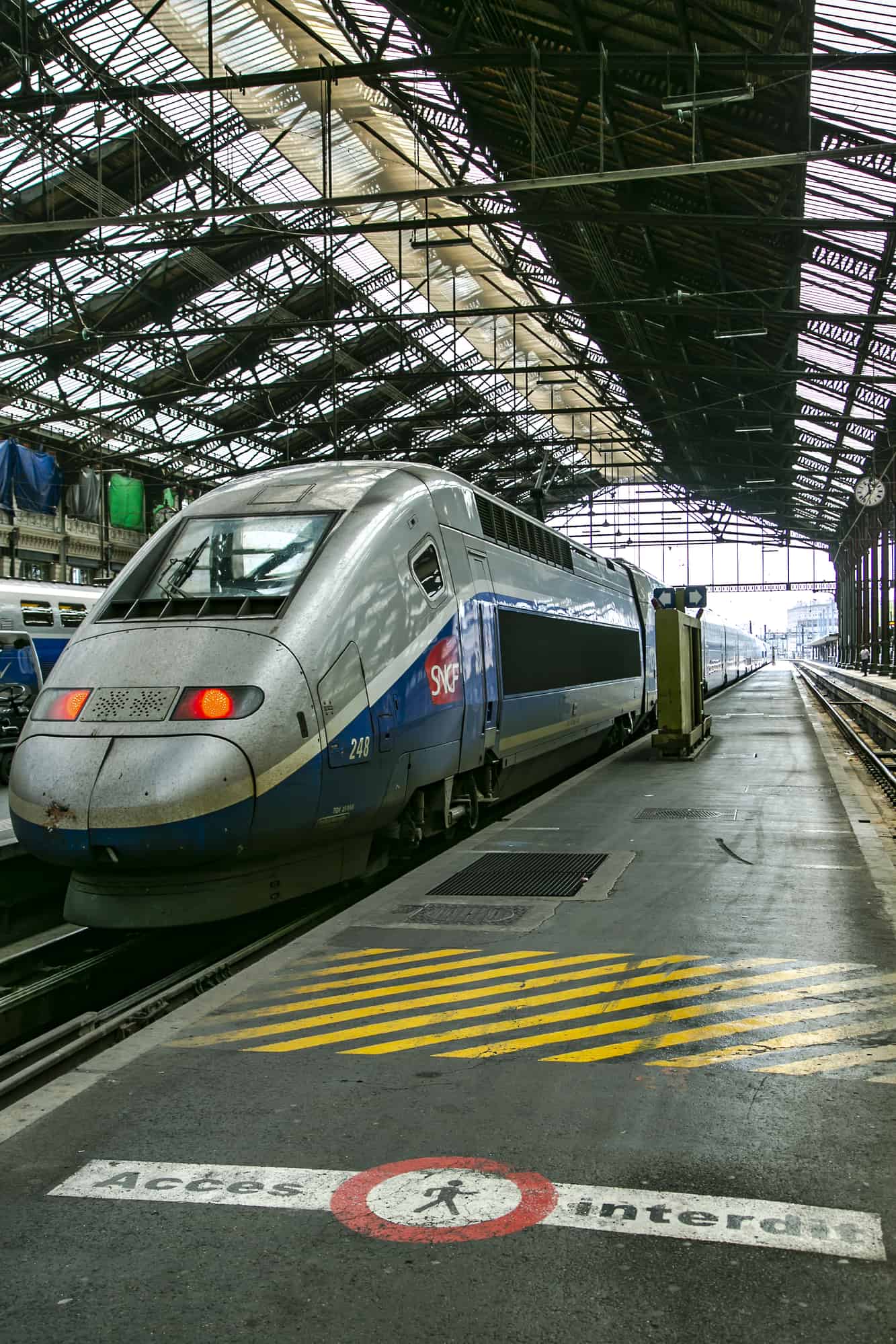
Photo credit: www.depositphotos.com/ursula1964
Table of Contents
Train travel destinations from France
France’s national state-owned railway company is called the SNCF, which stands for Société Nationale des Chemins de Fer Français. The SNCF was founded in 1938, and runs all rail traffic nationwide as well as in Monaco. This also includes TGV (Train à Grande Vitesse) service, the high-speed rail network. France has 27,483 kilometers of railway lines (only second to Germany) making train travel in France a popular option. (via Statista as of 2019).
All of France’s big cities are accessible via train, with Paris being a major hub. In Paris alone, there are six train stations that will get you to other areas of France and Europe: Gare du Nord, Gare de l’Est, Gare de Lyon, Gare d’Austerlitz, Gare Montparnasse, and Gare Saint-Lazare.
In addition to big cities, you can take the train to smaller towns and even more rural areas. Train travel is great for weekend trips from Paris as well. If you’re looking to travel to other areas of Europe via train, you’ve got options. Travel to London, Brussels, Amsterdam and more via SNCF service!
Must-know tips for your first trip to France >>
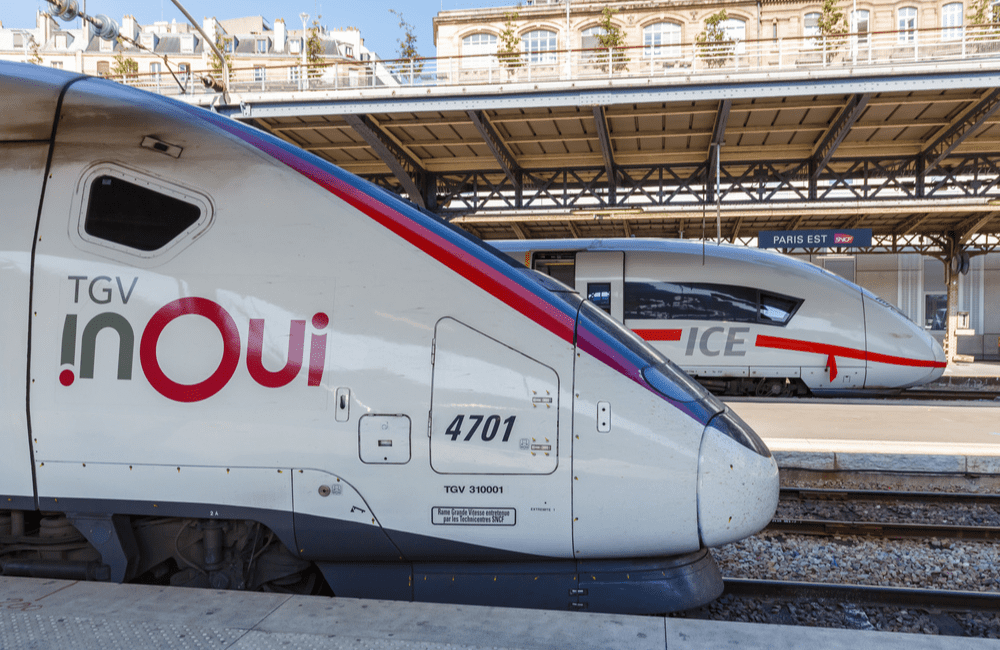
Photo credit: www.depositphotos.com/Boarding2Now
Types of trains and service in France
Train service in France runs like a well-oiled machine with a wide variety of routes nationwide that include big cities, small towns, and even rural areas. As of 2019, the entire SNCF network has over 27,000 kilometers of railway lines, 58% of which were electrified. Over 15,000 commercial trains run daily, transporting more than 5 million passengers and more than 250,000 tons of goods, reported the SNCF.
Let’s talk about the different types of passenger trains available:
TGV INOUI : The TGV is France’s most well-known train, which stands for Train à Grand Vitesse which translates to high-speed train. They can hit speeds of up to 300 km/h (186 mph). The TGV services 200 destinations and has been operating since 1981. TGV Europe also services destinations in Germany, Italy, Spain, Luxembourg, and Belgium. The TGV is the train you take when you want to get from point A to B as quickly as possible.
TGV Lyria : High-speed service that connects France to destinations in Switzerland.
OUIGO: OUIGO is all about low-cost train fares on the TGV. Be sure to book early to score these offers! Small pets travel for free, a piece of luggage is included in the fare, and they’re a steal if your destination is one of the 41 they service. Kids 0-11 years old travel for 5€ one way.
One drawback of OUIGO service is that you have to arrive 30 minutes in advance so staff can check tickets. In addition, extra luggage and seats with a power outlet cost extra and there’s no dining car. Seats tend to be a bit smaller and less comfortable, so take all of that into consideration. None of these were dealbreakers for me when I’ve taken OUIGO trains, though they may be for some people.
As of April 2022, the SNCF launched the OUIGO Train Classique. It is a slower service debuting between Paris and Lyon and Paris and Nantes. The fares are between 10 and 30 euros each way (5€ for kids) and are a great budget-friendly option for those of us who don’t mind a longer trip. The fares are fixed – even for last-minute travel. Note that these fares are only sold online.
INTERCITÉS : Services 150 French destinations, some of which don’t require reservations in advance. They also offer overnight trains on some routes.
TER: France’s regional trains that operate in 11 regions and also connect to the main lines. These are not high-speed trains.
Thalys: High-speed service to Cologne, Amsterdam, and Brussels.
Eurostar : High-speed service to London from Paris, Lille, or Brussels.
Transilien and public transport in the Paris region: This includes the Paris metro and RER trains, bus lines, and more (operated by the RATP). Transilien refers to commuter service in the Paris area.
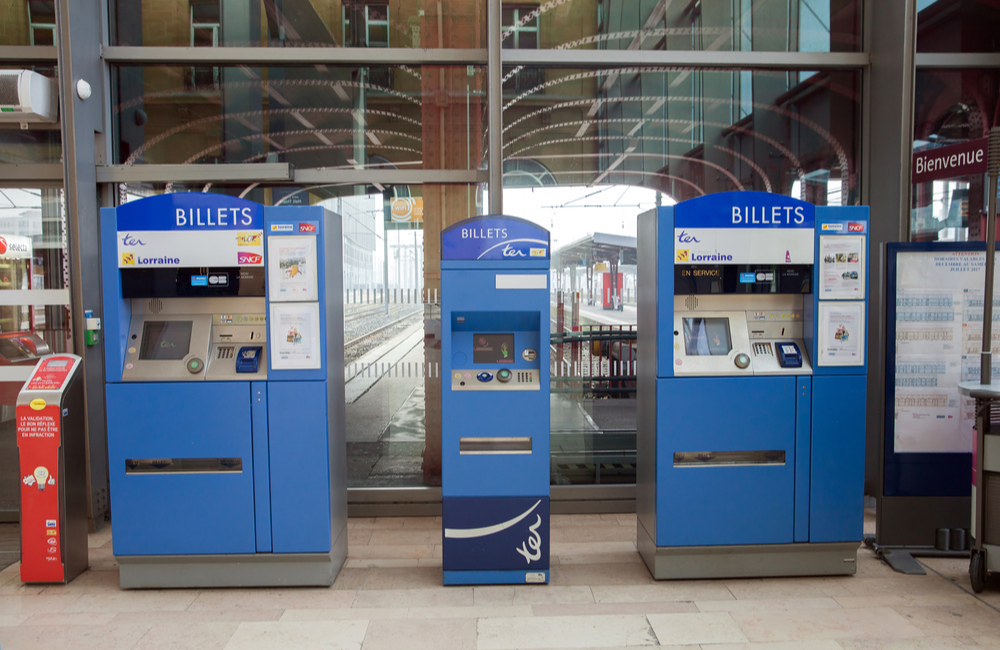
Photo credit: www.depositphotos.com/anrymoscow
Where to buy train tickets in France
You have a couple of options for how to book train tickets in France. You can buy them in person at any train station either at the automated machine terminals or face to face at the ticket window. If you go the ticket window route, take note that they are generally open during French business hours and not 24/7.
Also be aware that there are different types of ticket machines. Some are only for TER train tickets in France, as shown above, and others are for TGV tickets, etc.
Your other option for where to buy train tickets in France is to do so online. This is the only option for many of us if we’re not currently in France. It’s so important to buy from the French SNCF directly to avoid fees and extra hassle. If you do a quick web search for, “How to book train tickets in France,” the official site is often not the first one that comes up and I’ve heard from many of my readers how they’ve been ripped off.
As I mentioned, France’s railway network is called SNCF and the official website/app to buy train tickets is now called SNCF Connect (formerly known as OUI.sncf). The new site has easier route mapping, integrated commuter support and so much more that makes planning a trip a breeze. It’s also available in English.
You can buy tickets for all the types of transport listed above from your computer or phone via their website or the app. You then have the option of printing out a paper ticket or saving the digital version to your phone. The direct website for French train tickets:

There are also other sites called Rail Europe and others geared toward English-speaking foreigners where you can buy France train tickets. They are third-party resellers that are not official sites. Prices are often elevated, so I don’t recommend ever using them. Always go the official route. It’s the best way to buy train tickets in France.
On SNCF Connect , in addition to actually buying/exchanging your France train tickets, you can also plan your trip, find the best door-to-door route, get traffic updates and alerts in real time and buy and renew regional cards and passes. You can also access bus lines and ride sharing offers.
If you travel frequently, are a student, or a senior citizen, it may be cost effective to look into special train passes, so see if you qualify to save a few bucks.
Just like with flights, train ticket prices in France fluctuate as well. You can usually get a much better deal well in advance, while last-minute tickets are usually the most expensive.
BIGGEST MISTAKES tourists make in Paris >>
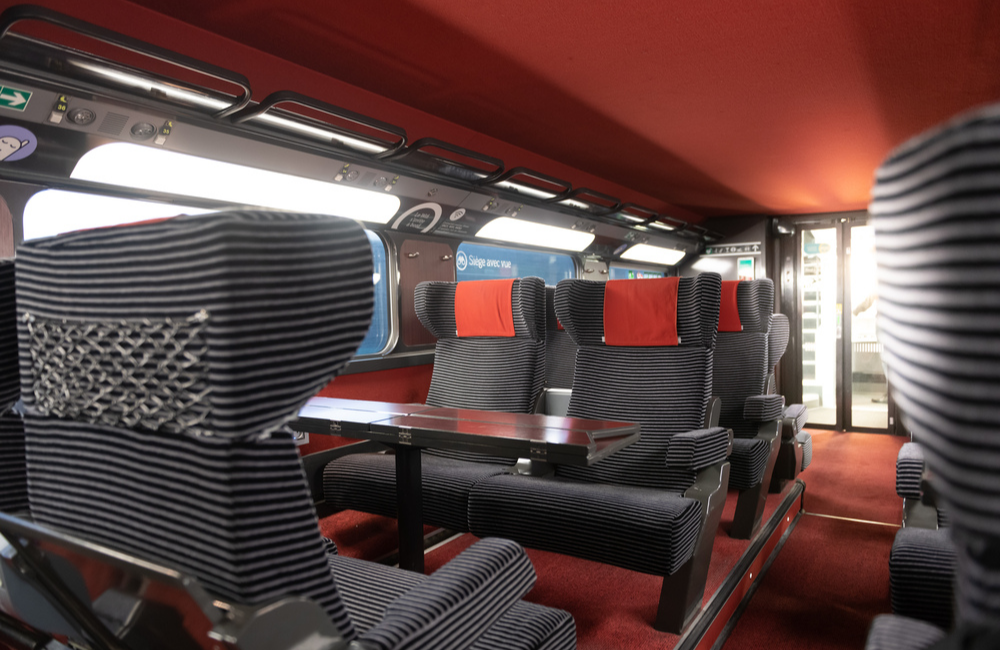
Empty first class TGV seats. Photo credit: www.depositphotos.com/Pixavril
Expert tips for train travel in France
1. Buy tickets early for the best price and availability. If you’re looking to travel by train and know your plans well in advance, it pays to buy the tickets well in advance. You’ll get the best price. Another reason why you’ll want to book early whenever possible is because trains in France sell out since all seating is reserved.
This can be especially true during the peak summer months, during school vacation periods, and on popular routes. As I recommended above, be sure to only use the official site SNCF Connect for the most accurate information and cost-effective tickets.
2. Book a seat that makes sense for you. All TGV seating is reserved. TGVs and longer trips require you to book a specific seat and there are different configurations. Most are two by two and you have the choice of an aisle or window seat. There are also “family” seats called carré (square) which are 4 seats in a two-by-two configuration but facing each other with a table in between (imagine sitting at a 4-person dinner table).
That means two are riding backwards. It can be a little awkward facing a stranger the whole ride. Also, riding backwards isn’t always comfortable for people prone to motion sickness, so pay close attention to what seat you’re choosing.
In addition, some trains are double deckers and have an upstairs level accessible by a staircase. If you have several pieces of luggage or aren’t able to easily climb stairs, upstairs may not be the best option. The booking system will assign you a seat that is easily changed before finalizing your reservation, so again just be sure you’re comfortable with the seat you’re selecting.
3. Consider first class. Along with the above, it might make sense to book a ticket in first class. Sometimes they’re only slightly more expensive than regular second class fares, especially when booked in advance. For more comfortable seats with a little more leg room, more luggage storage, a plug for electronics, and more, first class might be a good choice for business travel or long trips where comfort is important.
Overall, I’ve found that first class seats on the TGV aren’t that different from second class so they aren’t worth a splurge if the difference in fare classes is steep.
4. Show up early. If you’re not used to taking the train in France, be sure to give yourself enough time to navigate the station and get to the right platform and track (called voie in French. You’ll see tracks noted as Voie A, for example).
Paris stations are big and it can be confusing if you’re not used to how things are organized. Spare yourself the added stress that comes along with rushing or having to rebook a missed train and get there on the early side.
5. Note the number of your train car and line up on the platform accordingly. This is a VERY IMPORTANT tip . For trips with reserved seating, it’s imperative that you look closely at your ticket and mentally note the specific train carriage number in which you’ll be seated.
Then find the black display sign on the platform titled “Composition des Trains” that tells you where to stand for your specific car number. It looks like a lit up outline of a train and will usually have a “You are here” dot so you can gauge how far left or right you need to walk to get into position.
TGVs and other international trains can be quite long with 20 or more cars or even two trains that are attached. Because stops are often only a couple of minutes long, you need to be in the vicinity of your assigned seat because you won’t have time to run the length of the platform if you’re near car 4 and yours is actually car 18. This happened to my aunt and uncle in Marseille. They couldn’t get to their train car in time with all their luggage and missed the train.
You can’t just get on and walk between the cars because they aren’t always connected and with the crowds and luggage, it’s not feasible. In some cases, as I mentioned, two separate trains might be connected as they depart Paris but at some point they split and go to different final destinations.
It’s really important you check that you’re in the right seat and in the right car! Definitely take extra care when it comes to lining up ahead of time and then finding your seat once on board.
A final note on the Composition des Trains display sign: There won’t be an employee directing you and it’s not required to line up in any specific place. It’s just that the Composition des Trains display is there for a reason, so be sure to take a look so you aren’t on the opposite side of the platform when the train comes. That way you’ll be in the general vicinity of your assigned seat and won’t have to run.
6. Note the train number. Each train has a specific number so when you look up at the big board or screen in the station that lists out all the departures, you’ll see a train number that corresponds to the destination and time.
Several trains may be going to or coming from the same place so it’s important to know you’re on the train you actually bought a ticket for.
Must-know travel phrases for your France trip (with audio) >>
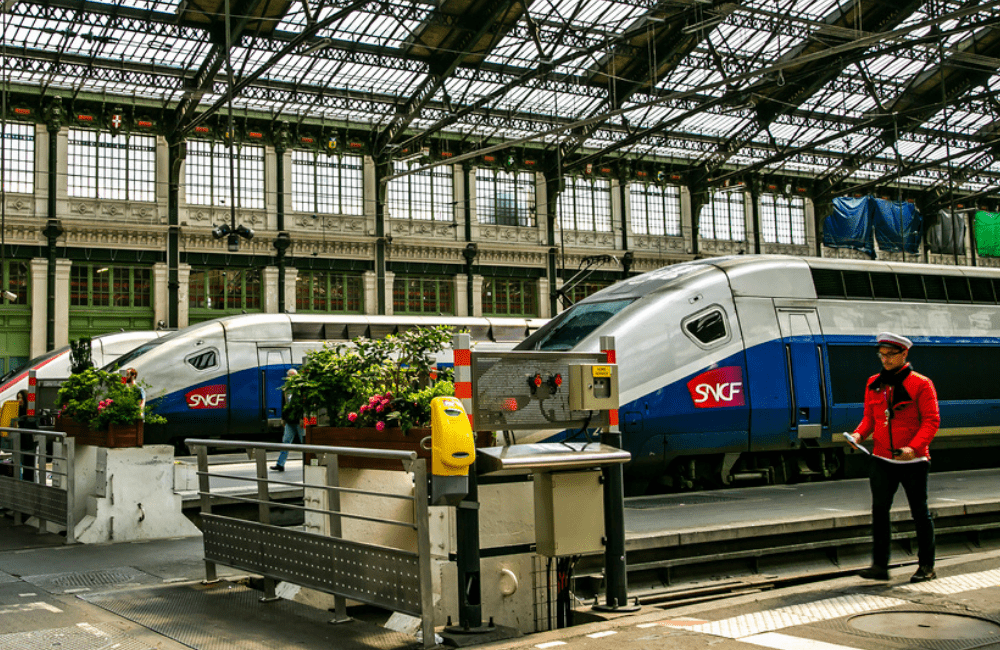
The yellow machine is where you validate your paper ticket prior to boarding. Photo credit: www.depositphotos.com/ursula1964
7. Don’t forget to validate your ticket. All paper tickets for Europe train travel need to be validated before you get on the train in France. To do this, look for the yellow machines with a ticket slot in the train station. There are several usually at the entrance, on the platform, and around the ticket machines and are marked “Compostez votre billet” (validate your ticket).
You insert your ticket into the machine and two seconds later it spits it out with a stamped line of text validating that the ticket is now used. You’ll need to show it to the train employee (contrôleur in French) when he or she checks your ticket after boarding (or in some cases before you board).
Along with that, be sure to have a photo ID with you even for regional trips. In the case of buying your France train ticket online, it’ll be in your name and sometimes they check ID as well. Keep in mind there is no validation process required for e-tickets because they have a special QR code that is scanned directly from your phone. Just the paper ones require the stamp from the yellow machine.
As you’d expect, ID is always checked for TGV and other international trips. Another note on tickets is to always play it safe and buy a train ticket. While the conductor doesn’t always check all tickets, fines are heavy if you try to get a free ride.
Another important tip I should mention is make sure your phone is charged if you have an e-ticket since you’ll need it on and functional to show your ticket.
8. Keep your voice down. Train cars tend to be on the quieter side in France and Europe. People tend to keep their voices low when having private conversations and phone calls are not allowed in some cars. It goes toward respecting the public space and not disturbing those around you. The general attitude for train travel in Europe is to keep your voice down.
American social norms that don’t translate to French cultur e >>
Pros of train travel in France
Easy and efficient way to travel. While France train travel isn’t perfect, it’s a pretty stress-free way to travel. You can easily book your ticket online, arrive at the station, and go. Voilà!
The country is extremely well connected and whether you’re traveling within France or to neighboring European countries, SNCF Connect has you covered. Also, train travel in France doesn’t require you to arrive hours early like air travel does.
Comfortable seats. Compared to regular economy class on most airlines, trains in France are quite comfortable. You have more legroom, big picture windows to take in the view, decent sized bathrooms, and more.
You can head to the bar/food car on some trains where you can buy something to eat or drink. You’re always welcome to bring your own food as well. Many newer trains also have free Wi-Fi.
Lots of options in terms of timing. Most routes have several trains per day (even hourly!) so you have your pick as to whether you leave in the morning or evening or somewhere in between. Train travel is extremely convenient and that’s a top pro.
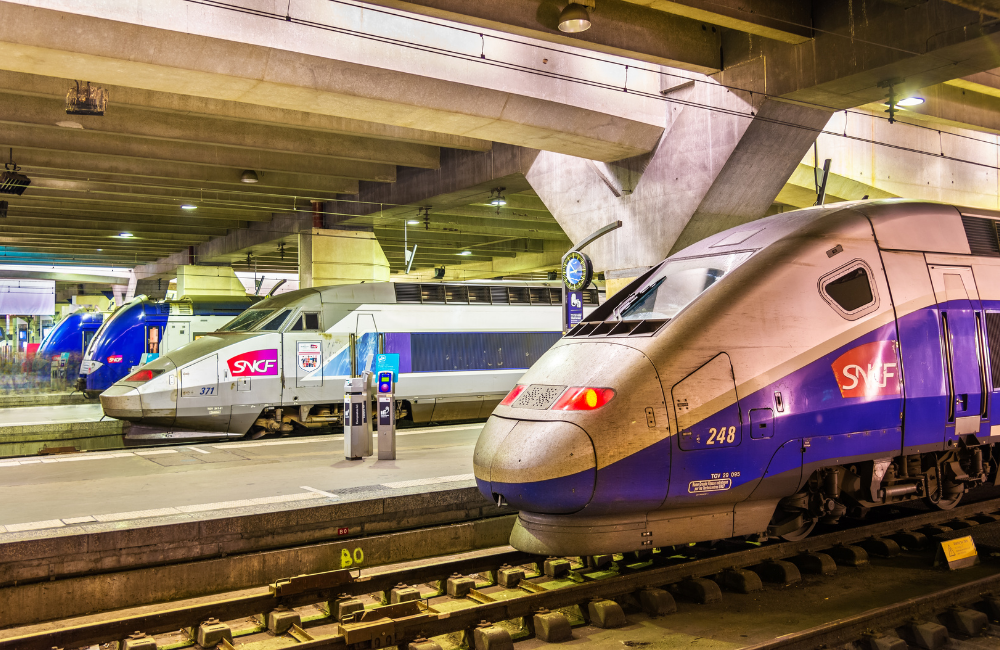
Cons of train travel in France
Possibility of strikes and delays. Like air travel, train travel in France isn’t without its drawbacks. Strikes and delays are not uncommon occurrences. The bright side is strikes are usually announced in advance so you can plan ahead but delays come down to luck.
Weather, technical issues, and more play into whether your trip will be delayed so it just comes with the territory. I take the train regularly and I’m happy to say I’ve only been inconvenienced by strikes and big delays a handful of times in 10 years.
Trips can be long and routing isn’t always direct. If you’re in a rush, train travel may not be for you. TGV and other international high-speed options aside, if you’re trying to get from Angers to Perpignan like I had to when my flight was canceled a couple of years back, be ready for a long day. Routes aren’t always direct and many go through Paris.
In my case I had to change train stations (not just the train!) in Paris which required a taxi. Then my second train was a very slow one that made all the stops. I think the trip was over 8 hours total (flight would have been an hour and 20 minutes).
If you’re in a rush or hate long trips, train travel may not make sense for your specific situation depending on your route.
Not great if you have a lot of luggage. Unlike air travel where you can check large pieces of luggage, when you go by train, you’re responsible for hauling your suitcase(s) onto the train and stowing it in the luggage area. Depending on where you’re seated, this can mean lugging it up or down stairs.
This can be even a bit more challenging on crowded trains when luggage areas are already full. While there aren’t firm luggage limits on regular fare trains, it can get really cumbersome when you have two or three suitcases.
If you are traveling solo and have two or more pieces of luggage, keep in mind that trains only stop for a few minutes so take steps to make the whole on/off process run as smoothly as possible. This includes booking a ticket on the lower level so you can avoid stairs and making sure that you line up on the platform in the area that corresponds to your reserved seat, as we talked about above.
Also, when it’s time to get off, start getting your suitcase out of the luggage area a few minutes before the train arrives in the station. People who got on after you might have boxed your suitcase in so leave yourself time to get organized.
Have you taken a French train? How was the experience? I hope my guide to train travel in France was helpful! Buy your French train tickets and bon voyage!
Traveling to France soon and want to be prepared? Check out my eGuide titled “ 75 Beginner France travel tips for a standout trip! ”
Need some tips on how to dress like a French woman? This is my no BS guide on how to dress in France .
Disclosure: This is a sponsored collaboration between SNCF Connect and Oui In France. All opinions are my own.
PIN my France train tickets and French train travel post:
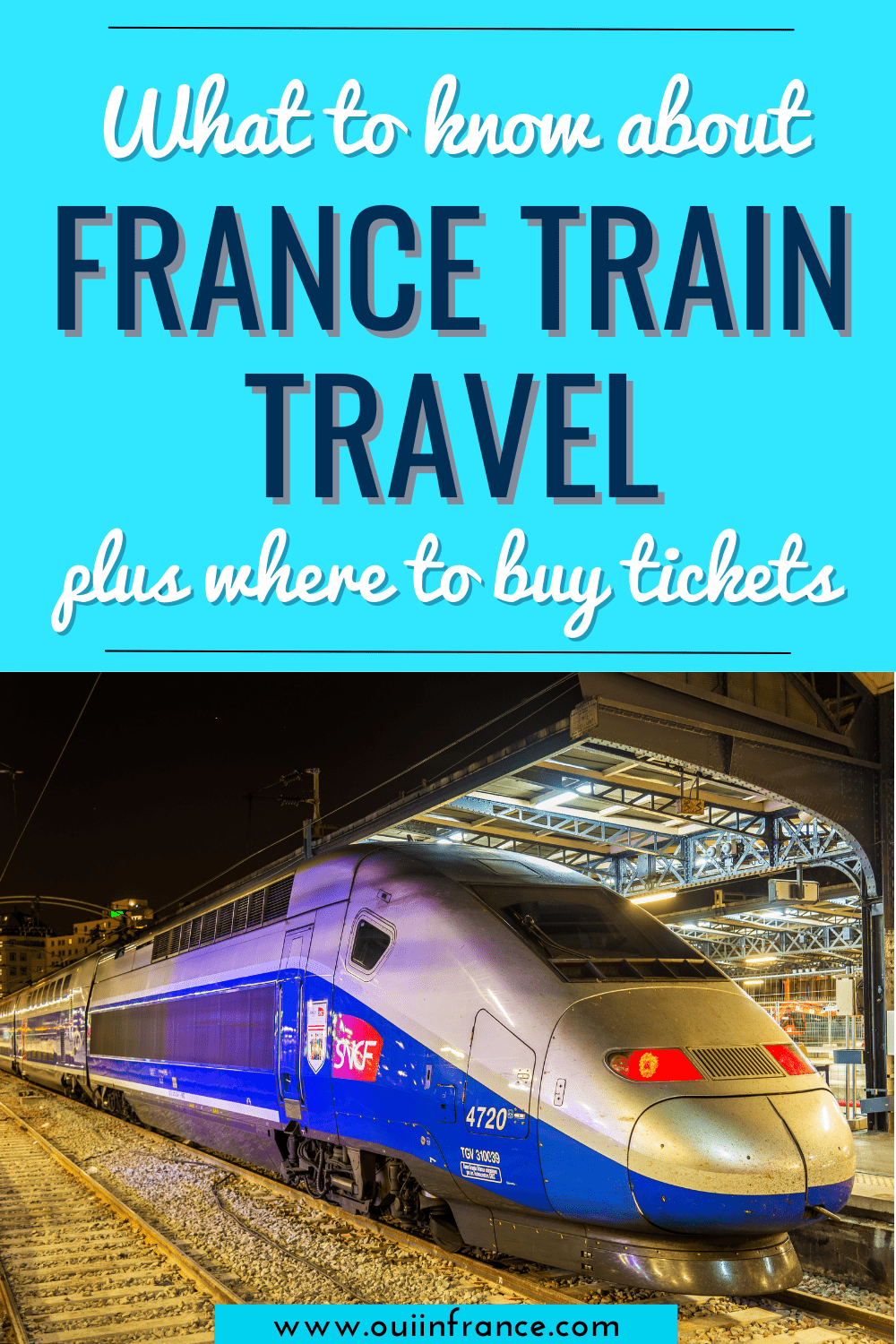
You might like
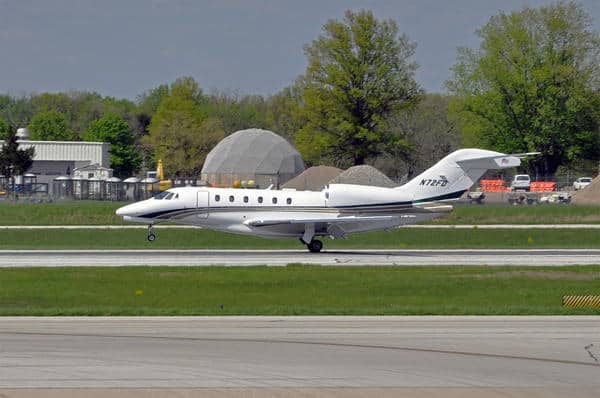
Sign up for the Oui In France Newsletter!
Stay up to date with everything Oui In France! Plus get my FREE GUIDE with 24 DOs & DON'Ts to keep in mind when visiting France!
April 22, 2022 at 5:34 pm
Hey Diane, Great article! Good timing as I’m on a Thalys heading Paris-Amsterdam. I have a question about seats. I did switch seats online when I bought them but I’m stumped as how to make sure I’m not sitting backwards. There’s nothing on the seat map that shows if you’re going the correct direction of train or backwards. Am I missing something? Thanks and be well!
April 23, 2022 at 11:32 am
I’ve been traveling a lot by train in France for the last 2 weeks mostly using the SNCF connect app. The TER tickets I’ve bought with the app are only available on your phone. You can’t print them. The OUIGO and inOui tickets are on the app and sent as PDFs by email so they can be printed if you have access to a printer. The OUIGO tickets can’t be printed at the station if you bought them using the app. The only downside I’ve found is that scanning the tickets is sometimes necessary to get to the platform and it doesn’t always work from the phone. I and a lot of other people had to get assistance from an SNCF employee. That employee was very helpful but only spoke French. Overall I think the app works very well.
If you’re over 60 and book the tickets more than a day in advance you get a 10% discount even without buying a loyalty card.
April 23, 2022 at 2:54 pm
When traveling via TGV, is there a way to tell which end of your car has the luggage racks? We were a group of 7 in December and sometimes boarded on the end opposite the racks. That made life a little challenging! Also, when booking three sets of TGV tickets for 7, I couldn’t get SNCF to register me. It said I had created an account and would receive an email but nothing ever arrived! Therefore, I couldn’t look up my account to see my tickets. Luckily I had the confirmation numbers and could find them that way. A little frustrating. But the train travel itself was wonderful! We did Paris-Reims-Strasbourg-CDG.
April 24, 2022 at 1:48 pm
Hi ! Racks for luggage can be at several places. It depends if your train is TGV, a TER ou another type of train. In TGV (INOUi and OUIGO), racks are most of the time at both end of the seated areas and in the middle of them. You can also slide under your seat your luggage if it’s not too big.
April 23, 2022 at 6:25 pm
Nice article. I always use trains in Europe, as they are faster than using an airplane. I tried to take your advice and tried to sign up for sncfconnect. After entering my credentials, I received an email that says click on Activate my account. Upon doing so, I received
Unauthorized url: https://www.sncf-connect.com/app/en-ww/account/activation , for application: ccl
Upon replying to the email asking for assistance, it was returned as Undeliverable.
Using the Chat feature on the website got me a See our FAQ.
I’ve always used Rail Europe for tickets. While they may be a touch more expensive, at least you can reach a real person if there’s a problem or issue.
April 24, 2022 at 8:40 pm
Now this was really interesting , I love train travel just don’t have a reason to take a train anywhere.
April 29, 2022 at 11:42 pm
Great article. I wished there were more photos of things you talked about. I found it hard to find the right car (several years ago so maybe the signage has changed) and when I asked an employee, he was less than helpful, a bit irritated (it wasn’t because of my French; I’m bilingual). I had a hard time finding the right car. Also is the lining up new? I don’t remember having to line up for my car by a sign. I would love to see that photo. Anyway, great practical advice. And safe travels to you and your family. Looking forward to reading about it when you return
April 30, 2022 at 5:55 am
Hi Jacqueline, thanks so much! Glad you enjoyed it! Sorry for any confusion about the composition du train display. It’s not required that you line up anywhere and there isn’t an employee who will direct people to the right spot on the track. It’s just there to help people get to the right spot more or less so they aren’t on the opposite side of the platform when the train comes (thus increasing the chance of missing their train). It was just my tip to take a peek at the display to get close to the spot where your particular car will come to a stop? Does that make sense? I will update the post with a line clarifying that (and add a pic of the display after I next take the TGV). Thx again & bon week-end !
June 8, 2022 at 6:49 pm
This was an awesome guide to the French trains and systems. I will save it for when we get to go for a few months, maybe next spring. Thanks so much for this and other blogs and videos that you do. They are helpful for us who plan on visiting in the future as well as those there. One question I have is about pets…I think I have read that you can take dogs on the trains except for the TGV high speed. We will have our little 14lb papiillon with us when we travel, so will need to plan accordingly.
July 23, 2022 at 9:54 pm
Thank you for this article, I found it quite useful. Do you happen to know, if I pre-purchase TER tickets on the SNCF Connect app, am I able to retrieve them while offline? Or would a screenshot do the trick? I will not have cellular access while travelling in Europe (just wi-fi at my destination), and I want to be sure that I can show the conductor my ticket when he/she comes around 🙂
Leave a Reply Cancel reply
Your email address will not be published. Required fields are marked *
Notify me of new posts by email.

As an Amazon Associate I earn from qualifying purchases.
The 8 most spectacular train journeys in France

Dec 25, 2023 • 11 min read
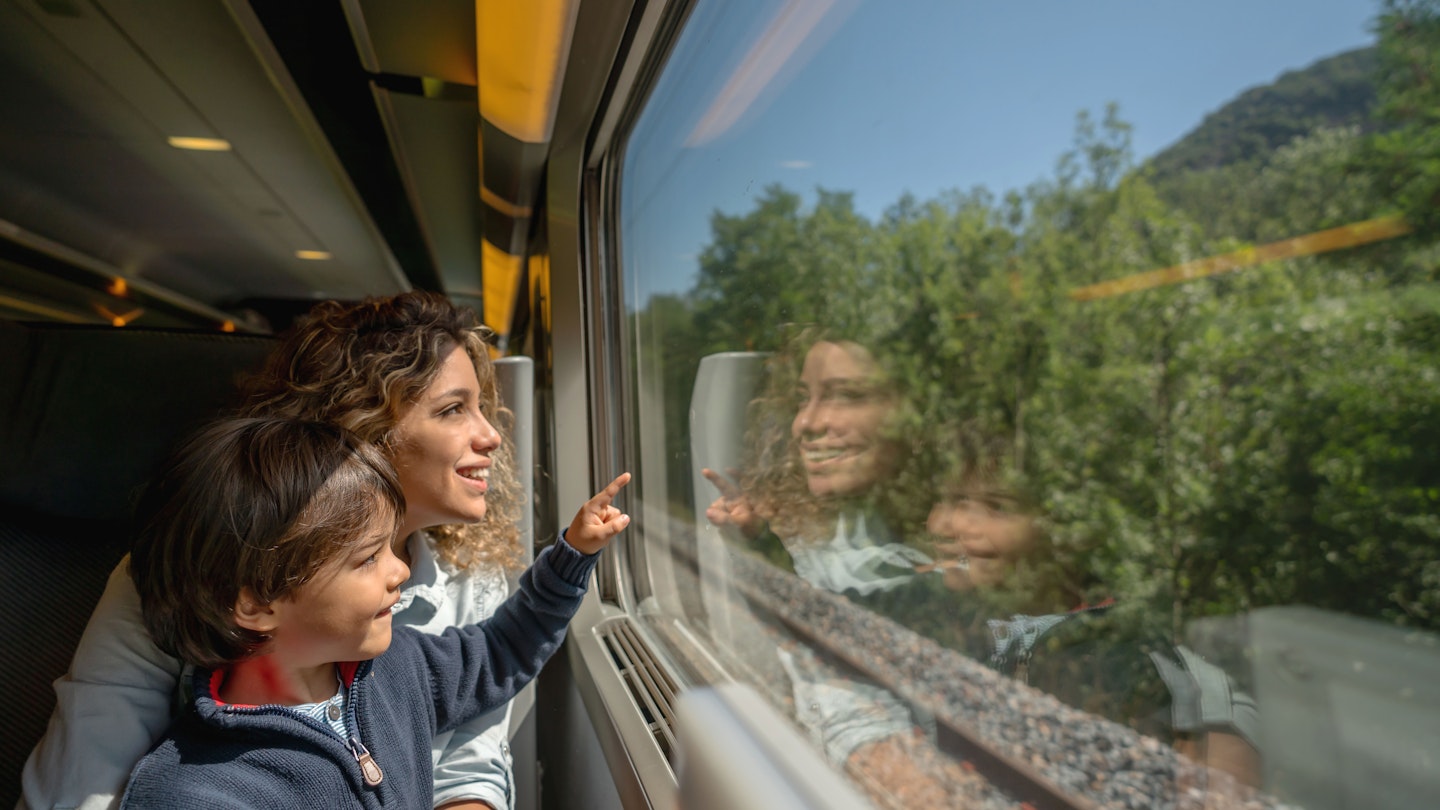
Traveling across France by train might be the ideal way to take in its glorious scenery © iandresr / Getty Images
Chugging past rolling hills full of heritage vineyards, cutting through spectacular mountainous backcountry, or zipping along the coastline of the Mediterranean: there’s no better way to experience the beauty and bounty of France than from the window seat of a train.
The superb rail network in la République makes it easy to explore the far corners of this rich, varied country. We’ve chosen the following journeys because they offer scenic beauty, keep up a vintage heritage or are just plain fabulous. All aboard for the best train rides in France!
1. Le Cévenol is the most remote and wild train ride
Clermont-Ferrand to Nîmes; 303km (188 miles)
The savage beauty of the isolated Massif Central opens up on one of France’s oldest train routes – and one of the most challenging to build, given the topography of the Gorges de l’Allier. In the mid-1800s, the technology to blast through granite and basalt mountains didn't yet exist, so in a triumphant feat of engineering, workers used rudimentary techniques to blast out the line’s tunnels. Le Cévenol (also known as La Ligne des Cévennes) opened in 1870 for both passengers and freight, including coal headed to the Rhône region and wine to Paris.
The Cévenol forms part of a longer, cross-country route linking Marseille to Paris , but most riders jump aboard at Clermont-Ferrand , in the heart of volcano country. You’ll start off admiring volcanic plugs dotting the landscape before heading through the pièce de résistance: the Gorges de l’Allier. High above the Allier River, magnificent views open up, stretching far across the gorge.
Along the way, you’ll cross three historic viaducts, wind through several impressive valleys and traverse 106 tunnels. The highest point is La Bastide-Puylaurent at 1024m (3360ft), while the Chamborigaud viaduct promises a heart-in-mouth experience as you teeter high above the landscape for 409 endless meters (1341ft).
Planning tip: Maintenance work is often carried out in the spring, and SNCF buses replace trains. Be sure to check ahead before booking.
2. Le Train du Montenvers will get you up close to a glacier
Chamonix-Mont-Blanc to Montenvers; 5km (3 miles)
Mont Blanc towers over the Alps, its eternally snow-capped peak providing a majestic vista from afar. To get up close to this age-old mountain, hop aboard the famous cherry-red Train du Montenvers , as sightseers have done since 1908.
Departing from the main train station in Chamonix , the rack-and-pinion train trundles up the mountainside at an angle greater than 9%, climbing through dark forests and tunnels pierced through the rock. Sit on the left side of the train to take in glimpses of Mont Blanc between the fir trees.
It takes about 20 minutes to ascend 1000m (3280ft) up the mountain and – just when you think the high mountain scenery can’t get any more stunning – you arrive at the foot of Mer de Glace , a valley glacier (literally, “sea of ice”) at an altitude of 1913m (6276ft). From here, you can take in the north face of the Grandes Jorasses, an immense face of rock and ice.
Yet the most amazing sights are the dense, blue-colored ice caves of the glacier, through which you can walk to admire ice sculptures (the excursion is included in the price of the train ticket). The interactive Glaciorium , which recounts the glacier’s history, is another must-see. Grab a hot chocolate at Le Panoramique cafe before heading back down, or spend the night at the historic Refuge du Montenvers , with its stunning patio overlooking the Mer de Glace.

3. Marseille to Ventimiglia is the best train ride for dazzling sea views
Marseille to Ventimiglia; 187km (116 miles)
Traveling from Marseille to Ventimiglia in southern France along the SNCF tracks might be a standard journey. The views, however, are anything but. You will be challenged to remain seated for much of the way, as stunning scenes of the azure-blue Mediterranean Sea slide by the train’s window, illustrating the allure of the South of France . Interspersed are glimpses of maquis-covered cliffs (maquis is the tantalizing blend of herbs that grow wild here), terracotta-colored villages, and palm-tree-bedecked hills.
The stops along the way are fabled destinations unto themselves: legendary St-Tropez , made famous by then-unknown Brigitte Bardot; Cannes , with its star-studded legacy; Monaco , home of the Grimaldi royals; and Nice, with its intoxicating mix of world-class museums and legendary beaches. But there are lesser-traveled places as well, including gorgeous Èze Plage , with its medieval village perched impossibly high on a nearby peak, and down-to-earth Menton . Get out, explore, take in some sun – and catch the next train onward later.
The 50-minute stretch between Nice and Ventimiglia is perhaps the most stunning, as you glide past art deco villas, sparkling bays and pastel-colored towns marching up palm-tree-dotted hillsides. You end just at the Italian border, where you have the option of turning around and seeing it all over again.
4. Le Train des Pignes is a fabulous vintage train ride
Nice to Digne; 150km (93 miles)
Behind the Mediterranean-lapped shores of Nice, the jagged gray peaks of the Mediterranean Alps beckon from afar. A ride aboard the “ Train of Pinecones ” chuffs from the glittery seaside up into those snowy mountains in just over three hours, providing stunning, ever-changing views along the way. From Provençal fields and olive groves, you’ll enter a land of deep river gorges and medieval fortresses.
Just 90 minutes from Nice, Entrevaux is a good stop to wander enchanting medieval streets and explore an ancient citadel. Digne-les-Bains , at the end of the line, is cute as can be, with cobblestone streets, bougainvillea-draped stone villas and shops purveying honey, lavender and other local products.
With its diesel railcars and gleaming varnished wood benches, this line is the only remnant of the meter-gauge Chemins de Fer de Provence that once crisscrossed southern France.
The pigne in its name means “pinecone”: perhaps because the train used to run so slowly that passengers could jump off to gather cones or because when the train ran short on fuel, the engineers resorted to burning them. Whatever the case, majestic pine forests surrounding the route add to its scenic allure.
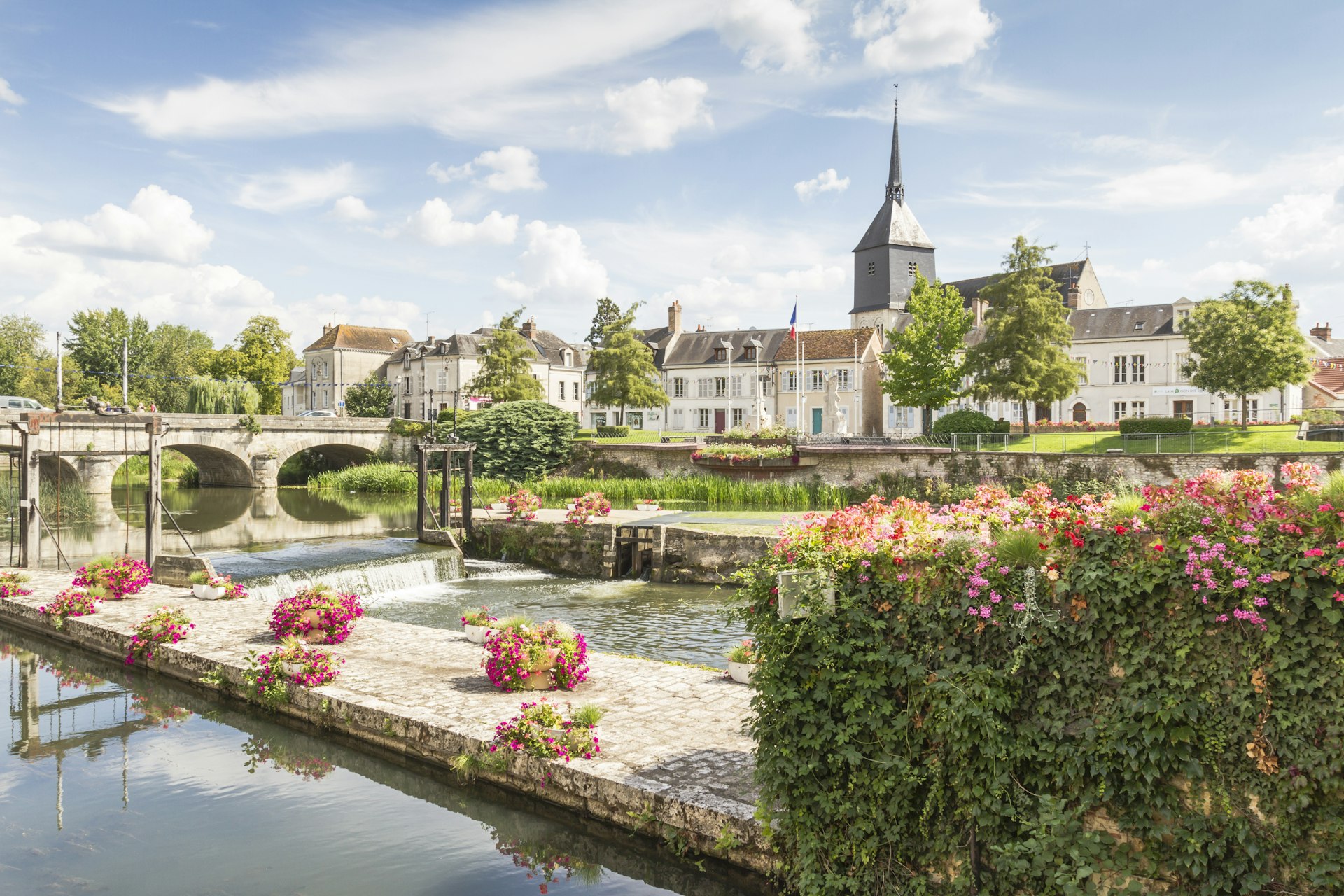
5. Orléans to Le Croisic on Interloire is the best train ride for cyclists
Orléans to Le Croisic; 338km (210 miles)
The Loire Valley unfolds like a fairy tale, with a stunning array of Renaissance castles, green-emerald rivers and charming medieval villages. ( Azay-le-Rideau castle was, after all, the inspiration for Sleeping Beauty .) The Interloire railroad (run by the TER Centre-Val de Loire and TER Pays de la Loire ) traverses this legendary valley from Orléans , the hometown of Jeanne d’Arc, to the fishing harbor town of Le Croisic on the Atlantic.
Must-visit stops include Blois , crowned by the château once occupied by Louis XII; Amboise , Leonardo da Vinci’s final home; and Nantes , a historic Breton town with an evocative 15th-century château.
Planning tip: You can hop on and off the train with your bike to peddle parts of the 900km (559-mile) Loire à Vélo, a relatively flat bike path through this quintessentially French landscape. The train even has a car dedicated to bicycles in the summer.
6. Eurostar through the Chunnel offers a quick escape to London
Paris to London; 451km (280 miles)
If you fancy a quick getaway from Paris to London , perhaps to say hi to Big Ben or to wander through the V&A Museum , count on the Channel Tunnel. Completed in 1994, this extraordinary engineering feat – nicknamed the Chunnel – burrows deep beneath the expanse of water between France and England, allowing passengers in sleek, high-speed Eurostar trains to travel the channel portion of the trip – 51km (31.5 miles) – in just 30 minutes, with a full 38km (23.5 miles) of that underwater.
From Gare du Nord in the heart of Paris to St Pancras International in the heart of London, the entire trip takes just 2½ hours from door to door. Along the way, you’ll enjoy pretty French and English countryside – inside the tunnel itself, you shouldn’t count on seeing any sea life, only blackness until you emerge into the light of day.
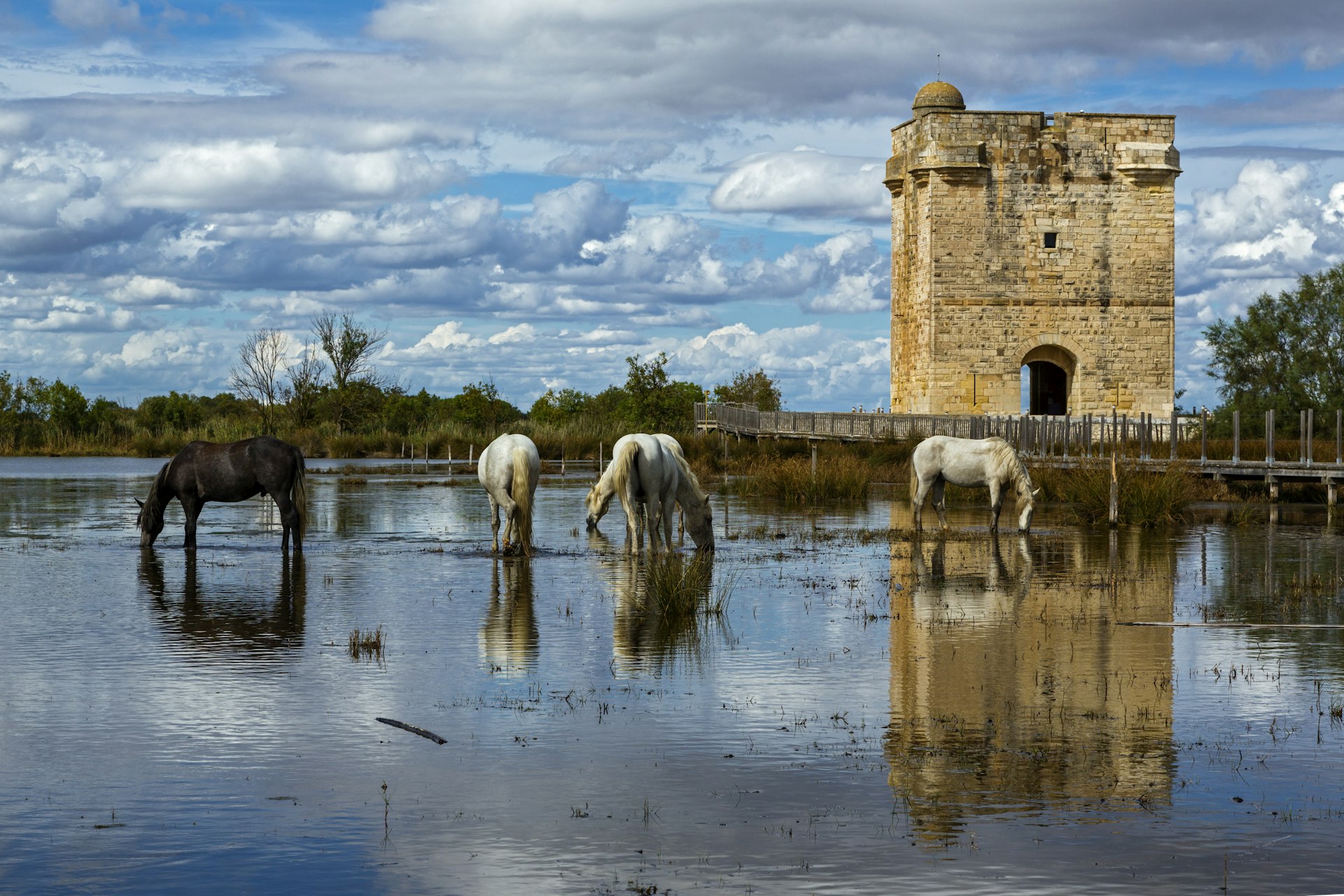
7. The Nîmes to Le Grau-du-Roi Line is the best Wild West train ride
Nîmes to Le Grau-du-Roi; 37km (23 miles)
Wild bulls in Provence? And cowboys? Mais oui . Tucked away in the southwestern corner of Provence, the marshy Camargue – a river delta south of Arles where the Grand and Petit Rhône meet the Mediterranean – reigns as France’s version of the Wild West. Gardians – Camarguais cowboys – live on manades (ranches), riding indigenous white horses with flowing manes as they round up wild black bulls.
Bullfighting is a big part of the culture here (unlike Spanish bullfights, the bulls here are not killed or injured). As are paella (though Camargue rice differs from its Spanish cousin), jazzy manouche music and an independent spirit developed from working a challenging landscape for centuries. You can get to the heart of it all aboard the Nîmes to Le Grau-du-Roi train route.
Departing from Nîmes , the single-track train rumbles through the vineyards of Costières de Nîmes before passing by Aigues-Mortes . Kings departed on their Crusades from this medieval walled city, where you can still stroll ancient streets. From there, you head across the salt marshes and lagoons; keep your eyes out for horses and bulls, as well as pink flamingoes flying overhead. The route ends in Le Grau-du-Roi , just steps from the Mediterranean Sea.
8. Le Petit Train Jaune is the most famous vintage train ride
Villefranche-de-Conflent to Latour de Carol; 64km (40 miles)
This historic little train – or, literally, the “ little yellow train ” – may be the most famous of them all in France. It’s certainly one of its most stunning when it comes to scenery. Chugging through the mountainous Pyrénées-Orientales from medieval Villefranche-de-Conflent to Latour de Carol on the Andorra border, it winds through gorges and shadowy forests, across viaducts, past two historic fortresses and by one perilously perched ancient monastery. The highest point is the Bolquère Eyne depot, a gasp-inducing 1593m (5225ft) high – making it France’s highest station.
Note that two different types of trains operate this route: a modern enclosed train as well as the vintage train that sometimes runs with open carriages. No need to worry about which one to choose, though – both are painted yellow.
Tips for train travel in France
Train options in France
Several different types of trains travel across France, including local and regional trains, overnight trains with sleeping accommodations and the TGV , the high-speed Trains à Grande Vitesse. To travel between most big cities, the TGV is your best bet: these pioneering high-speed trains travel between 255km/h and 320km/h (160mph and 200mph) and will get you there within hours.
Paris to Bordeaux, for example, is 2½ hours, with Paris to Marseille a mere 3 hours 40 minutes. That said, the slower local and regional trains open up lesser-traveled regions of the country. TGV inOui is a new premium TGV train service operated by SNCF on certain high-speed rail services.
Two classes of tickets are usually available to purchase: first ( première ), with plush, reclining seats and ample space; and second ( deuxième ), which is still comfortable but often more crowded. Maps of the French rail network are available on the SNCF website.
How to book a train in France
While you can buy a ticket at the station, either from a ticket window or a vending machine, it’s often cheaper to book your ticket online in advance. Contact Société Nationale des Chemins de Fer (SNCF ) or, from the United States, Rail Europe .
Cheap train tickets in France
France offers various rail passes, including the France Pass, with unlimited travel on the national rail network; and the Eurail Global Pass, which includes train travel to neighboring countries. Deals for hotels, museums and other attractions are often included, too. You’ll find more information on the Rail Europe website .
The TGV offers Prem’s tickets (their term for affordable tickets) three months in advance (the booking horizon may be extended in summer).
The Eurostar high-speed train service connecting the United Kingdom with France (and Belgium and the Netherlands) offers a limited batch of discount fares six months in advance. The sooner you book, the better chance you have of getting a good price.
Set up a booking alert to be notified when discount tickets are released.
How to get from Italy to France by train
You can get from Italy to France via Italiarail. It takes about 11½ hours to travel from Rome to Paris. SNCF also serves the route.
How to get from Spain to France by train
Spain’s train company is Renfe . It takes about 10½ hours to get from Madrid to Paris, a route also served by SNCF.
How to get from Switzerland to France by train
The TGV runs from Geneva to Paris in a little over four hours.
How to get from Germany to France by train
The Deutsche Bahn ’s InterCity Express (ICE) is Germany’s high-speed train service, allowing travel from Frankfurt to Paris in as little as four hours (as long as you don’t have to connect in Cologne). SNCF also serves the route.
How to get from Poland to France by train
It takes between 14 hours and 19½ hours to cross much of Europe from France to Poland, and you typically need to make two changes along the way. Train companies serving this route include Deutsche Bahn, SNCF and Eurostar (the French–Belgian high-speed train operator, which will take you as far as Cologne).
This article was first published August 2022 and updated December 2023
Explore related stories
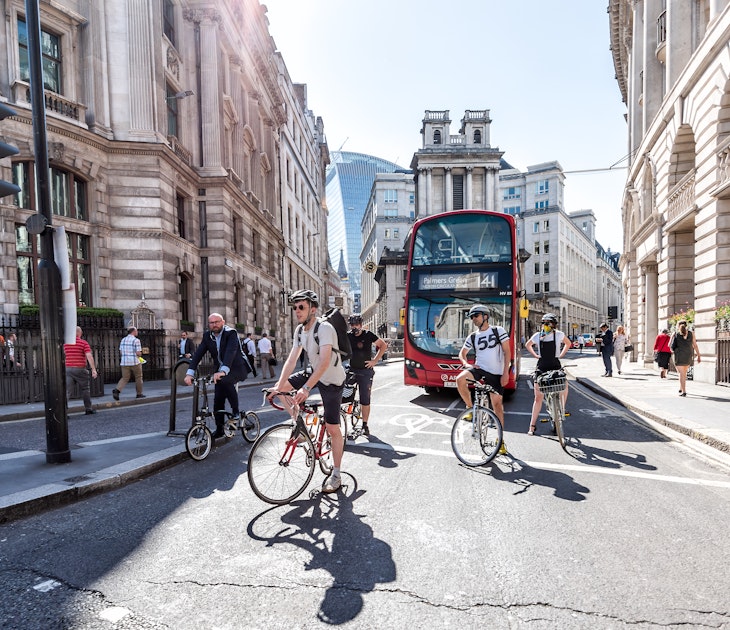
Public Transport
Mar 17, 2024 • 10 min read
London has a huge public transportation system, but is not the most intuitive city to navigate. Here's what you need to know about getting around London.
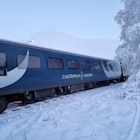
Feb 8, 2024 • 7 min read

Dec 19, 2023 • 6 min read
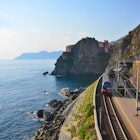
Dec 27, 2022 • 8 min read
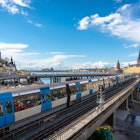
Dec 9, 2022 • 9 min read

Sep 20, 2021 • 5 min read

Apr 19, 2024 • 8 min read

Apr 17, 2024 • 8 min read

Apr 12, 2024 • 9 min read

Apr 3, 2024 • 15 min read
Travel Europe on a Budget
The Savvy Backpacker
City Guides .\33 a132798-3f3b-4585-954d-7e70cf863447{fill:#231f20}
France train guide — how to travel france by train.
How to travel France by train—tips for buying French train tickets and advice for navigating France by rail.
Transportation
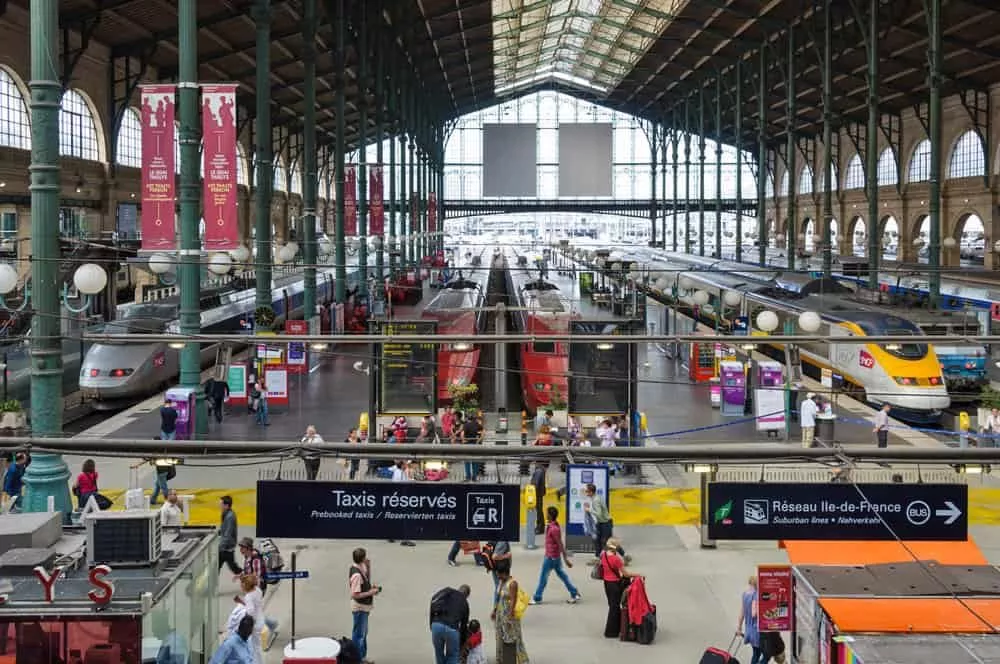
It doesn’t get much better than zooming through the French countryside at 200mph. In fact, when it comes to train travel, France is one of the best-connected countries in Europe and you can easily reach many of Europe’s great cities from Paris.
But, like all things French, their rail network can be a little confusing so we’re here to help. In this France Train Guide, we’ll tell you everything you need to know about traveling France by train—from navigating the system to buying train tickets for the cheapest price.
How To Buy Train Tickets in France
Buying French train tickets is generally easy but there are a few quirks that you’ll come across when booking—keep reading and we’ll walk you through the process.
Let’s first take a look at where and when to buy tickets for the best price…
Quick Note On Electronic Train Tickets And Reliable Mobile Data
Most train tickets in France (and Europe) are electronic so having reliable high-speed data for your phone is important—luckily, getting high-speed data in France is simple and affordable. Here are a few articles I’ve written to help you get set up:
- Guide To Mobile Data Plans and Smartphone Phones in Europe
- How To Buy A SIM Card and Mobile Data Plans in Europe
- Guide To Buying SIM Cards and Mobile Data Plans in France
Where To Buy France Train Tickets For France
So there are a handful of websites/methods for buying French train tickets and each has its own quirks. Let’s take a look at the various options:
Omio is a search engine that lets you compare and book trains anywhere in Europe. It lets you easily book tickets with your credit card at essentially the same prices as France’s Railways website.
Additionally, Omio searches routes for multiple rail services across Europe so it’s great for international trips (since it can easily combine rail journeys of multiple countries). Omio also gives you the option to print your own tickets or have eTickets sent to the Omio App.
TrainLine is another third-party booking site that connects directly to the French National Rail Network and other European networks. Trainline also accepts international credit card payments and lets you print your own tickets or have eTickets sent to the Tranline App.
SNCF (National French Railways)
The website for the official French Railways is en.oui.sncf . The main problem with this site is that it often tries to redirect you to RailEurope.com—which is SNCF’s official North American partner. Unfortunately, Rail Europe rarely finds the cheapest fares so you have to actively try to keep the site from redirecting you. And trying to book through the official SNCF website can be equally as difficult because it can be plagued with translation issues and sometimes they reject foreign credit cards.
Perosanlly, I’d stick with Omio .
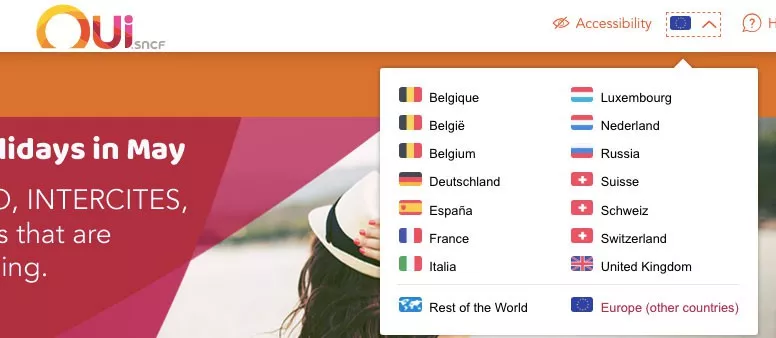
A few years ago the French National Railways created a new low-budget train line called Ouigo . It basically connects Paris with a handful of popular French destinations.
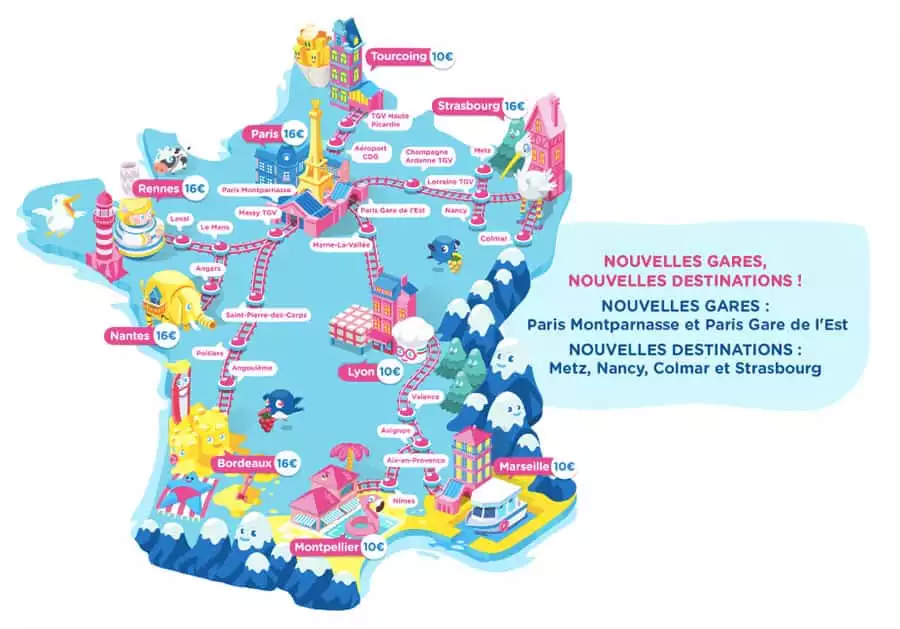
Some Ouigo trains leave from stations outside Paris so it takes a little under an hour by regional train to get there from central Paris. However, some trains do leave from central Paris. There are a few other restrictions (like limited luggage) but the fares can be crazy cheap. Booking websites like Omio will include Ouigo in their results so you don’t have to search Ouigo’s website to find/buy its tickets.
The Eurostar is the train that connects Paris and London. You can usually book this journey on other websites but we’ve found it best to book directly from the Eurostar site for the best prices.
At The Station
Of course, you can buy any French train ticket from any train station — either from a ticket window or an automated machine (you’ll need a Chip & PIN credit card to buy from the machines). You can buy tickets in advance from train stations as well.
HOW TO COLLECT YOUR FRENCH TRAIN TICKETS
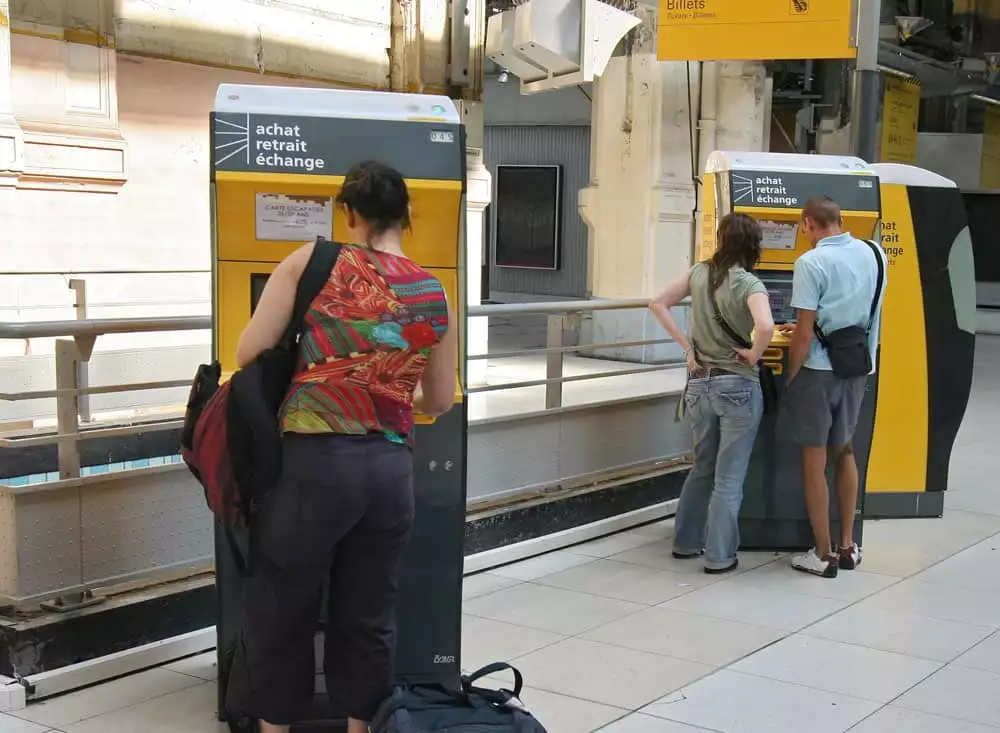
Tickets purchased online can be collected in a few different ways. Most times you’re given multiple methods of collecting your tickets:
- Electronic Tickets: You can usually have tickets sent to your phone/tablet. For example, tickets bought via Omio will be sent to your Omio app. You can also have tickets sent to your email. Then you simply show it to the conductor on the train when they check your tickets.
- Print-At-Home Tickets: You can print tickets at home and show them to the conductor on the train when he checks tickets.
- Also, you’ll need a Chip & PIN card to collect from the automated machines but you can use a swipe card at the ticket window. However, at other times you only need the booking reference number.
- Mailed Tickets: Some services will mail you physical tickets but this is often a slow process. We suggest avoiding this and sticking to the other options.
Do You Need To Buy French Train Tickets In Advance?
France has a number of different train services so it can be a little confusing to know what tickets should be purchased early and which can be bought whenever. We’ll break it down below.
High-Speed TGV Trains — Buy Early As Possible

Yes – book early. Tickets for France’s TGV high-speed trains are available to purchase around 90 days in advance. Booking these early will get you the cheapest tickets and prices will generally continue to rise as the departure date approaches. For example, a day-of ticket can cost well over €100 but that same one bought weeks early might only cost €30.
International Trains — Buy Early As Possible

There are a few separate train services that connect France to other countries. These are high-speed trains so the same rules about booking early apply to these tickets as well.
- TGV Lyria: High-speed trains that connect France and Switzerland.
- THALYS: High-speed trains that connect Paris with Belgium, Germany and the Netherlands.
- Inter-City Express (ICE): High-speed trains that connect France and Germany.
- Eurostar: High-speed trains that connect Paris and London.
Intercité Trains (IC) — Buy A Little Early

Intercité trains are fast trains but not as quick as the TGV trains. They usually also connect shorter distances and the trains aren’t quite as nice as the TGV. These tickets can also be purchased in advance for a discount.
Regional/Local Trains — Buy Whenever

France has a number of slow trains that connect suburban and regional areas. TER (regional trains that connect smaller towns with regional hubs), Transilien (connects suburban Paris), and RER (also connects suburban Paris). These tickets are priced by distance traveled so you don’t need to buy them in advance — simply purchase them at the station right before departure.
Don’t forget to validate your ticket before you get on the train or you’ll be fined.
How To Use Your French Train Tickets
On high-speed trains , your ticket is only good for the specific time stated on your ticket. You’ll also be given an assigned seat. You don’t need a validate your ticket because your seat is reserved (but they might check your ID on the train). NOTE: Your ticket will show the car and seat number so make sure you’re in the right car (the trains are clearly marked).
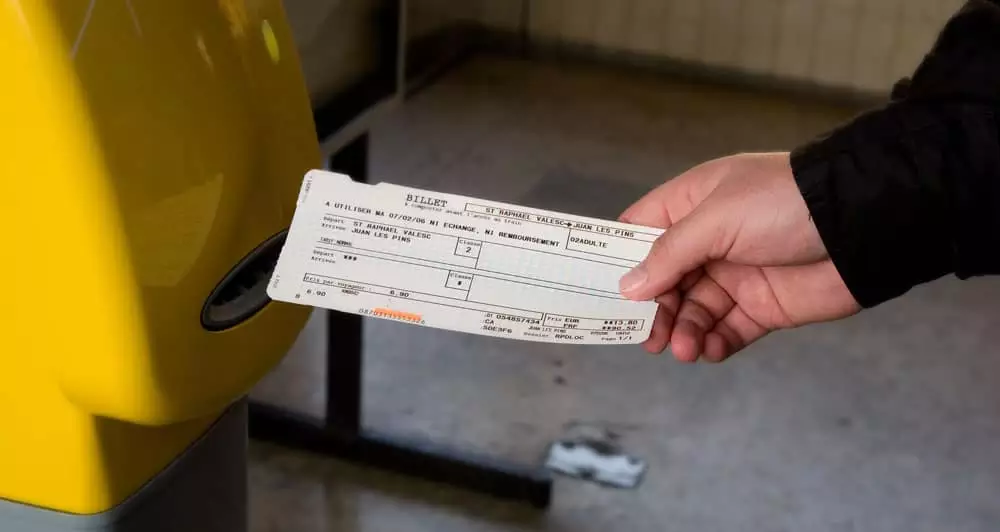
On regional/local trains , you might have a physical ticket. Make sure to validate (i.e. stamp) your ticket in the validation boxes on the platform before you get on the train. They’re sometimes hard to find so watch what the locals are doing. If you forget to validate, seek out the conductor right away and have him stamp it — if you wait until he comes around you might be given a fine.
Regional trains won’t have seat reservations so just sit anywhere.
Once you’re on the train the conductor will eventually walk through the aisles to check tickets.
HOW TO MAKE RAIL PASS RESERVATIONS
High-speed trains require you to make a reservation when using a Eurail pass — the reservation costs €10-€30/seat for domestic travel and international trains can charge anywhere from €35-€89/seat (depending on destination). As you can see, those international train reservations can be wildly expensive — in fact, the reservation fee is often more expensive than buying a separate ticket.
You must make the reservation before you get on the train. There are a few ways to make reservations:

- Make Reservations Online: Omio lets you book your reservation online through their platform. Simply look for a button that says “I Have A Railpass” and follow the prompts.
- Make Reservations At The Train Station: You can simply go to the train station and book your reservation from the customer service desk or self-service kiosks. You can book it weeks in advance or you can do it the day you depart. We suggest using the kiosks because the ticket window can take forever.
More Tips For Riding Trains In France
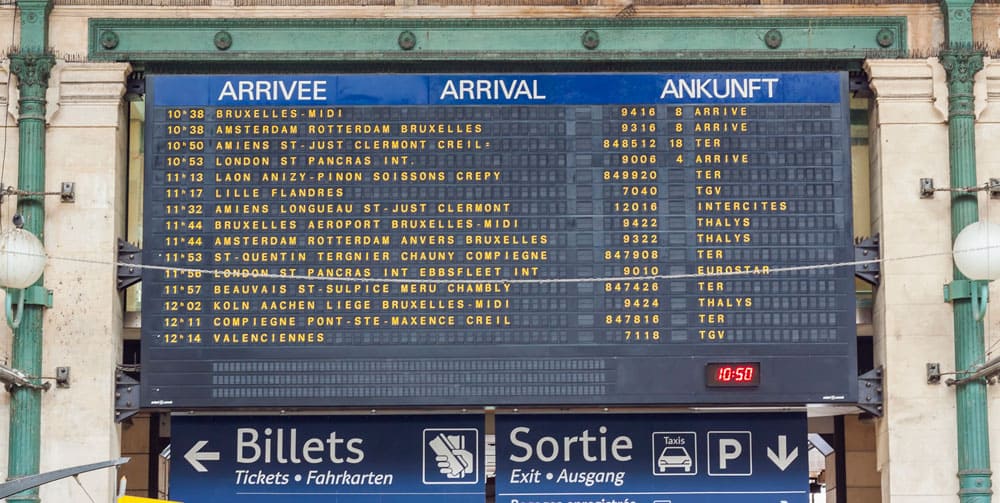
Here are a few general tips about train travel in France.
Study The Departures Board
You’ll find your train platform via the departure board at the train station. Don’t worry if you don’t see your train right away because they often only display trains departing within the next 10-20 minutes.
However, do pay attention as sometimes the platform can change last minute.
Know Train Station Names
Most large cities have multiple train stations (Paris has seven) so this often creates confusion. Double-check to make sure you have the right station—especially when booking your ticket.
Self-Service Machines Are In English
Don’t worry if you don’t speak French because the ticket machines (and train station signs) are all in English. Most customer service workers also speak some English.
Cheap Tickets Are Non-Refundable
One downside to cheap tickets is that they’re non-refundable and can’t be changed.
Pack A Picnic
You’re allowed to bring your own food and alcohol on trains. It’s great for those long train rides.
No Luggage Restrictions
There aren’t any weight limits on luggage and you can bring as much as you want (well, as much as you can carry). Simply bring it on and store it above your head, behind your seat, or in the luggage racks in each car.
Making Connections
Your rail journey might require you to change trains along the route. Don’t worry if there are only a few minutes between trains because switching trains is usually fairly quick and easy—it’s not like flying where you need an hour-long layover.
Get To The Train Station Early
Train stations are usually fairly easy to navigate but they can be a little confusing. There isn’t any security that you have to go through (except for Eurostar and THALYS trains) but it doesn’t hurt to arrive about 20 minutes early.
First Class vs Second Class Tickets
First Class tickets normally cost 1.5x the Second Class rate. Second Class is perfectly comfortable but First Class seats are a bit bigger and it’s quieter. Other than that, there isn’t much more of a difference.
Use A Credit Card With A Chip
Automated ticket kiosks require a card with a Chip & PIN so make sure you know your PIN code.
Rail Strikes
France is well-known for train strikes. They always give ample warning before going on strike and they still run some trains, but it’s something to pay attention to.
Read More Of My Articles On Budget Travel in France

- Paris Travel Guide: Tips For Visiting Paris
- How To Choose The Best Travel Insurance : Travel insurance will help cover those non-refundable train tickets if something goes wrong during your trip.
- Packing List For Europe Travel : Tips on packing light (which makes train travel much easier).
- The Best eSIM Data Plans For France: My guide to the cheapest prepaid eSIM data plans for your trip to France.
- Recent Posts
- Best Prepaid UK eSIM | Data Plan Buyer’s Guide - April 21, 2024
- How to Avoid Pickpockets in Europe — Tips for Outsmarting the Thieves - April 19, 2024
- Best Prepaid eSIM For Italy | Data Plan Buyer’s Guide - April 18, 2024

No Funny Business
The Savvy Backpacker is reader-supported. That means when you buy products/services through links on the site, I may earn an affiliate commission—it doesn’t cost you anything extra and it helps support the site.
Thanks For Reading! — James
Questions? Learn more about our Strict Advertising Policy and How To Support Us .
Related Reads
How to purchase train tickets for europe | strategies for buying european train tickets.
Tips on the easiest and cheapest ways to buy train tickets in Europe.
Complete Guide To Train Travel In Europe | How To Travel Europe By Train
Our step-by-step guide to traveling Europe by train.
Italy Train Guide — How To Travel Italy By Train
How to travel Italy by train — tips for buying Italian train tickets and advice for navigating Italy by rail.
How To Buy Train Tickets in France | Guide To Buying French Train Tickets
What you need to know about booking train tickets in France and tips for getting the cheapest prices.
City Guides
Choosing travel insurance, travel packing lists, budget travel newsletter.
The best budget travel tips sent straight to your inbox.
Join My Journey
Europe travel tips, advertising & privacy policies.
TheSavvyBackpacker.com is a participant in the Amazon Services LLC Associates Program, an affiliate advertising program designed to provide a means for sites to earn advertising fees by advertising and linking to amazon.com.
© 2010 - 2024 The Savvy Backpacker
Website Design by FHOKE
Country and language
United Kingdom
United States
Deutschland
@media (max-width: 37.5rem){.css-vo707v{font-size:1.5rem;}} Log in
Verify it's you, @media (max-width: 52.5rem){.css-1qvpg8e{font-size:1.375rem;}} no account.
Join Club Eurostar for FREE
- Travelling with Eurostar
- Frequent travellers
- Manage your booking
Frequent or Premium Pass
Please log in to use your subscription pass.
Didn't get the code? Send again

Trains to France
From the corner cafés of Montmartre to the lavender fields of Provence, it's never been easier to explore every corner of France by train.
Eurostar trains to France
With Eurostar tickets to suit every budget and trains leaving for Paris throughout the day, start your escape in London and arrive rested and raring to go, right in the heart of the action.
The perfect place for romantic strolls or extravagant sprees, Paris is hard to beat for a weekend break. Treat someone special or splash out with your friends in the City of Light. But don't forget, there's more to France than Paris.
And when you're ready for some serious R&R, head to the Med. Don your shades and settle into a beach-front bistro on a balmy evening to watch the world go by and the sun go down over a glass of something délicieux. With so much to do and more trains than ever, there's never been a better time to explore France by rail.
Trains to the north of France
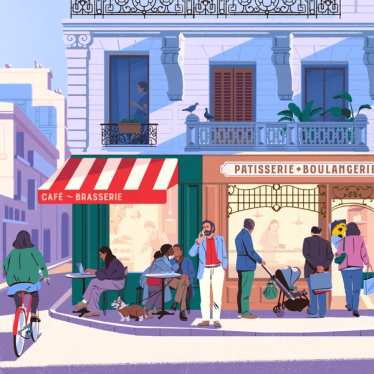
London to Paris trains
Taking the Eurostar from London to Paris is quick, easy and enjoyable. Journey from one world-famous capital city to another in just 2hrs 16 mins.

London to Lille trains
At under 1 hour 30 minutes from London, Lille is the perfect place to go for a day trip, especially as the station is just a short walk from the main square and shops.
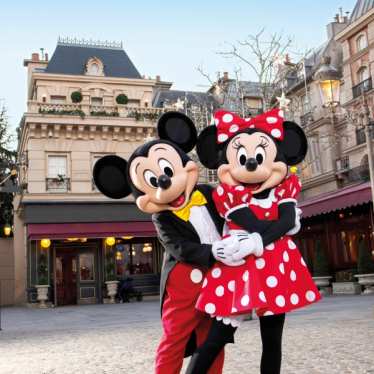
London to Disneyland® Paris trains
For a magical break from the real world, where better than the place where magic gets real? Disneyland® Paris is sure to be a hit with all the family, adults and kids alike.
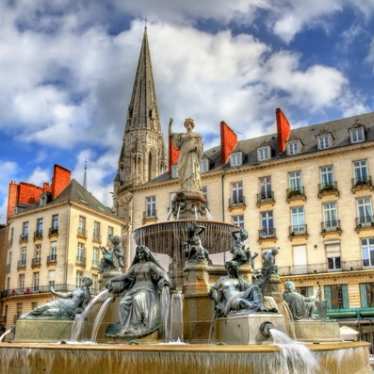
London to Nantes Trains
If you haven’t been to Nantes, what are you waiting for? Whether you’re travelling with friends or family, this exciting town has lots to do and see.
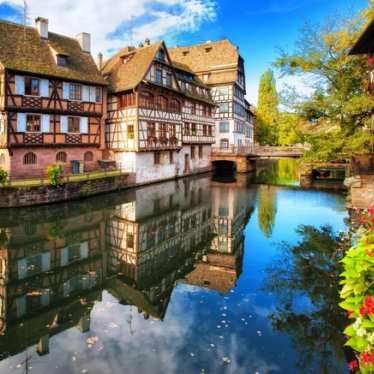
London to Strasbourg trains
With rich architectural heritage, extraordinary cathedral and sweeping views of the city - Strasbourg is a top spot for sightseeing.
Train to the south east of France
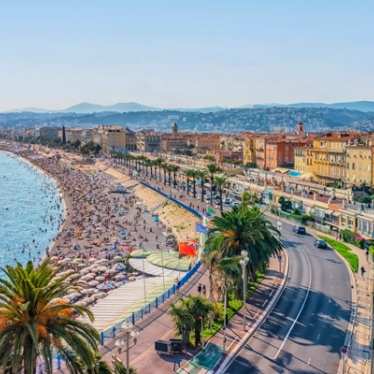
London to Nice Trains
It may not be the fastest way to travel from London to Nice, but it’s the most scenic and stress-free. Sit back and enjoy the scenery as you speed down to the sun.
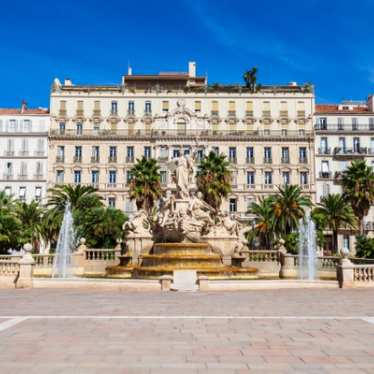
London to Toulon Trains
For a holiday that combines culture, history, fresh air and fun, head to Toulon. You can walk off all the delicious food and wine on the sandy beaches or sightseeing.
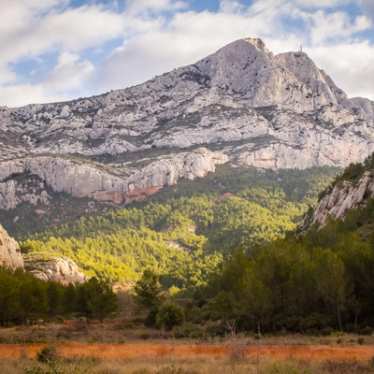
London to Aix-en-Provence Trains
With its artistic atmosphere, Aix is the perfect place to find perspective. Explore the winding streets or just sit back with a pastis and watch the world go by.
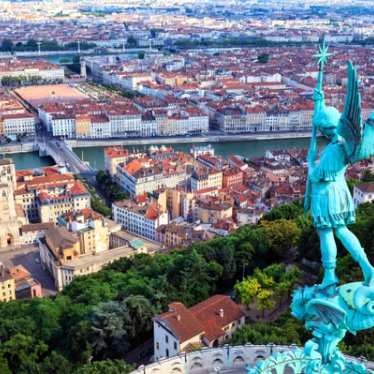
London to Lyon trains
For foodies and history lovers alike, Lyon has it all. The gastronomic capital of France and a UNESCO World Heritage site, it’s perfect for a holiday or city break.
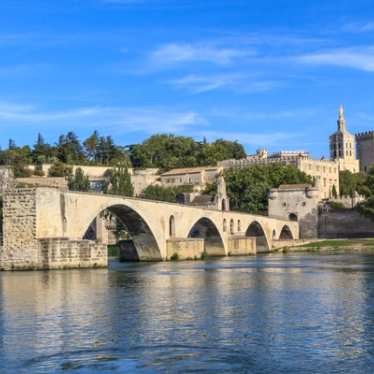
London to Avignon Trains
Head to the South of France with Eurostar. No hassle, no baggage restrictions, just a relaxing trip down through the beautiful French countryside.
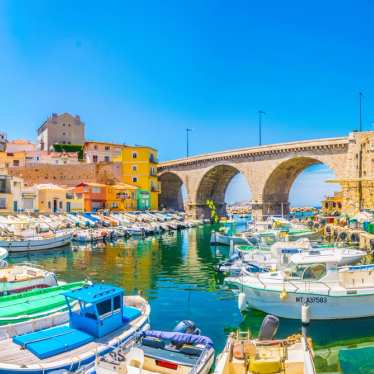
London to Marseille trains
From London St Pancras to the Mediterranean coast in time for lunch, hop on the Eurostar and you’ll be basking on the beach or sipping wine on a terrace in no time.
Trains to the south west of France

London to Toulouse Trains
Toulouse, with its tree-lined waterways, leafy parks, impressive museums and galleries and rugby-loving locals, is the perfect place for a relaxing holiday in the sun.

London to Montpellier Trains
The beach in the morning, wine tasting in the afternoon and dinner on a terrace, this lively university town is the perfect base for exploring this beautiful area.
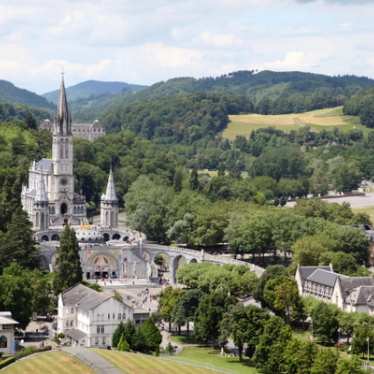
London to Lourdes Trains
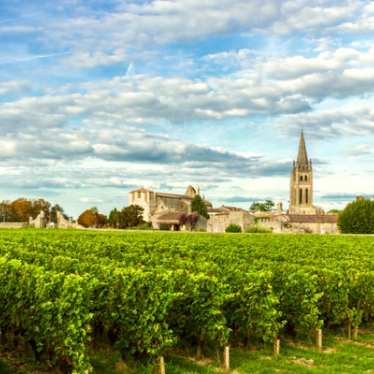
London to Bordeaux trains
With a quick station change in Paris you can travel all the way to Bordeaux by train. Before you know it you’ll be sampling the food and wine and feeling like a local.
Frequently asked questions
.css-5vuhm9{display:-webkit-box;display:-webkit-flex;display:-ms-flexbox;display:flex;-webkit-box-pack:justify;-webkit-justify-content:space-between;justify-content:space-between;-webkit-align-items:center;-webkit-box-align:center;-ms-flex-align:center;align-items:center;max-width:100%;border:none;text-align:left;width:100%;background:none;cursor:pointer;position:relative;padding:1.5rem 1rem;}.css-5vuhm9:hover{-webkit-text-decoration:underline;text-decoration:underline;text-decoration-color:#00286a;}.css-5vuhm9:focus-visible{border-radius:1px;outline:2px solid #00286a;outline-offset:2px;}@media (min-width: 37.5rem){.css-5vuhm9{padding:1.5rem;}} .css-4ujqbu{height:0.188rem;display:block;position:absolute;left:0;right:0;top:0;margin:-2px 0 0;opacity:0.4;border-bottom:2px solid #00286a;border-radius:60%;} .css-1ro6ief{--grid-columns:12;--grid-columnspacing:0rem;--grid-rowspacing:0rem;-webkit-flex-direction:row;-ms-flex-direction:row;flex-direction:row;min-width:0;box-sizing:border-box;display:-webkit-box;display:-webkit-flex;display:-ms-flexbox;display:flex;-webkit-box-flex-wrap:wrap;-webkit-flex-wrap:wrap;-ms-flex-wrap:wrap;flex-wrap:wrap;margin:calc(var(--grid-rowspacing) / -2) calc(var(--grid-columnspacing) / -2);-webkit-box-pack:justify;-webkit-justify-content:space-between;justify-content:space-between;width:100%;padding:0rem;} .css-1fiqx1u{--grid-columns:12;--grid-columnspacing:0rem;--grid-rowspacing:0rem;-webkit-box-flex:0;-webkit-flex-grow:0;-ms-flex-positive:0;flex-grow:0;-webkit-flex-basis:auto;-ms-flex-preferred-size:auto;flex-basis:auto;width:calc(100% * 10 / var(--grid-columns));-webkit-flex-direction:row;-ms-flex-direction:row;flex-direction:row;min-width:0;box-sizing:border-box;display:-webkit-box;display:-webkit-flex;display:-ms-flexbox;display:flex;-webkit-box-flex-wrap:wrap;-webkit-flex-wrap:wrap;-ms-flex-wrap:wrap;flex-wrap:wrap;margin:calc(var(--grid-rowspacing) / -2) calc(var(--grid-columnspacing) / -2);-webkit-box-pack:justify;-webkit-justify-content:space-between;justify-content:space-between;}@media (min-width:37.5rem){.css-1fiqx1u{-webkit-box-flex:0;-webkit-flex-grow:0;-ms-flex-positive:0;flex-grow:0;-webkit-flex-basis:auto;-ms-flex-preferred-size:auto;flex-basis:auto;width:calc(100% * 12 / var(--grid-columns));}} .css-2pnwxm{--grid-columns:12;--grid-columnspacing:0rem;--grid-rowspacing:0rem;-webkit-box-flex:0;-webkit-flex-grow:0;-ms-flex-positive:0;flex-grow:0;-webkit-flex-basis:auto;-ms-flex-preferred-size:auto;flex-basis:auto;width:calc(100% * 12 / var(--grid-columns));-webkit-flex-direction:row;-ms-flex-direction:row;flex-direction:row;min-width:0;box-sizing:border-box;display:-webkit-box;display:-webkit-flex;display:-ms-flexbox;display:flex;-webkit-box-flex-wrap:wrap;-webkit-flex-wrap:wrap;-ms-flex-wrap:wrap;flex-wrap:wrap;margin:calc(var(--grid-rowspacing) / -2) calc(var(--grid-columnspacing) / -2);-webkit-align-items:center;-webkit-box-align:center;-ms-flex-align:center;align-items:center;}@media (min-width:37.5rem){.css-2pnwxm{-webkit-box-flex:0;-webkit-flex-grow:0;-ms-flex-positive:0;flex-grow:0;-webkit-flex-basis:auto;-ms-flex-preferred-size:auto;flex-basis:auto;width:calc(100% * 10 / var(--grid-columns));}} .css-w6gvpm{-webkit-box-flex:1;-webkit-flex-grow:1;-ms-flex-positive:1;flex-grow:1;} .css-11yytic{font-family:'abc social bold','arial','sans-serif';font-weight:normal;color:#00286a;text-align:left;margin-top:0;margin-bottom:1rem;-webkit-font-smoothing:antialiased;font-size:1.25rem;line-height:1.5rem;color:#00286aimportant;margin:0remimportant;display:blockimportant;}@media (min-width: 52.5rem){.css-11yytic{font-size:1.375rem;}} are there additional fees when travelling with the eurostar .css-1k89mew{--grid-columns:12;--grid-columnspacing:0rem;--grid-rowspacing:0rem;-webkit-box-flex:0;-webkit-flex-grow:0;-ms-flex-positive:0;flex-grow:0;-webkit-flex-basis:auto;-ms-flex-preferred-size:auto;flex-basis:auto;width:calc(100% * 12 / var(--grid-columns));-webkit-flex-direction:row;-ms-flex-direction:row;flex-direction:row;min-width:0;box-sizing:border-box;display:-webkit-box;display:-webkit-flex;display:-ms-flexbox;display:flex;-webkit-box-flex-wrap:wrap;-webkit-flex-wrap:wrap;-ms-flex-wrap:wrap;flex-wrap:wrap;margin:calc(var(--grid-rowspacing) / -2) calc(var(--grid-columnspacing) / -2);-webkit-align-items:center;-webkit-box-align:center;-ms-flex-align:center;align-items:center;}@media (min-width:37.5rem){.css-1k89mew{-webkit-box-flex:0;-webkit-flex-grow:0;-ms-flex-positive:0;flex-grow:0;-webkit-flex-basis:auto;-ms-flex-preferred-size:auto;flex-basis:auto;width:calc(100% * 1 / var(--grid-columns));}}@media (min-width:0rem){.css-1k89mew{-webkit-box-pack:start;-ms-flex-pack:start;-webkit-justify-content:flex-start;justify-content:flex-start;}}@media (min-width:37.5rem){.css-1k89mew{-webkit-box-pack:end;-ms-flex-pack:end;-webkit-justify-content:flex-end;justify-content:flex-end;}} .css-h58ukj{--grid-columns:12;--grid-columnspacing:0rem;--grid-rowspacing:0rem;-webkit-box-flex:0;-webkit-flex-grow:0;-ms-flex-positive:0;flex-grow:0;-webkit-flex-basis:auto;-ms-flex-preferred-size:auto;flex-basis:auto;width:calc(100% * 2 / var(--grid-columns));-webkit-flex-direction:row;-ms-flex-direction:row;flex-direction:row;min-width:0;box-sizing:border-box;display:-webkit-box;display:-webkit-flex;display:-ms-flexbox;display:flex;-webkit-box-flex-wrap:wrap;-webkit-flex-wrap:wrap;-ms-flex-wrap:wrap;flex-wrap:wrap;margin:calc(var(--grid-rowspacing) / -2) calc(var(--grid-columnspacing) / -2);-webkit-align-items:center;-webkit-box-align:center;-ms-flex-align:center;align-items:center;-webkit-box-pack:end;-ms-flex-pack:end;-webkit-justify-content:flex-end;justify-content:flex-end;} .css-19f252s{-webkit-align-self:center;-ms-flex-item-align:center;align-self:center;padding-top:2px;} .css-16gm2n{margin:0rem 0rem 0rem 1remimportant;width:1.5remimportant;height:1.5remimportant;display:inline-block;background-color:#00286a;-webkit-mask:url(https://static.eurostar.com/ui/design-system/icons/chevronbrandeddown.svg);mask:url(https://static.eurostar.com/ui/design-system/icons/chevronbrandeddown.svg);-webkit-mask-size:contain;mask-size:contain;-webkit-mask-repeat:no-repeat;mask-repeat:no-repeat;-webkit-mask-position:center;mask-position:center;-webkit-mask-size:contain;-webkit-mask-repeat:no-repeat;-webkit-mask-position:center;}@media (forced-colors: active){.css-16gm2n{background-color:buttontext;}.css-16gm2n:hover{background-color:buttontext;}}.
Unlike airlines, there are no hidden costs when travelling by Eurostar. Once you have picked your train tickets, there will be no additional fees for seat selection, advanced booking, or luggage allowance.
Can you take liquids on the Eurostar?
You can take liquids on the Eurostar and there is no volume limit, so you can bring all your toiletries and even a bottle of bubbly!
Can you take your own food on the Eurostar train?
There are no food restrictions, so you’re allowed to bring your own food from home on the Eurostar.
How much luggage can I bring with me on the Eurostar?
Standard adult tickets allow you to bring two pieces of luggage that are up to 85cm long, and one small piece of hand luggage such as a handbag or briefcase. Find out more information about luggage allowances .
How early should you arrive for the Eurostar train?
Get to St Pancras International at our recommended arrival time to allow plenty of time to get through border controls and security.
You may also like

City breaks in Paris
Paris is all about people watching, as you drink coffee on a café terrace.

Our travel classes
Whatever your needs, we've got them covered with our three travel classes - Standard, Standard Premier and Business Premier.
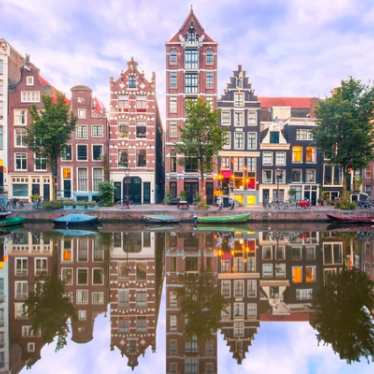

Eurostar destinations
Between Amsterdam's canals, Paris' botanical gardens, Bruges' architecture, and London's royal parks, Eurostar has something for everyone.

The Complete Guide To Travel In France By Train
France has long been a favorite and one of the most popular tourist destinations in Europe . Given that it is the largest country in western Europe, it makes sense to travel by train. The French government has invested in high-speed lines (Ligne a Grande Vitesse or LGV) and high-speed trains (Train a Grande Vitesse or TGV train). There are more than 1056 miles (1700 km) of dedicated high-speed lines as well as thousands of miles of main and smaller lines. Almost the whole country is accessible via French railways. France’s trains are efficient, fast, and will get you where you want to go within the country as well as to or from any neighboring country. If you are a first-time traveler in France, the best way to get around using train travel is through careful trip planning. However, the rail network can be a little confusing, especially when you don’t speak or read French. To help you understand the train system in France, we have created a complete guide to travel throughout France by train.
In this guide, you will find out everything you need to know to create your personal travel plan. We will also provide information on different train companies that operate in France and the types of trains. We will give you valuable tips on buying tickets for the lowest price, navigating the railway system, the benefits of rail passes, and getting around France from Paris. Keep reading The Complete Guide To Travel In France By Train to discover how to travel to France by train.
- Rail Transport Is The Eco-Friendly Way To Travel. Th is article is written to educate about Train Travel by Save A Train, The Cheapest Train Tickets Website In The World .
How To Buy Train Tickets In France
Where can i buy train tickets for my trip to france.
There are several easy and convenient methods or websites for buying French train tickets. They are fairly easy to use, but many of them come with their own quirks and oddities that we need to point out.
Save a Train is a company that digitized and revolutionized rail ticketing . Visit their website, compare train fares, choose the train line, and type of seat you want. You can pay with your credit card or even bitcoin. In case your train ticket’s price drops, the platform will let you know and help you exchange it for a lower price.
W hen accessing the official website of French Railways , you will most probably get redirected to RailEurope.com, which is the official North American partner of French Railways. However, you won’t always find the cheapest fares on Rail Europe. Therefore, you should always pay attention that the cheapest train route fares are on Save A Train.
Amsterdam to Paris Trains
Nice to Marseilles Trains
Rotterdam to Paris Trains
Brussels to Paris Trains
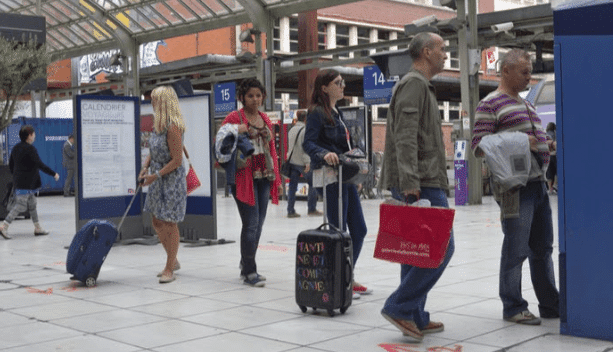
At The Train Station
There are two ways to buy French train tickets at the station – from a ticket window and at the vending machine. English-speakers can purchase them either way, but if your English is not that good and cannot communicate with the person at the ticket window well, the vending machine is your best bet. It is easy to navigate, and you can even change its language settings. Buying tickets from the vending machine requires a Chip & PIN credit card.
How should I collect my online ticket?
There are several methods of collecting your tickets:
- Pick up at the station. To collect your tickets at the station, you can use a booking information number or credit card (the same one you used to buy the tickets).
- Print-at-home tickets. After you receive the electronic tickets, you can print them and show them to the train conductor who checks tickets.
- Electronic tickets. If you don’t want to print your tickets, you can download them to your phone or tablet. You can just show the conductor your ticket via your phone or tablet screen.
- Mailed tickets. Some services offer the option of sending you the tickets via regular mail. However, that is a very slow process, and therefore, not a recommended option.
Should I buy train tickets in advance?
It can be confusing to know which train tickets can be purchased whenever and which should be bought in advance because there are several types of trains and different train services.
Regional/local trains. Regional and local trains connect suburban and regional areas. RER and Transilien connect suburban Paris, while TER trains (Train Expres Regionaux) are regional trains that connect regional hubs with smaller towns. You don’t have to buy regional and local train tickets in advance, just buy them right before departure.
- Intercite trains (IC). An Intercites train is an express train that doesn’t travel on the high-speed lines and connects cities as well as shorter distances. You can purchase IC tickets in advance to get a discount.
- High-speed trains (TGV). TGV trains are the fastest trains in France, and tickets for them are available to purchase 90 days in advance. The prices for them continue to rise as the departure date approaches, so book them early for the lowest price. A ticket purchased 90 days in advance could cost €30. But if you were to buy them a few days before the departure, the ticket price could be as high as €100.
- International trains. The same rules on early booking apply to international trains because these are also high-speed trains.
What are the benefits of rail pass tickets?
There’s a wide range of rail pass tickets you can use to travel throughout France by train. Some of them allow you to travel within France and other European countries, and then there are rail passes that are solely for travel within France. Unlike regular train tickets, rail pass tickets come with some benefits:
- Flexibility. With a rail pass ticket, you get unlimited train travel. Just go to the station whenever you like, stamp the rail pass in the train station office and get on the next available train.
- Discounts. Rail passes typically come with inclusions of discounts for attractions, making them an excellent option for budget travelers . They can be a huge money-saver, which is the main reason people purchase rail passes. Last-minute train tickets can be costly if you don’t book them in advance.
- Convenience. You don’t need to worry about buying a ticket every time you want to take a train, but you must have flexibility since you won’t have a place on every train that you wish.
Which rail pass ticket should I purchase?
When purchasing a rail pass ticket, you can choose between the France Country Pass and Multi-Country Pass (Eurail Global Pass) .
The France Country Pass is your best bet if you are just traveling in France because it provides unlimited travel on the national rail network (including intercity, TER, TGC, etc.). You can choose either 1 to 8 days of travel within a month as well as choose between first and second class. A seat reservation is required in addition to a rail pass for travel on high-speed trains. With this pass, you also receive discounts on various buses, ferries, cruises, hotels, museums, and other attractions.
The Eurail Global Pass is a better option if you also plan to travel to neighboring countries. This multi-country pass provides unlimited travel to 31 different countries in Europe (including France). With Eurail passes, there is no limit to the number of times you can catch a train. Choose either 3, 5, or 7 days of travel within one month or 10-15 days of travel within two months. Remember to make reservations before departure.
Most rail passes are paper-based, and you will need to write the date of your departure before the first trip of each day. Seat reservations for high-speed trains will cost you between €10 and €20 per seat, while international travel reservations range from €35 to €89 per seat (depending on the destination).
AN IMPORTANT NOTE : Rail Pass is only good value for money if you train travel to more than 14 days if you travel for less than point to point train tickets such as what Save A Train is offerings offer better value for your money.
Marseilles to Lyon Train times
Paris to Lyon Train times
Lyon to Paris Trains
Lyon to Avignon Trains
How To Use Train Tickets In France?
On regional and local trains, you might need to travel with a physical ticket. Go to a validation box before your departure to validate or “stamp” your ticket. If you didn’t validate it before departure, wait for the conductor to stamp it while on the train. There are no seat reservations for regional and local trains, so just sit anywhere.
On high-speed trains, there is a specific time printed on your ticket, and the ticket is only valid for that specified time. There is no need to validate your tickets because you have a seat reservation. Make sure that you find the right car and seat (the numbers are written or printed on your ticket).
Paris to Rouen Trains
Rouen to Paris Trains
Paris to Calais Trains
Rouen to Calais Trains
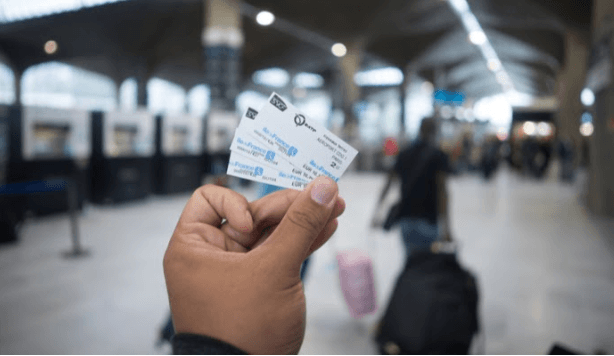
Getting Around France From Paris
When tourists come to France, the majority of them make Paris their starting point for train journeys within the country. When starting in Paris, you can reach almost any destination within the country. These are some of the main destinations served from Parisian train stations.
- Gare d’Austerlitz or Austerlitz Train Station – Bordeaux, Limoges, Poitiers, Toulouse, Biarritz, Tours, and western Spain.
- Montparnase Train Station or Gare Montparnasse – All TGVs to western France (Rennes, Nantes, Brest, Brittany)
- Gare du Nord – Northeast France, Valenciennes, Lille, Calais; Brussels, Cologne, and Amsterdam (Thalys); London (Eurostar).
- Gare de Lyon – South of France. Montpellier, Dijon, Lyon, Clermont-Ferrand, Besançon, Marseille, Nice. Mulhouse in the East of France. Catalunya (Girona, Barcelona), Italy, and Switzerland (Geneva, Zurich).
- Saint Lazare Railway Station or Gare St. Lazare – Le Havre, Rouen , Caen, Cherbourg.
- Gare de l’Est – Nancy. Reims, Metz, Strasbourg, Luxembourg, and Germany.
La Rochelle to Nantes Trains
Toulouse to La Rochelle Trains
Bordeaux to La Rochelle Trains
Paris to La Rochelle Trains
Best Tips For Travel In France By Train
We provide you with a list of great tips that will make your train travel in France more convenient and enjoyable.
- Arrive early at the train station. Be sure to be at the train station at least 20 minutes before departure, or even earlier if you are traveling from huge train stations, such as the Gare du Nord in Paris. For a tourist who doesn’t speak French, there is nothing worse than arriving only a few minutes before departure without having the slightest idea of where to go. Arriving early enough will give you time to check the Departure Board for station information, identify which platform your train is leaving, and find the right platform.
- Never leave your luggage unattended. You might want to walk to a nearby shop for some snacks or water. If you decide to walk around, don’t leave your bag unattended even for a second. Otherwise, you risk having your luggage stolen by experienced thieves. Major train stations in France (including Paris Gare du Nord, Paris Gare de Lyon, and Paris Gare d’Austerlitz Est) have left-luggage lockers in various sizes. Before you enter the locker area , expect to have your bags X-rayed. Once onboard, place your luggage within your eyesight instead of on the dedicated luggage spaces.
- Pack some food. Passengers are allowed to bring their own food and beverage on trains, which is great for long-distance train rides. Some trains have a cafe on board, and most of them have a trolley cart that comes around. Unfortunately, the trolley doesn’t always come, and the cafe may be closed. The food and drinks on board are also more expensive. To save money , pack yourself a picnic with your favorite food before every trip. There are various convenience stores in most train stations where you can buy food and drinks.
- Download a rail planner app to your phone. There is a range of rail planner apps you can install and use to make your train travels more convenient. Our article contains all the info and train schedules for European trains, and some apps don’t require an internet connection. With a rail planner app, you will always know whether your train is going to be late (and by how long) or on time, as well as which platform it will arrive/depart. In major cities like Paris, there isn’t one “main” station, and it is easy to confuse one station for another. With the right app, you will be sure that you get off at the correct station.
- Luggage. When it comes to luggage, you can bring as much as you can carry since there are no weight limits. You can store your bags overhead, behind your seat, or in a luggage rack in your car.
- First-class and second-class tickets . There is not much difference between first-class and second-class cars. However, it is quieter in the first-class, and the seats are a bit bigger. Second-class cars are also perfectly comfortable. It’s worth mentioning that first-class tickets cost about 1.5x more than the second-class fare.
- You cannot refund cheap tickets. Perhaps the only downside to cheap tickets is that they cannot be changed or refunded.
- Self-service machines. When using a self-serving ticket machine, you can choose the English language option, so there’s no need to worry if you don’t speak French.
- Carrying a bicycle. On local and regional trains, you can take a bicycle with you free of charge. TGVs and Intercites de Nuit (overnight trains) on a few routes allow you to take a bike for a small fee (usually about €10). On other TGV trains, you will have to put your bicycle in a zip-up bike bag.
- Making connections. Along the journey, your trip might require you to change trains. Switching trains are typically quick and easy, so there’s no need to worry if you don’t have enough time between trains. A train connection might involve walking to the other side of the platform or the other part of the train station.
- Know the train station names. Large cities have multiple train stations, which can create confusion. If you can’t memorize their names, write them down on a piece of paper, save them on your phone, or use a rail planner app.
- Mind the train strikes. France is known for train strikes, and they always warn the public before going on one. While some trains will still run, strikes are something to pay attention to if you want to avoid major inconveniences.
- Use Chip & PIN credit card. To purchase a ticket on an automated ticket kiosk, you will need a Chip & PIN credit card, so make sure you know your PIN code, although we do not recommend it, since it’s very expensive.
Paris to Marseilles Trains
Marseilles to Paris Trains
London to Paris Trains
Marseilles to Clermont Ferrand Trains

All major cities in France are connected by TGV – the high-speed train network with trains that travel at speeds of nearly 200 mph. At these speeds, all areas of France are within your reach.
We designed this guide “Complete Guide To Travel In France By Train” to give you a strong understanding of how the French rail system works and help you if you are thinking about taking a train but not sure what to do or where to start. Whether you are on a backpacking adventure, a business trip, or on a family holiday, we have got you covered, Save A Train is the place to buy train tickets .
Do you want to embed our blog post “The Complete Guide To Travel In France By Train” onto your site? You can either take our photos and text and give us credit with a link to this blog post. Or click here: https://iframely.com/embed/https%3A%2F%2Fwww.saveatrain.com%2Fblog%2Fguide-travel-france-train%2F%3Flang%3Den - (Scroll down a little to see the Embed Code)
- If you want to be kind to your users, you can guide them directly into our search pages. In this link, you will find our most popular train routes – https://www.saveatrain.com/routes_sitemap.xml . Inside you have our links for English landing pages, but we also have https://www.saveatrain.com/fr_routes_sitemap.xml , and you can change the /fr to /it or /es and more languages.

Liam Mallari
Related posts.

10 Top Destinations With Tennis Fields

Top 3 European Railways Serving Good Food

The Must Do Europe Experiences By Train
Translation flags, search blog, search hotels and more..., destination, check-in date, check-out date.

Recent Posts
- Digital Visa for Freelancers: Top 5 Countries for Relocation
- 5 Platforms To Explore Volunteer Programs Worldwide
- New EU Rail Regulations: Better Protection for Passengers
- 7 Amazing Spring Break Destinations In Europe
- Traveling To Europe During Bank Holidays

Get our Rail Planner app
Plan your trip, get extra discounts, and show your Pass as you go.

Our favorite spring routes
Celebrate spring with these 7 off-the-beaten-path train routes

All about seat reservations
Everything you need to know about booking your seats

Alternatives to Busy Routes
Travel between popular European cities without seat reservations

Through our Chatbot in the bottom right corner.

Ask the Community
Browse questions from fellow Eurail travellers, or ask your own!
- Plan your trip
- Suggested Itineraries
France Itinerary
- Order overview
- Reservations overview
- My Trips & Travelers
- {{translatedTraveler}} {{#promotional}} {{currencySign}} {{standardPrice}} {{/promotional}} {{quantity}}x {{currencySign}} {{finalPrice}}
- Child {{childPasses}}x FREE
- {{translatedPassType}}
- {{translatedValidityPeriodDescription}}
- {{translatedClass}}
- Remove Pass(es)
- {{variant.localizedTravelPackDescription}} {{quantity}}x Free
- {{variant.localizedPassUpgradeDescription}} {{quantity}}x {{currency}} {{price}}
- Your order will arrive by {{expectedDeliveryDate}} 1 x {{currency}} {{price}}
Your cart is empty
Discover the best of French life with this spectacular France itinerary. Start your trip in beautiful Paris and let the train carry you down to the sunny Mediterranean, while cruising through hillside vineyards and endless lavender fields. Reserve a seat on France's TGV high-speed train for fast and comfortable journeys between major cities. Or take it easy and explore the French countryside with RET regional trains, one charming village at a time. When traveling with a Eurail Pass , you simply can't miss out on la belle France .
Itinerary in short
Cities visited in this trip:.
Click here or on the map to view this route in our Trip Planner.
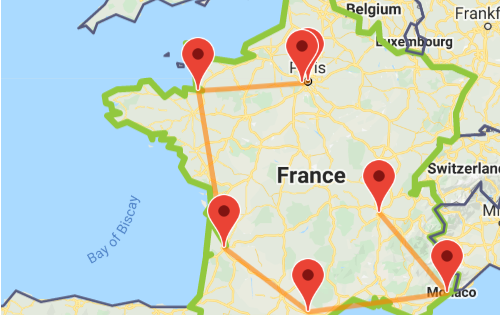
For this itinerary we recommend:
- Eurail pass: France
- Travel days: 7 days within 1 month
Most of the high-speed trains in France, like the TGV and some InterCités, require reservations. These reservations are not included in your Eurail Pass. Make sure to book your seats in advance, there are limited seats available for Eurail Pass holders. It's also possible to avoid reservations all together, simply by taking regional trains .
Travelling to France or Italy with a Eurail Pass?
Let us help you get more out of your trip. Sign up to get discounts and insider tips for your destination , including top attractions, local food and drink experiences and more – all delivered straight to your inbox. Just tell us when your trip starts.
Paris, France
Paris is known as the city of love, and what a lovely place it is! Take a stroll underneath the famous Eiffel Tower and have a glass of wine on the banks of the Seine river. You can do some fancy shopping on the Champs Élysées by day and visit the magnificent Paris Opera by night. The city is a haven for culture vultures, who could spend days exploring the wonderful collection of the Louvre museum . Make sure to visit the art district of Montmartre , where famous painters like Picasso, Dalí, and Van Gogh used to work. Here you'll also find the pristine white Sacré-Coeur Basilica , the second most famous church in Paris, after the hunchback's hideout - the Notre Dame .
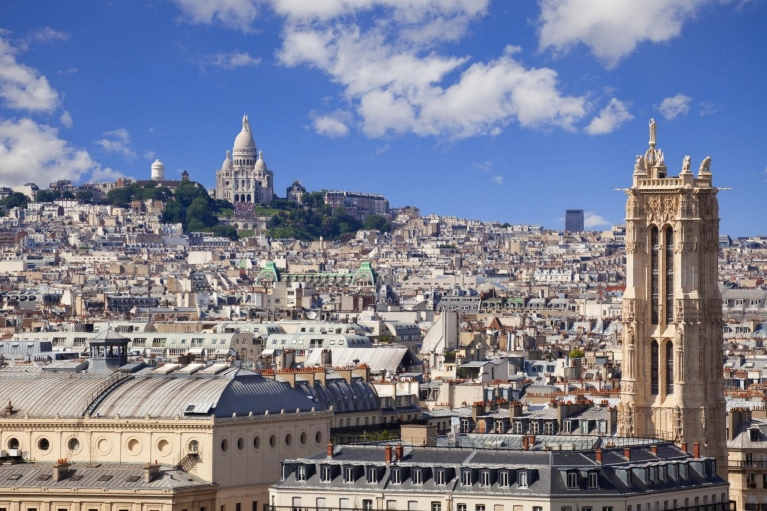
From Paris to Versailles
Travel time:
Gare Montparnasse
Versailles, France
Versailles-Chantiers
For splendor with a capital S, visit the magnificent Palace of Versailles . A symbol of flamboyance, it was the royal palace for two centuries right up to the French Revolution. Take a stroll around the Versailles Gardens to follow in the footsteps of Louis XIV, the infamous Sun King. Inside the palace, you’ll find extravagance in every room. Don’t miss out on the Royal Apartments and the fabulous Mirror Hall (Galerie des Glaces). Visit the Hall of the Battles (Galerie des Batailles) to see France’s military history in paintings and in sculptures.
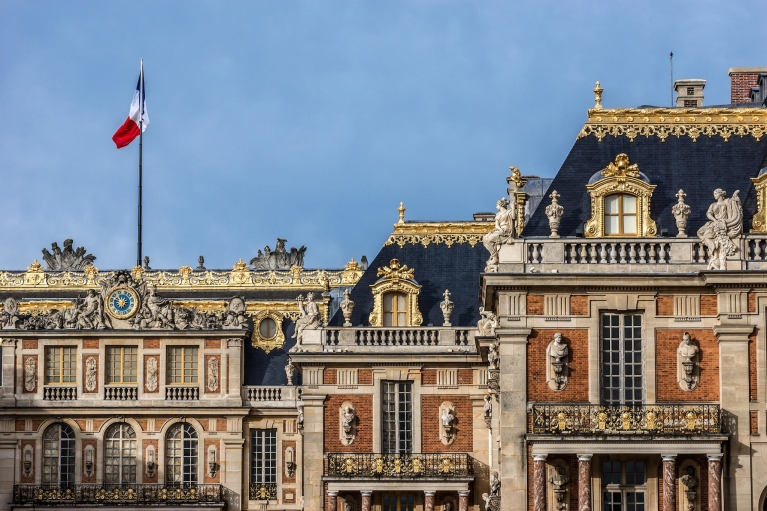
From Paris to Mont St. Michel
Reservation needed:
Reservation required
Rennes, France
Gare de Rennes
Mont St. Michel, France
Mont St. Michel
Mont Saint-Michel, France
An hour out of Rennes, just off the coast of Normandy, you'll find the tiny island of Mont Saint-Michel. It is dominated by the monastery from which it draws its name and was an important place of pilgrimage in medieval times. These days, Mont Saint-Michel is one of the major tourist attractions in France. For centuries, you could only reach the island when the tide was low, but these days a bridge connects the town to the mainland. Take a regional train from Rennes to get to Mont Saint-Michel.
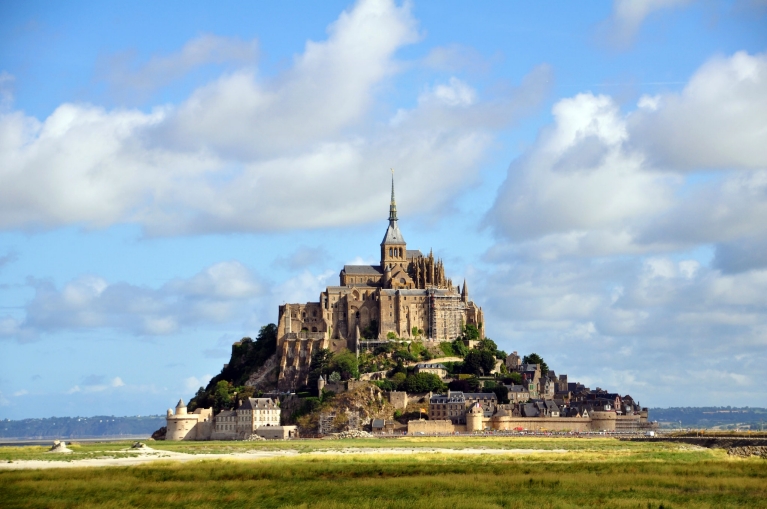
From Mont St. Michel to Bordeaux
Nantes, france.
Gare de Nantes
Bordeaux, France
Gare de Bordeaux-St. Jean
The port city of Bordeaux is France’s uncontested wine capital. You’ll find many luscious vineyards and charming chateaux in the region, which have been producing wine since Roman times. If you're interested in a wine tour , by foot or by bike, beautiful Bordeaux is the perfect place for it! The city itself is rich in architectural highlights from all periods. Climb to the top of the bell tower next to Bordeaux Cathedral (Cathédrale Saint-André) for a stunning view of the city. In the Musee des Beaux-Arts de Bordeaux you can find a large collection of masterpieces by famous European painters.
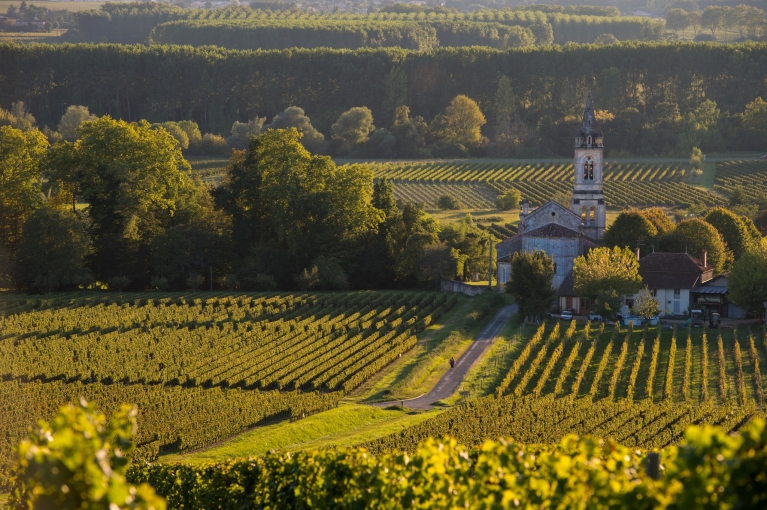
From Bordeaux to Carcassonne
Carcassonne, france.
Gare de Carcassonne
On your way to the sunny Mediterranean, hop off the train in Carcassonne for a sight you'll never forget. The town's medieval citadel will make you believe you’ve stepped out of a time machine. Take a walk through history and visit the Chateau Comtal and the gothic Basilica of Saint-Nazaire . Stand in front of the impressive Narbonne Gate where the centuries look down upon you.
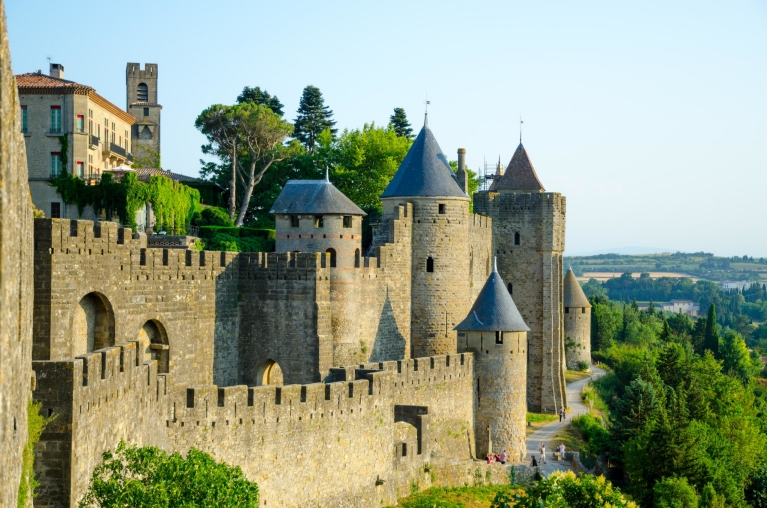
From Carcassonne to Nice
Marseille, france.
Gare de Marseille-Saint-Charles
Nice, France
The city of Nice is located on the Mediterranean coast near the Italian border. It’s one of the most popular tourist cities in France, second only to Paris. Enjoy the gentle sea breeze on the Promenade des Anglais and work on your tan on Nice’s beautiful beaches. Only twenty minutes away from Nice you’ll find the tiny city-state of Monaco . Take a daytrip there to see the yachts in the marina and the Lamborghinis in the streets. If you’re feeling lucky, you can place a bet at the famous Monte Carlo casino.
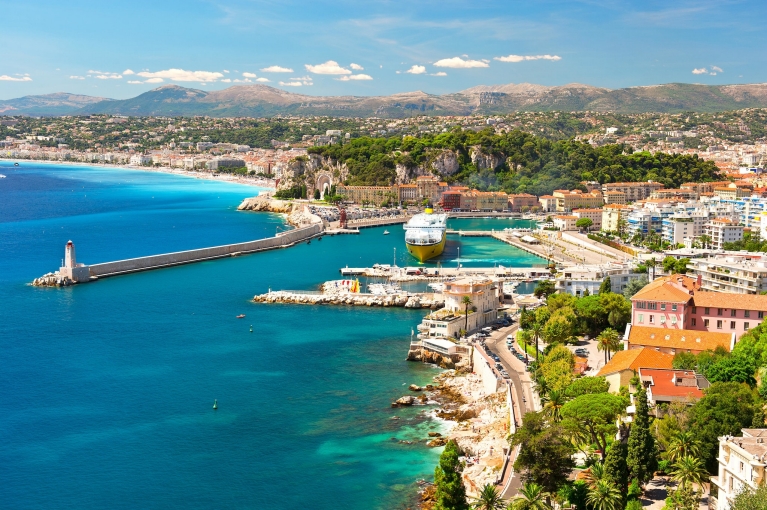
From Nice to Lyon
Avignon, france.
Gare d’Avignon Centre
Lyon, France
Lyon Part-Dieu
If you’re making your way back to Paris, the city of Lyon is the perfect stopover. For centuries now, Lyon has been known as the gastronomical capital of France. Go to a bouchon , a typical Lyonnais restaurant, to taste authentic local cuisine and have a glass of Beaujolais wine. In Lyon's bustling center, you’ll find plenty of interesting sights. Have a look inside the Basilica of Notre-Dame de Fourvière and observe the city from the top of Fourviere hill. If you’re looking for some peace and quiet, visit the Parc de la Tete d’Or , one of the most beautiful parks in France.
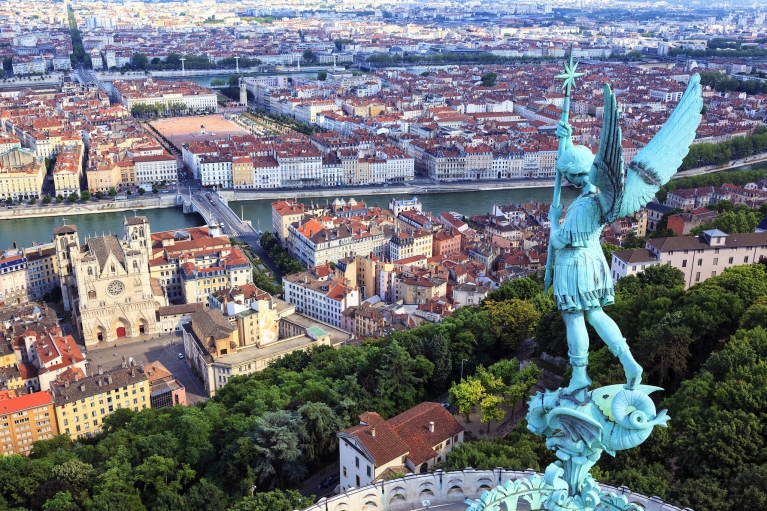
Experience France with the Eurail France Pass!
Change of currency.
You cannot change the currency once you have a Pass in your cart. Remove the Pass, and then change the currency on the website header.
France by Train Itinerary – 6 Ways to Spend 2 Weeks in France by Train
Article written by Elisa - Travel Writer & Local in France This article may contain compensated links. Please read disclaimer for more info.
2 Weeks in France Itinerary by Train – Where to Go?
So you’ve got a trip planned for two weeks in France . Now what? Trying to decide how to visit France in 2 weeks isn’t an easy task. After all, there are so many beautiful places to see that it’s impossible to cover everything in 2 weeks in France.
That being said, you can have a fantastic trip to France and travel back home with the feeling you had a great taste of France.
But where to go? We’ve broken down six ways to spend 2 weeks in France by train, visiting different geographical areas and French regions with no rush. Starting from Paris , CDG Airport , or Nice , and traveling only by train, choose that France itinerary 14 days that tempts you most.
READ MORE – How to Plan a Trip to France
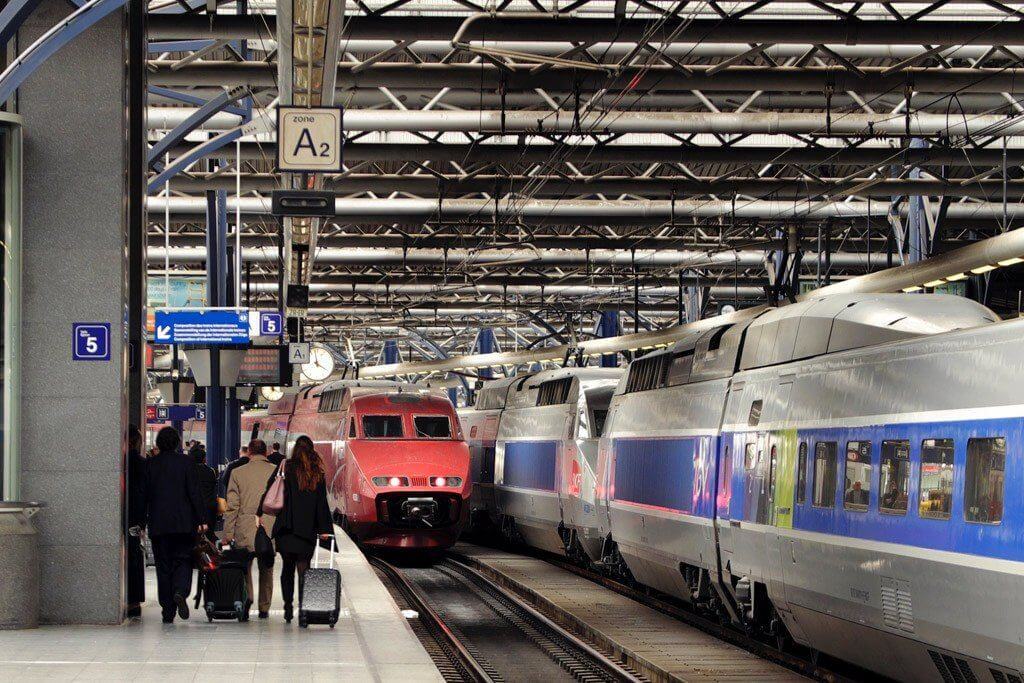
Touring France by Train – Itinerary and Tips
All these proposals are by train, with direct train connections most of the time. French trains are a fun and easy way to visit the country, you can read more in our quick guide to France by train .
Make sure you book the train tickets between the main stops online well in advance: TGV train connections between the main cities sold out fast! For your convenience, we’ve added links to our favorite trusty providers so you can book the train tickets directly from this post.
Most of the itineraries described below start from Paris. You can travel to Paris by train from many European cities in Germany, the UK, Catalonia, the Netherlands, Belgium, Luxembourg, and Italy. If you are traveling to France from overseas, use this link to book your flight tickets to Paris .
And don’t leave home without travel insurance. SafetyWing , our trusted travel insurance policy for long and short trips, covers COVID-19 for new policies purchased, and since April 2021, unplanned quarantine is covered, too. Click here for more info and pricing .
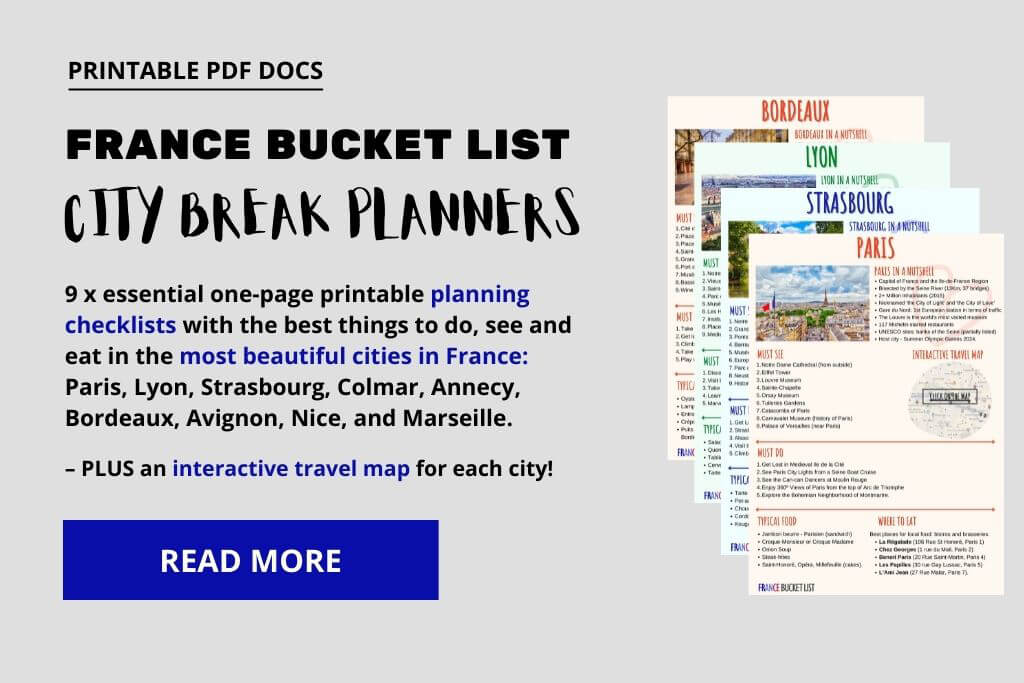
2 Weeks in France by Train Itinerary #1: Paris – Avignon – Marseille – Nice
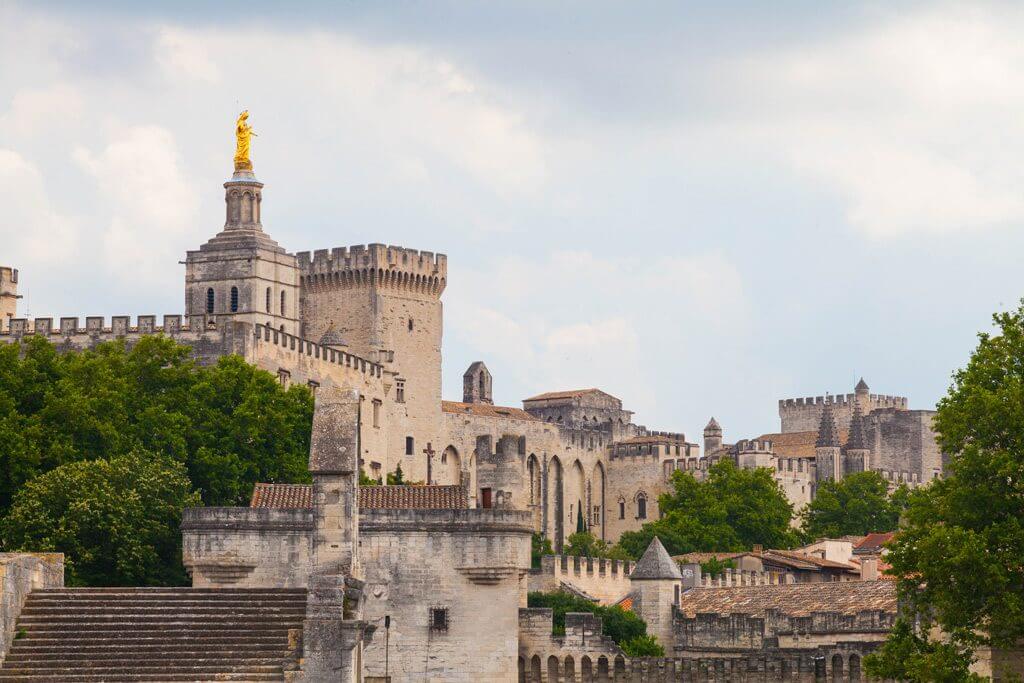
This 2 weeks in France by train itinerary explores the French capital and some of the best places in Provence and the French Riviera in Southern France.
Stop 1 | Paris (4 days)
Paris is a city that really needs no introduction. During your time in the French capital, you will want to visit some of the city’s main sights – perhaps with a couple of leisure strolls around the most picturesque areas – and a day trip to Versailles . If you need some inspiration on things to see and do, this 4-day Paris itinerary will be helpful.
If you count on visiting many museums and Paris landmarks, consider purchasing the Paris Museum Pass for 2 or 4 days . Château de Versailles and the Trianons are included in this Paris Museum Pass.
For your stay in Paris, book at the Hotel Ducs de Bourgogne . Located just 500 meters from the Louvre Museum, this hotel offers its guests great facilities and always gets the best reviews.
Paris highlights:
- Louvre Museum
- Eiffel Tower
- Cruise on the Seine River
- Medieval Ile de la Cité
- Best things to do in Paris
For your day trip to Versailles , check out this Versailles guide , with all the information and our best tips to visit the Versailles Palace, Gardens, and more.
Stop 2 | Avignon (3 days)
Avignon’s main station is Avignon TGV , and it is well connected to Paris by TGV trains. Count on it taking 2 hrs 45 min from Paris Gare de Lyon train station. From Avignon TGV train station, there’s a train shuttle that takes you to Gare d’Avignon-Centre, in the city center, in only 5 minutes.
Click here to book your train tickets to Avignon
After your time in Paris, board one of the first trains to Avignon for a different taste of France. Located in the South Bank of the Rhône River, Avignon was, for a brief moment in time, the center of the Catholic world, as the popes left Rome and came to live in this city. The Papal Palace , built in Gothic style, is a Unesco World Heritage Site and a must-see of Avignon.
In Avignon, Hotel Central has a great and central location near the train station, and it comes with a pleasant front garden and an on-site bar. For something really special, check out Hotel Cloitre Saint Louis Avignon . This hotel is set in a 16th-century building featuring arches and vaulted ceilings, and it has a beautiful garden and an outdoor swimming pool.
Enjoy one day in Avignon . Here everything is within walking distance, and you can easily explore the city while strolling through its small cobblestone lanes. Be sure to visit the Papal Palace and walk through the Pont d’Avignon (the famous bridge) or at least admire it from afar.
Use the second day in Avignon to explore the Luberon . During the lavender season in Provence , take this top-rated lavender tour that includes the 12th-century Senanque Abbey and its surrounding lavender fields , plus the oh-so-pretty village of Roussillon .
Out of this period, we recommend this Best of Provence tour that takes you to the Roman aqueduct of Pont du Gard and some of the most beautiful villages of Provence .
Stop 3 | Marseille (3 days)
Marseille’s main station is Marseille St Charles , and it is well connected to Avignon by TGV trains. Count on it taking 35 min from Avignon TGV train station.
Click here to book your train tickets to Marseille
Marseille is the capital of Provence, a vibrant port city with a strong character and some beautiful places to visit. For your trip to Marseille, follow this Marseille 2-day itinerary or create your own itinerary from this list of best things to do in Marseille .
Marseille highlights
- Stroll around the Old Port, Marseille’s beating heart
- MuCEM, the Museum of the Mediterranean Cultures
- Basilica Notre Dame de la Garde
- Fort Saint-Jean
- Cathédrale La Major
- Le Panier neighborhood
- Best things to do in Marseille
For your stay in Marseille, Hotel la Résidence du Vieux Port is a great choice, with the perfect location – on the banks of the Old Port – and the best view of Marseille.
For your third day in the city, we recommend a day trip to the amazing Calanques de Marseille – Cassis . You can visit some of the Calanques on a day hike or on a boat tour with lunch .
Stop 4 | Nice (4 days)
Nice’s main train station is Nice Ville, and it is well connected to Marseille by TGV trains. Count on it taking 2 hrs 45 min from Marseille St Charles train station.
Click here to book your train tickets to Nice
Nice is the capital of the French Riviera , the glitzy and perfect grand finale for these 14 days in France. Here, you will find beautiful baroque architecture, a picturesque Old Port, some of the best beaches on the French Riviera , and the famous Promenade des Anglais !
Nice highlights
- La Colline du Château
- The Old Port
- The Old Town
- Promenade des Anglais
- Cimiez Monastery
- Matisse Museum
- Chagall Museum
- Best things to do in Nice
For your stay in Nice, book at the Hotel La Pérouse Nice Baie des Anges . This 4-star hotel is nestled into the Colline du Château, and it comes with a great view over the Baie des Anges.
We recommend spending at least two days in Nice . Use the rest of your time in the city to visit other places on day trips from Nice . We especially like Eze Village , but the city-state of Monaco is also a good option.
2 Week France Itinerary by Train #2: Paris – Colmar –Strasbourg – Nancy
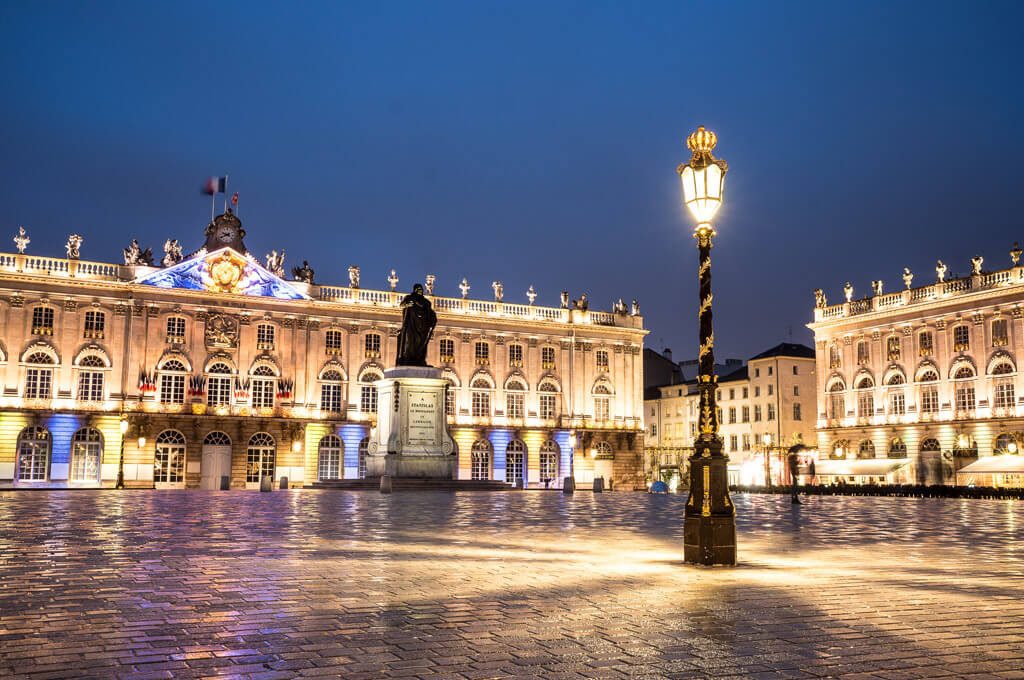
This 2 week France itinerary by train explores Paris and some of the most beautiful places in the Grand Est region (Alsace and Lorraine).
If this is your first time in Paris, you can use this itinerary for 3 days in Paris , which dedicates two days to exploring the Seine’s right bank and one day on the left bank. For the last day, choose one of these day trips from Paris .
If you count on visiting many museums and Paris landmarks, consider purchasing the Paris Museum Pass for 2 days . There are many historical buildings outside Paris included in this Paris Museum Pass; check it out!
For your stay in Paris, book at the Handsome Hotel by Elegancia . Located just 800 meters from the Louvre, this hotel offers its guests great facilities and always gets the best reviews.
Stop 2 | Colmar (4 days)
Colmar train station is connected to Paris by TGV trains or German ICE trains. There are 2-3 direct connections daily, while the rest of the connections imply a change of trains in Strasbourg. Count on it taking 2 hrs 50 min from Paris Gare de l’Est train station.
Click here to book your train tickets to Colmar
This France 2-week itinerary continues in Colmar , one of the most picturesque cities in the Alsace region . Colmar’s Old Town has a beautiful ensemble of half-timbered houses, quaint canals, and many interesting sites. Colmar is also a must of the Alsace Wine Route and an excellent base to explore some of the most beautiful Alsace villages on day trips.
For your stay in Colmar, book at the Hotel Le Colombier , a charming property located in the district of Little Venice, with spacious and stylish rooms, a bar, and a garden.
Colmar highlights:
- The Unterlinden Museum
- The Bartholdi Museum
- Little Venice
- The Food Market
- The Toy Museum
- The Choco-Story Colmar
- Best things to do in Colmar
Spend the first day in Colmar exploring the city – use this list of best things to do in Colmar to create your own itinerary. On day 2, take a day tour to visit other Alsace attractions . We like this Alsace Villages Tour and Wine Tasting , which visits pretty Alsace villages , the medieval Château du Haut-Koenigsbourg , and it comes with some wine tastings at a typical wine bar.
Stop 3 | Strasbourg (3 days)
Strasbourg is connected to Colmar by regional trains (TER) and TGV trains. The Swiss Railways also cover this connection. Count on it taking 33 min from Colmar to Strasbourg.
Click here to book your train tickets to Strasbourg
Strasbourg is the capital of the Grand Est region and the Alsace region. It is an interesting and lively city worth visiting during your France by train itinerary. Strasbourg is world-known for the Strasbourg Christmas Market , the oldest in France! The Old Town boasts some beautiful architecture and one of the best Gothic cathedrals in France.
Strasbourg highlights:
- Notre Dame Cathedral
- The Petite-France, a picturesque neighborhood
- The covered bridges and the barrage Vauban
- Strasbourg river cruise
- History Museum
- The European neighborhood
- Best things to do in Strasbourg
In Strasbourg, book two nights at the Hotel Cathédrale , located just opposite Notre Dame de Strasbourg , with incredible and spectacular views over the cathedral.
For your stay in Strasbourg, check out this Strasbourg in 2 days itinerary , or choose some activities from this list of best things to do in Strasbourg . If you want to see more of the Alsace region, consider one of these day trips from Strasbourg .
Stop 4 | Nancy (3 days)
Nancy-Ville train station is connected to Strasbourg-Ville train station by regional trains (TER) trains. Count on it taking 1 hr 30 min from Strasbourg to Nancy.
Click here to book your train tickets to Nancy
Nancy is one of the most dynamic cities in the Grand Est region. Thanks to a rich past, the former capital of the Duchy of Lorraine boasts today a sumptuous architectural heritage and can rightfully be considered one of the most beautiful cities in Europe.
For a long time, Nancy was considered the European capital of Art Nouveau. The 18th-century Stanislas Square , built in classic and rococo style, is one of the most beautiful squares in Europe, if not the most beautiful one!
Nancy highlights
- Place Stanislas
- Parc de la Pepinière
- Musée des Beaux-Arts
- The Ducal Palace
- Villa Majorelle
- Notre Dame de l’Annonciation Cathedral
For your stay in Nancy, book at Hotel de Guise Nancy Vieille Ville . Set in a historic building in the Old Town, the hotel offers comfortable rooms and beautiful interiors and decorations.
France Itinerary 14 Days #3: Paris – Rouen – Bayeux – Mont St. Michel
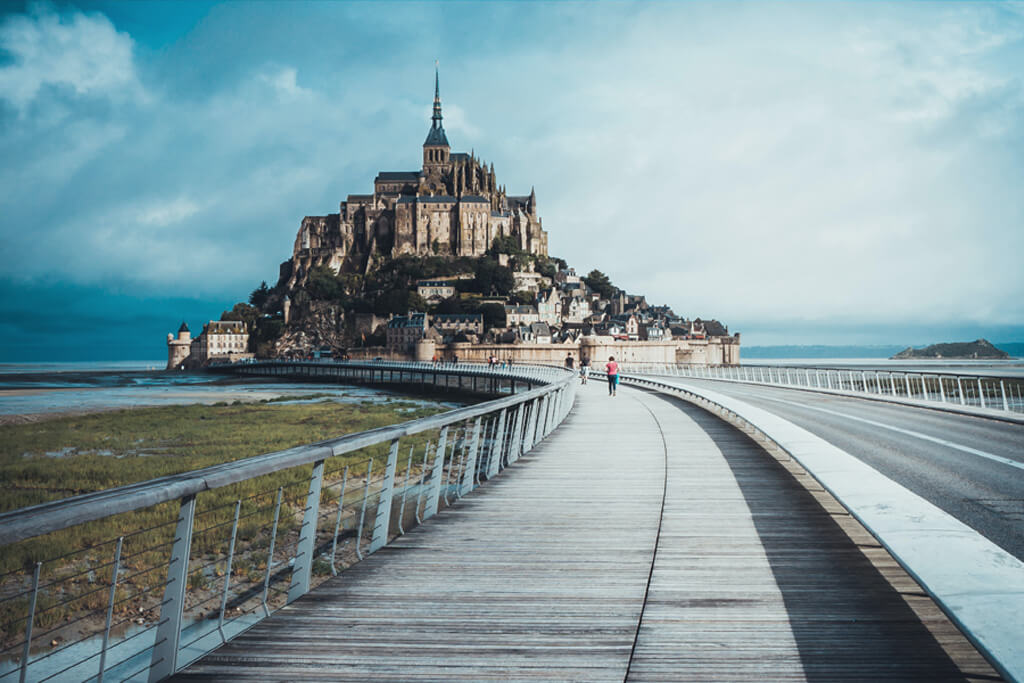
This beautiful France itinerary 14 days by train, travels through Normandy , visiting vibrant cities, historical sites, and the wonder of Western France.
Stop 1 | Paris (5 days)
Start your France train itinerary in Paris , the City of Light. For your stay in the French capital, use the Paris 5-day itinerary , which covers the city’s main highlights and a couple of sites nearby. You can also check this list of the best things to do in Paris and craft your own Paris itinerary.
For your stay in Paris, book at the Hotel de l’Abbaye , in Saint-Germain-des-Prés. Located just 800 meters from the lovely Luxembourg Gardens, this hotel offers its guests great facilities and always gets the best reviews.
Stop 2 | Rouen (3 days)
Rouen’s main train station is Rouen Rive Droite which is well connected to Paris by regional trains (TER). Count on it taking 2 hrs from Paris Saint Lazare train station.
Click here to book your train tickets to Rouen
Rouen is one of the main cities in Normandy , and it boasts the best-preserved medieval center in all of France, with beautiful architecture and picturesque cobbled streets. Nicknamed ‘the City of 100 Bell Towers,’ which dominate the city’s skyline, Rouen is also famous for being the place where Jeanne d’Arc was burned alive.
Rouen highlights
- Musée le Seq des Tournelles
- Historial Jeanne d’Arc – her trial site turned into a museum
- Tour Jeanne d’Arc
- Eglise Sainte Jeanne d’Arc de Rouen
- Old Market Square
- Notre Dame de Rouen Cathedral
- Picnic lunch in the Jardin des Plantes
- Best things to do in Rouen
For your stay in Rouen, book at the Best Western Plus Hotel Litteraire Gustave Flaubert , inspired by the French poet who was born in Rouen. The hotel has a central location in the Old Town and a beautiful terrace from where you can admire Rouen’s famous skyline.
Spend two days strolling around this beautiful city and visiting its main highlights. For your third day in Rouen, take a day trip to Giverny to see Monet’s gardens . You can travel by train to Vernon (40 min) and then jump on a bus to Giverny (10 min, five buses a day).
Stop 3 | Bayeux (3 days)
Bayeux is well connected to Rouen Rive Droite train station by regional trains (TER). All the options include a change of trains in Caen. Count on it taking 2 hrs 40 min from Rouen to Bayeux.
Click here to book your train tickets to Bayeux
The lovely city of Bayeux may not be large, but it boasts plenty of worthwhile sights. Bayeux’s attractive center is dominated by the imposing Cathedral de Notre Dame , built in Gothic style and consecrated with the presence of William the Conqueror. However, a bigger drawcard is the Bayeux Tapestry , a 70-meter-long embroidery that depicts the Battle of Hastings when William the Conqueror invaded England in 1066.
For your night in Bayeux, we recommend Clos de Bellefontaine B&B , a beautiful 19th-century private mansion set in a beautiful 2,000m2 park, with private parking on-site. Clos de Bellefontaine is located 200m from the Bayeux Tapestry.
Bayeux highlights
- Bayeux Cathedral
- The Bayeux Tapestry
- 19h-century Botanical Gardens (labeled Historical Site of France)
- Bayeux Market
Bayeux is also an excellent base to explore the D-day Landing sites of Normandy . This American D-Day Sites in Normandy Tour is a very informative and in-depth tour of the main battle points, and it always gets excellent reviews.
Stop 4 | Mont Saint-Michel (2 days)
The train journey from Bayeux to Mont Saint-Michel is easy to plan. Count on it taking 3 hrs 45 min by regional train (TER) with a change of trains in Pontorson . From Le Mont St-Michel train station, it’s a 7 min walk (570 m) to the abbey.
Click here to book your train tickets to Mont St.Michel
These two weeks in France by train end with a visit to Mont Saint-Michel . This stunning island abbey is also known as the Wonder of Western Europe.
Located at the border with Brittany, Mont Saint-Michel was for centuries one of Europe’s major pilgrimage destinations, and today, 2.5 million tourists from around the world flock here every year. In the bay of Mont Saint-Michel, you will also see Europe’s highest tides!
You can visit Mont St-Michel alone – book your ticket with priority entrance . You can also fly over Saint-Michel Bay to admire the famous Abbey from the sky.
For a more relaxed trip, spend one night on-site in one of the hotels in Mont Saint Michel . Wander around the medieval streets when the crowds are gone and watch the waters rise to inundate the entrance to the island. The hotel Le Mouton Blanc is one of the best hotels in Mont St-Michel, nestled at the foot of the famous abbey. Le Mouton Blanc dates back to the 14th century, and it is perfect if you want to really soak in the island’s past.

14 Days in France Train Itinerary #4: Nice – Cannes – Marseille – Toulouse
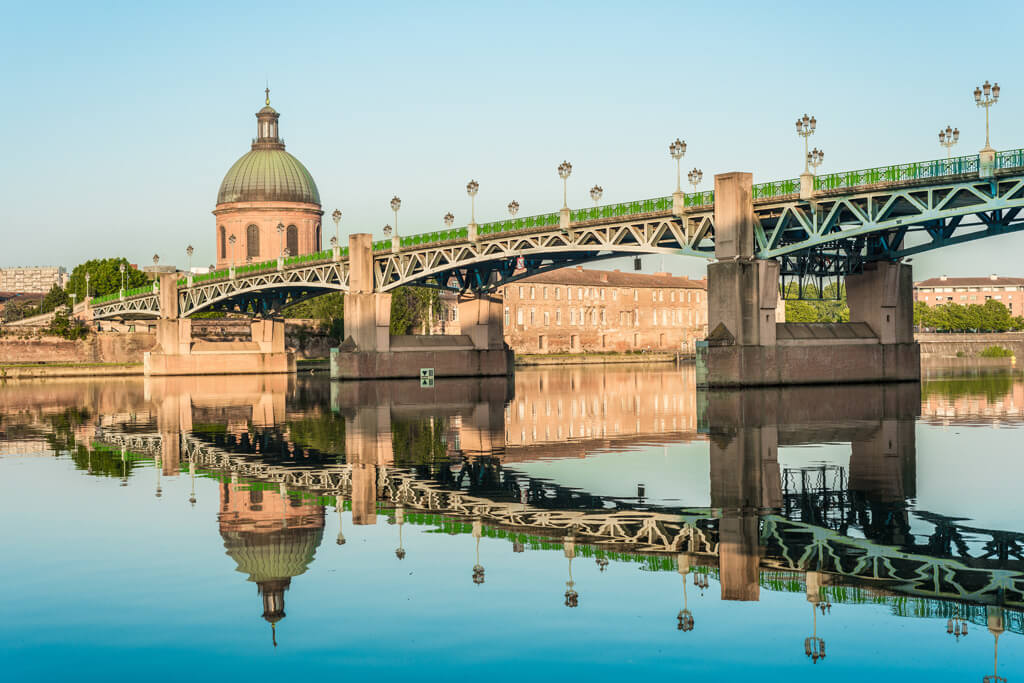
This south of France itinerary by train starts in Nice , and it explores some of the most beautiful places in the regions of Occitanie and Provence-Alpes-Côte d’Azur, with the possibility of many lovely day trips.
Stop 1 | Nice (4 days)
You can reach Nice by train from Paris and many other French cities. Nice Airport (NCE) is the third busiest international airport in France , and it covers many international destinations in Europe, Africa, Asia, the Middle East, and America via regular or seasonal flights – Check out how to travel from Nice Airport to the city .
Click here to book your flight tickets to Nice
Nice is one of the best places to visit in the French Riviera , a must of any trip to Southern France. Spend two days in Nice and use the rest of your time visiting other places on day trips. We especially like Menton , but the city-state of Monaco and Eze-Village are also good options.
For your stay in Nice, book at the Hotel La Pérouse Nice Baie des Anges . This 4-star hotel is nestled into the Colline du Château, and it comes with a great view over the Baie des Anges. Summers in Nice are hot, and you will be happy to book one of the Nice hotels with a pool .
For more information about Nice, jump to the France two-week itinerary #1.
Stop 2 | Cannes (3 days)
Cannes’ train station is well connected to Nice by regional trains (TER). Count on it taking 30 to 40 min from Nice Ville train station.
Click here to book your train tickets to Cannes
Cannes is one of the most glamorous places on the French Riviera, world-famous for its cinema festival. However, Cannes has retained its authentic Provencal charms and offers visitors much more than walking the legendary carpet and social events.
Cannes highlights
- Le Suquet neighborhood
- La Croisette promenade
- Notre Dame d’Espérance Church
- Chic shopping at Rue d’Antibes
- Cannes’ sandy beaches
- Best things to do in Cannes
For your stay in Cannes, the Villa Pruly Hotel Cannes Centre is an excellent option. This 3-star hotel, recently renovated, is located a 5-minute walk from the beach, and it has charming rooms, a lush garden, and a terrace with sun loungers.
Use the first two days in Cannes to visit the city and relax on the beach. On the third day, you can opt for a catamaran cruise with lunch or explore Sainte-Marguerite – the biggest of the Lérins Islands – on a day trip. Located off the city of Cannes, Sainte-Marguerite is the easiest Lérins island to reach by ferry, and it has some lovely beaches far from the Cannes crowds – Book your ferry tickets to Sainte-Marguerite
Marseille’s main station is Marseille St Charles , and it is well connected to Cannes by TGV and regional trains. Count on it taking 2 hrs 10 min from Cannes train station.
The capital of the Provence-Alpes-Côte-d’Azur , Marseille is an exciting and lively city great for culturally curious visitors and nature lovers.
For the list of things to do in Marseille, jump to the France by train itinerary Option 1. For your stay in Marseille, Hotel la Résidence du Vieux Port is a great choice, with the perfect location – on the banks of the Old Port – and the best view of Marseille.
Stop 4 | Toulouse (3 days)
Toulouse’s main station is Toulouse Matabiau, and it is well connected to Marseille by Intercités trains. Count on it taking 3 hrs 50 min from Marseille Saint-Charles train station.
Click here to book your train tickets to Toulouse
Toulouse is the capital of the Occitanie region in Southern France. Nicknamed ‘the Pink City’ because of the color of the stone used for its buildings, Toulouse is a lively city with pretty little squares, elegant private mansions, interesting museums, and beautiful parks.
Toulouse highlights
- Place du Capitole
- The private mansions
- Saint-Sernin Basilica
- The Cité de l’Espace
- Things to do in Toulouse
Toulouse is easy to visit in two days. Use the third day to visit the medieval Cité de Carcassonne . The train journey to Carcassonne takes only 1 hour, and you will love the citadel and the history of the Cathars and the Crusaders behind it.
For your stay in Toulouse, the Ibis Styles Toulouse Capitole has an unbeatable location on the city’s main square, and it offers an excellent breakfast in a pleasant open space.
France 2 Week Itinerary #5: Paris – La Rochelle – Bordeaux – Biarritz
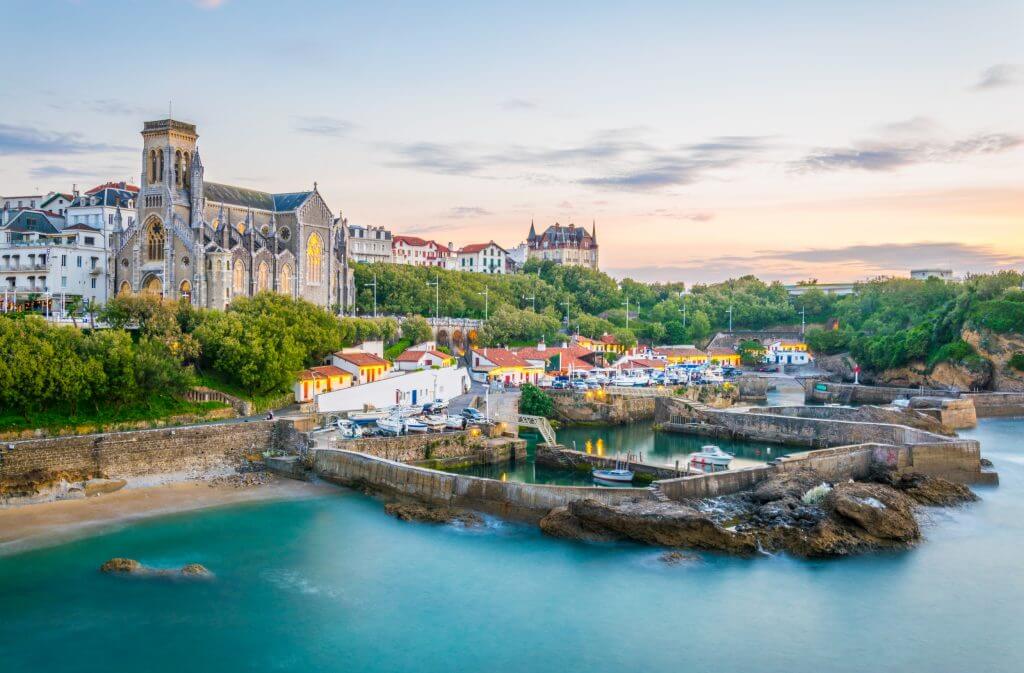
This 2 weeks in France itinerary by train starts from Paris , and it explores some of the most beautiful cities in Western France. Spend 14 days in France, combining sightseeing with relaxing days by the beach.
Stop 1 | Paris (3 days)
For your three days in the French capital, you can use this Paris 3-day itinerary or craft your own itinerary from this Paris bucket list . You can also use this itinerary for Paris in one day plus two of these day trips from Paris by train .
Stop 2 | La Rochelle (3 days)
La Rochelle’s main station is La Rochelle Ville, and it is well connected to Paris by TGV trains. Most of the train connections are direct, while others imply a change of trains in Poitiers. Depending on the train chosen, count on it taking 3 to 4 hrs from Paris Montparnasse train station.
Click here to book your train tickets to La Rochelle
La Rochelle is a historic seaport in the Bay of Biscay along the sandy west coast of France. It is the perfect little city for a relaxing break by the ocean and a great base to explore the area.
La Rochelle’s main feature and attraction is the Old Port , which is central to nightlife and restaurants. La Rochelle is also rich in culture, architecture, and gastronomy.
La Rochelle highlights
- Towers of La Rochelle (14th century)
- La Rochelle Heritage Segway tour
- Local market
- The Aquarium
For your stay at La Rochelle, we recommend Hotel Les Brises . Located on the seafront, just 1.9 km from the Old Port, Hotel Les Brises offers lovely rooms with sea views.
After some busy days in Paris, you may want to take your time to visit La Rochelle and its surrounding area. Use one or two days to visit the city. For the rest of the days, head to Châtelaillon-Plage (15km south) to enjoy the beah. You can also take a sailing cruise to reach the famous Fort Boyard or cross the bridge to Ile de Re for a lovely day in one of the most beautiful French islands .
Stop 3 | Bordeaux (4 days)
Bordeaux’s main station is Bordeaux Saint-Jean, and it is well connected to La Rochelle by regional trains (TER) or Intercités trains. Count on it taking 2 hrs 40 min from La Rochelle Ville train station.
Click here to book your train tickets to Bordeaux
Bordeaux is the capital of the Nouvelle-Aquitaine region. Home to some of the world’s best wines, sites like the Wine Museum or the Cité du Vin are ideal to start your wine explorations. Bordeaux is also known for its beautiful collection of 17th-century private mansions, excellent restaurants and pastry shops, and the world’s largest reflecting pool.
If you count on visiting many museums and landmarks in the city, consider purchasing the Bordeaux City Pass for 2 or 3 days .
Bordeaux highlights
- Port of the Moon (UNESCO perimeter)
- Place de la Bourse
- The Water Mirror
- Cité du Vin
- Garonne River Cruise
- Best things to do in Bordeaux
For your stay in Bordeaux, we recommend the Yndo Hotel , set in a 19th-century private mansion in the heart of Bordeaux, this chic hotel features individually decorated rooms, a fragrance garden, and a sun terrace.
Bordeaux is also a great base to explore the wine country or the Atlantic Ocean on day trips. Spend two days visiting Saint Émilion , a town world-known for its wines, and the Bay of Arcachon with Dune du Pilat .
Stop 4 | Biarritz (4 days)
Biarritz’s train station is well connected to Bordeaux by regional trains (TER). Count on it taking 2 hrs from Bordeaux Saint-Jean train station. Biarritz train station is far from the city center, but it is well connected to the city center by bus.
Click here to book your train tickets to Biarritz
This two weeks in France train itinerary ends in Biarritz , a splendid seaside resort nestled in the Bay of Biscay on the Atlantic coast. You will most likely fall in love with Biarritz, a lively city with magnificent vestiges of the past, exceptional cultural sites, and rich natural heritage.
For your stay in Biarritz, book at Hotel Windsor Grande Plage . Located in an ancient private mansion facing the Grande Plage beach, the hotel is ideally situated close to the main attractions.
Biarritz highlights
- Les Halles (local market)
- Grande Plage with Sainte Eugénie Church and the Basta Rock
- Biarritz’s lighthouse
- Le Rocher de la Vierge
- Views from the Atalaya Plateau
- Best things to do in Biarritz
Visit Biarritz in one or two days and spend the rest of your time visiting other places in the Basque Country. The lovely town of Saint-Jean-de-Luz and the city of Bayonne are easy to reach by train from Biarritz.
2 Weeks in France by Train Itinerary #6: French Wine Regions
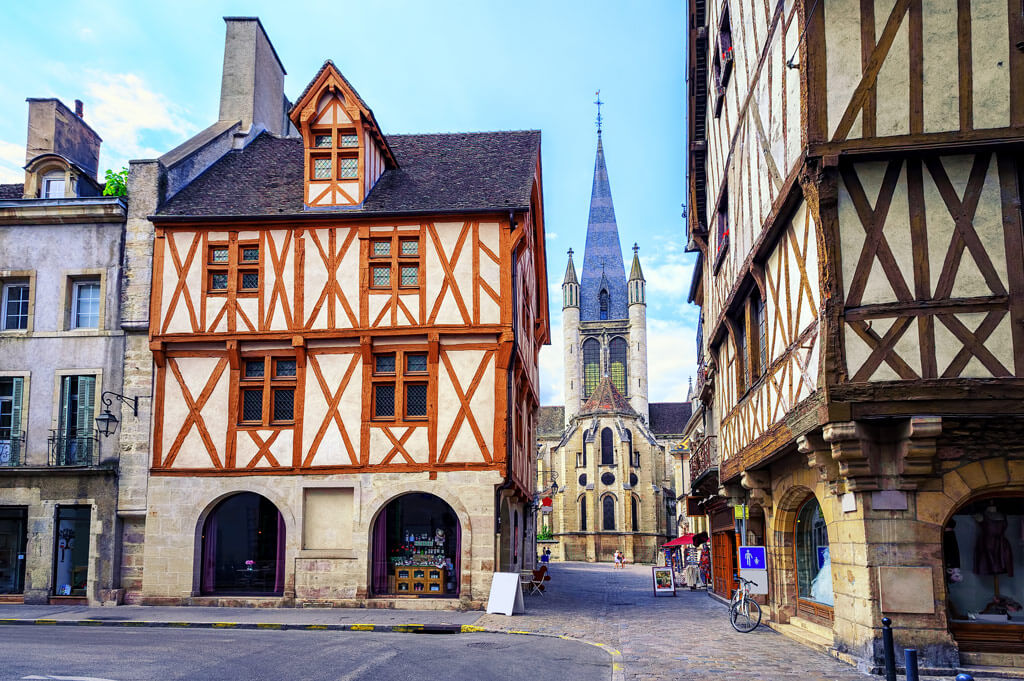
This two weeks in France itinerary explores some of the best wine areas in France . This France train itinerary starts from Paris CDG TGV airport, and it is perfect for wine lovers.
TIP: If you plan to bring a few bottles home (who could resist?!), make sure you pack your wine properly so it arrives safely home!
Stop 1 | Lyon (3 days)
Lyon’s main station is Lyon-Part-Dieu , and it is connected to Paris CDG Airport by TGV trains. Count on it taking 2 hrs from Paris CDG Airpot train station.
Click here to book your train tickets to Lyon
Lyon is a beautiful and cultural city, bisected by the river Rhône from north to south. The city has an interesting Roman heritage and interesting museums, and it is also an excellent place for enjoying good food and wine. The Old Town has a fascinating network of hidden passages, the traboules , that you must explore when visiting Lyon.
For your stay in Lyon, book at Villa Florentine . This former convent, located in the heart of Old Lyon, offers elegant guest rooms and fabulous panoramic views of the city.
For your visit to Lyon, steal this 2 days in Lyon itinerary . or choose your favorite activities from this list of best things to do in Lyon .
If you count on visiting many museums and landmarks, consider purchasing the Lyon City Pass for 1 or 2 days .
Lyon highlights:
- Saint-Jean Cathedral
- Lugdunum – Musée et Théâtres Romains
- Fourvière Hill and Basilica
- Old Lyon and the Saône River Banks
- Parc de la Tête d’Or
- Lyon e-bike tour
- Musée des Confluences
- Best things to do in Lyon
Lyon is an excellent place to explore the Rhône Valley wine region , which produces some of the most renowned wines in France, most notably its full-bodied reds. Visit some wineries in the Hermitage and Côte-Rôtie appellations, meet the winemakers, and sample a variety of Côtes du Rhône wines with this guided tour from Lyon .
Also, Lyon is not far from the Beaujolais Wine Region (wines of Burgundy), which produces vibrant, fruity wines with the Gamay grape variety. The Beaujolais Wine Region also boasts an exceptional heritage of beguiling villages, old churches, beautiful estates, and country roads that complement this rural paradise. Discover Southern Beaujolais with this unusual and gourmet tour with tastings that will show the highlights of this beautiful region, from history to wine!
Stop 2 | Dijon (3 days)
Dijon’s main station is Dijon Ville , and it has direct connections with Lyon with regional trains (TER), and there are also some TGV trains. Count on taking 2 hours from Lyon Part Dieu to Dijon Ville.
Click here to buy your train tickets to Dijon
Dijon is the capital of the Burgundy region and is probably best known for its picturesque architecture and great wine. It was home to the Dukes of Burgundy, and as such, it has a fascinating cultural and architectural heritage. And of course, it also has incredible food, just like the rest of France.
In Dijon, the Grand Hotel La Cloche Dijon is a good option, conveniently located close to all the main attractions.
Visit the Old Town , which became a UNESCO World Heritage site in 2015 and is full of beautiful, half-timbered houses and little squares. Before exploring the surrounding vineyards, we suggest taking this wine master class with tastings to get to know the Burgundy wines.
Dijon highlights:
- Hotel de Ville
- Jardin des Ducs
- Musée des Beaux-Arts, in the Palace of the Dukes
- Notre Dame Church
- Central Market
- Best things to do in Dijon
Dijon is one of the main stops of the Route des Grands Crus , and you can visit some parts of it by train or with a guided bike tour .
Take a train to Beaune (no need to buy train tickets in advance) to visit the famous Hospices de Beaune and do some tastings. Domaine Chanson and Maison Champy offer tours with tastings in English (book in advance).
Stop 3 | Reims (3 days)
Reims’ main train station is Gare de Reims and it is connected with Dijon via regional trains and TGV trains. There is only one direct connection a day between Dijon and Reims , which we recommend taking. Connections with a transfer in Paris arrive at Paris Gare de Lyon and depart from Paris Gare de l’Est , so you will need to take the metro between the two train stations in Paris.
Click here to buy your train tickets to Reims
The capital of Champagne, with many historical gems to visit, is undeniably an important place for French history. Between sipping champagne wine , visiting the main sites, and experiencing a memorable and moving visit to a critical piece of WWII history, there are many things to do in Reims .
For your night in Reims, we recommend the Domaine Les Crayères , an iconic property in the city nestled in a seven hectares park, 300m from the Pommery Champagne House. Inaugurated by the Marquise de Polignac, this wonderful villa belonged to her descendants until 1978.
Reims is famous for its magnificent Cathedral Notre Dame de Reims , which is one of the best Gothic Cathedrals in France . From King Clovis to the French Revolution, almost all the Capetian Kings of France were crowned in the Reims Cathedral.
Reims highlights
- Palais de Tau
- Saint-Remi Church
- Champagne Tasting
- Art-Déco architecture
- Taste the rose biscuits
- Best things to do in Reims
If you go for a champagne tasting, which we recommend!, check out this article on the best champagne houses in Reims . You can also explore the surrounding vineyards by e-bike or take a day trip by train to the champagne town of Epernay (no need to book train tickets in advance).
Stop 4 | Paris (1 day)
Paris Gare de l’Est is one of the capital’s main train stations. Gare de l’Est serves the main cities in Eastern France, and also Germany. Count on taking it 1 hour from Gare de Reims to Gare de l’Est .
Click here to buy your train tickets to Paris
This 2-week itinerary France only spends one night in Paris. If this is your first time in Paris, you can decide to stay more time in the French capital. For only one night in Paris, you can use this one-day Paris itinerary , which covers the main sights. If you have already been to Paris, go off the beaten path and check out a few of these lovely hidden gems in Paris .
For your stay in Paris, book at one of these lovely hotels near Gare du Nord , which is just in front of Gare de l’Est. When you arrive from Reims, avoid the hassle of taking the metro with your luggage. From here, you have direct metro connections to Gare de Montparnasse for the day after.
Stop 5 | Bordeaux (4 days)
Bordeaux’s main station is Bordeaux Saint-Jean and it has fast and direct connections from Paris (count on taking it 2 hrs 30 min from Paris Gare Montparnasse to Bordeaux Saint-Jean . On the way back home, you can take a train from Bordeaux directly to Paris Charles de Gaulle Airport . Bordeaux has some (but not all) direct connections with Paris CDG Airport. Count on taking it 3h 45 m from Paris CDG Airport to Bordeaux St-Jean with direct trains.
This France itinerary 2 weeks ends in Bordeaux , home to some of the world’s best wines. The city is located in the region of Nouvelle-Aquitaine , in Western France, and it is bisected by the Garonne River . Don’t miss Bordeaux’s beautiful collection of private mansions from the 17 century, and of course, its wine shops and bars!
For your stay in Bordeaux, we recommend the Hotel La Cour Carrée Bordeaux Centre , set in a 19th-century private mansion in the heart of Bordeaux. This beautiful hotel features individually decorated rooms, all air-conditioned, and a terraced patio.
For your visit to Bordeaux, we recommend starting with a guided walking tour to learn more about the city’s history. This top-rated Bordeaux wine master class will help you decode the complexity of Bordeaux wines. If you count on visiting many museums and landmarks, consider purchasing the Bordeaux City Pass for 2 or 3 days .
- The water mirror
- Bassin des Lumières
- Garonne River Cruise with a glass of wine
Bordeaux is the perfect base to explore the wine areas of Saint-Émilion and Médoc . There’s a direct regional train that connects Bordeaux Saint-Jean to Saint Emilion (30 min, one way). However, we recommend this Saint Emilion wine tour if you also wish to explore the wine châteaux.
Take this Médoc guided tour with tastings to follow Medoc’s famous Route des Châteaux and learn all about different wine-tasting techniques along the way.
So there you have it, our selection of the best itineraries to spend 2 weeks in France. Which France by train itinerary tempts you most?
Click here for more Travel Inspiration
Back to Homepage
Disclaimer: This article may contain compensated links, meaning we get a small commission if you make a purchase through our links. It costs you nothing more (in fact, if anything, you’ll get a nice discount) but helps us to go on creating incredible French content for you. We trust all products and brands promoted here and would never recommend anything that isn’t of value. Please read disclaimer for more info.
(C) Copyright 2019 - 2024 France Bucket List. All Rights Reserved. Designed & Developed by France Bucket List || Disclaimer || Privacy Policy || Contact |
The Tales of a Traveler
Beautiful Destinations | Luxury Resorts | Travel Tips & Itineraries | Travel Fashion
The Ultimate Guide – France Itinerary by Rail
July 4, 2023
In this blog post, we share some of the best places to visit in France, things to do, and loads of tips that it helps you in planning your Ultimate France Itinerary by Rail.
France is much more than Eiffel Tower and Paris.
View this post on Instagram A post shared by Swati & Sam (@thetalesofatraveler) on Sep 4, 2018 at 3:31pm PDT
In this blog post, we share our France itinerary by rail that will take you to some of the fairy-tale towns, lavender fields, one of the highest dunes in Europe, mesmerizing lakes, stunning canyons, sunflower fields, and a beautiful national park.
It is hard to narrow it down to just a few places when the country has so much to offer.
We also have a few suggestions that you could incorporate if you are planning to do this trip by train like us or by road. Though by car it might take a bit more time in comparison to the train, as France is not a small country like Slovenia, Switzerland, Liechtenstein, or Luxembourg.
France is a stunning country to explore and hopefully, by the end of this post, we can inspire you to plan an amazing trip to France.

BEST TIME TO VISIT TO VISIT FRANCE
France is an all-year-round destination. If lavender fields, sunflower fields, and beaches are part of your France itinerary then obviously from June – August when the weather is at its best, beaches are warm, and days are longer but that’s also the time when prices go up and it’s crowded as well. If budget and crowd are your concern, we would suggest visiting during the shoulder season. We did this trip in the month of July.
- Learn some French words and phrases.
- Greet with a smile and say “Bonjour ” before starting any conversation
- Locals are reserved and might not be over-friendly but they are quite helpful.
- Waiters might not greet you with a smile at some restaurants but don’t be rude to them in return
- Smile and try to interact with locals
Common French Words
Here are some common French words that you will come across. It will come in handy if you can remember these.
- Départ = Departure
- Arrivée = Arrival
- Gare = Station
- Sortie = Exit
- Désolé = Sorry
- Excusez moi = Sorry, Excuse me
- Quai = Platform
Our first and last stop in France was Paris. We flew into Amsterdam as we got a dirt cheap flight and then took a train from Amsterdam to Paris with Thalys .
Paris has been always high on our list and no doubt it’s a beautiful city somehow we felt it was way too crowded when we visited in July but we absolutely loved our time there. We had no fixed agenda and spent our days loitering, devouring Croissants and Macrons, and capturing tons of pictures.
I think the best thing to do in Paris is to Flâner aka “to stroll”. Go with the flow but if you want to know our recommendation then we would highly suggest visiting the following places.

Things To Do In Paris
- Visit the iconic attractions like the Eiffel Tower, Cathédrale Notre Dame de Paris, Louvre Museum, Arc de Triomphe, Basilica of the Sacred Heart of Paris
- Champs-Élysées is an amazing neighborhood to admire the Parisian buildings, shop, and eat.
- Pont Alexandre III
- Don’t miss the Grand Palais and Petit Palais.
- If you love visiting Museums, don’t miss out – Musée d’Orsay, Musée de l’Orangerie, Musée de l’Armée Invalides and Musée de Rodin .
- For Architecture lovers — head to Sainte-Chapelle, Le Moulin de la galette. Get lost in the world of Picasso at Hôtel Salé which houses the largest collection of Picasso’s works in the world.
- Don’t miss the pretty neighborhood — Monmarte .
- Parc des Buttes-Chaumont which is the third-largest park in the city.
- Discover the statues and artwork of the Luxembourg Garden
- Jardin D’erivan
- For Shopping & Food Market – visit Marché des Enfants Rouges (The oldest market in Paris where you can find a lot of options for food and fresh produce) , Galeries Lafayette Haussmann – a one-stop destination for shopping and gastronomical experience, North Marais is also one neighborhood that is being loved by locals
- Offbeat Places – Les Catacombes ( Underground tunnels lined with skulls and bones ), Père Lachaise Cemetery
- Things to Eat – Try all-natural and chemical-free flavors of ice cream at Berthillon , Macaron at the famous Ladurée, and hot chocolate at Angelina’s.
- For views that include Eiffel Tower – Arc de Triomphe, Montparnasse Tower, or Tour Saint Jacques, ( only open to visitors from June to September)
View this post on Instagram A post shared by Swati & Sam (@thetalesofatraveler) on Sep 6, 2018 at 2:42pm PDT
Where to Stay in Paris
We stayed at CitizenM La Defense which is in the La Defense area and is quite close to the metro station but if you are looking for hotels with the iconic view of the Eiffel Tour then below are a few recommendations based on popularity and hospitality –
- Shangri La Hotel
- Plaza Athene
Other Options: Hotels ( Booking.com )
Getting Around in Paris
Getting around in Paris is pretty easy. We used the metro and train services to travel within Paris. The frequency is also very good and you don’t have to be stuck in traffic. There are different tickets for different zones. You can opt for the one based on your preference and stay. There are taxis and buses too that you can opt for .
Alsace Region ( Strasbourg, Obernai, Colmar, Eguisheim )
If you ever google picturesque villages in France, you will find pictures of beautiful towns and villages of the Alsace region popping up on your feed. The half-timbered houses, colorful decorations on the exterior walls of the houses, and prettiness all around will charm you. No doubt the villages have been an inspiration for many Disney movies like Beauty and the Beast and many others.
We stayed in Strasbourg for three days and explored the beautiful Alsace region — Strasbourg, Obernai, Colmar, and Eguisheim. We could not visit the other fairy-tale villages like Riquewihr, Ribeauvillé, & Kaysersberg.

I won’t say that public transportation is great, there are public buses connecting to smaller towns but the timings and the frequency of the bus service are not that great.
Note: It is best to rent a car and explore these places. Another option to explore the Alsace region is you can opt for the Wine Trail which is quite famous and covers a lot of places and also takes you to some of the scenic destinations.
How to Reach – It is just an hour and a half from Paris. We took a fast train from Paris to Strasbourg with our Eurail Global Pass . From Strasbourg, you can either rent a car or travel to other places by train & bus.

Places To Visit/ Things To Do in Alsace Region
Things To Do In Strasbourg
- Visit the stunning Strasbourg Cathedral. There is no escalator so be prepared to climb up to the rooftop for the panoramic views.
- Stroll through the picturesque “Petite France”, one of the prettiest neighborhoods in Strasbourg by the river
- Batorama boat tour
- Palais des Rohan
View this post on Instagram A post shared by Swati & Sam (@thetalesofatraveler) on Nov 9, 2018 at 6:46am PST
Things To Do In Colmar
- Walk around and take in the beauty of the charming village.
- The beautiful “Petite Venice” can’t be missed – Petite Venice is one of the most attractive parts of Colmar. The river Lauch flows past half-timbered houses and bridges and the best way to see these is to take a canal boat tour.
- Visit the covered market of Colmar for some local produce.
- Hop on a tourist train if you fancy one to know more about the village and all the major attractions.
- You can also visit the Museum Musée Bartholdi dedicated to French sculptor Auguste Bartholdi who is the sculptor of the Statue of Liberty in New York.
- You can also visit the Statue of Liberty, yes, there is one in Colmar as well. 😉
Note: If you are planning to visit on Sundays, most of the shops will be closed so be prepared for that but, restaurants & cafes will be open in Petite Venice and public transportation is also not great compared to weekdays. The tourism office closes by 12 pm on Sundays.
View this post on Instagram A post shared by Swati & Sam (@thetalesofatraveler) on Sep 24, 2018 at 2:32pm PDT
Things To Do In Eguisheim
- Wander along the Rue du Rempart Sud
- Visit the Eguisheim Castle & Place du Chateau
- Don’t forget to try the local wine which is quite famous.
- Enjoy your time in the Vineyards
View this post on Instagram A post shared by Swati & Sam (@thetalesofatraveler) on Oct 1, 2018 at 8:17am PDT
Where to Stay in Strasbourg
We stayed at IBIS Strasbourg and explored the Alsace region by train as we had EURAIL Global Pass . We highly recommend renting a car to explore the region if you are planning to do it at your own pace.
Other Options: Hotels ( Booking.com ) Compare Prices before booking.
Provence Region (Provence, Manosque, Valensole )
This region has to be one of our favorite regions in France. The rustic charm of the small towns, the warmth of the locals, and the endless Lavender and Sunflower fields for the company. We can’t wait to go back again this summer and chase the slow life.

Things to do in Provence
- Visit Lavender Fields – Rent a car and visit the famous Lavender fields of Valensole. Read our blog post on where to visit the lavender fields here.
- Visit one of the most beautiful lakes in France – Sainte Croix du Verdon
- Rent an Airbnb and enjoy the rustic charm of the Provence Region
- Visit Provincial villages like Aix, Provence, Sault, Gordes, and Mount Ventoux to name a few.
View this post on Instagram A post shared by Swati & Sam (@thetalesofatraveler) on Jan 2, 2019 at 12:15pm PST
View this post on Instagram A post shared by Swati & Sam (@thetalesofatraveler) on Aug 20, 2018 at 5:59am PDT
READ: BEST LAVENDER FIELDS IN FRANCE
How to Reach –
Plane | You can either fly to Cannes, Marseille, Lyon, or Paris
Train | Eurail Pass or Interrail Pass are good options if you are planning to visit the Provence region. Avignon & Sault are the major stations. Public transportation in Manosque where we stayed was free of cost.
Bus | There are buses connecting to all the major destinations but it is advisable to check the timings beforehand during public holidays and weekends.
Car | You can rent a car and drive. The roads are awesome.
Note: You need to rent a car to explore the region as public transportation is not that great. There are multiple buses connecting cities and towns but always factor in the weekend schedules.
Where To Stay in Provence
We stayed at Manosque instead of Provence because most of the hotels were sold out in Provence and we were not able to find a perfect Airbnb last minute. Manosque is also the headquarters of Lo’ocatainne and is close to the below Instagram spot.

Marseille

A beautiful port city in the Mediterranean region, Marseille will enchant you with its interesting mix of culture, food, and vibes. We were in Marseille for just 2 days. We explored the city and the port area on day one and did all the touristy stuff. The next day we opted for a day trip to Calanques National Park. Unfortunately, we couldn’t do the hike as it was too hot on that day so we opted for a 4-hour boat ride.

Things To Do in Marseille
- Explore Le Panier neighborhood
- Hang out at the Old Port of Marseille
- Visit Cathédrale de la Major (Marseille Cathedral)
- Enjoy your time at La Corniche
- Don’t forget to buy the famous soap of Marseille – Savon – de – Marseille
- Take in the breathtaking view of the city from Notre Dame de la Garde
- Visit Chateau D’If
- Hop on a boat to explore Frioul Islands and don’t miss the stunning Calanques National Park

Read More: Things To Do in Marseille
Marseille is well connected by rail, road, and air with all major cities of France and Europe.
Plane | You can fly to Marseille from Paris / London or any other major hub.
Train | Eurail Pass or Interrail Pass are good options if you are planning to visit multiple cities and countries.
Car | You can hire a car from any city and drive to Marseille.
Where To Stay in Marseille?
We stayed at IBIS which was right next to the train station. It was quite cheap and we just walked into the hotel at night 9 PM without any prior reservations and booked the room for 2 nights. If you follow us on Instagram, you might know that Marseille & Bordeaux were initially not part of our France itinerary, we were supposed to do the French Riviera but we changed our itinerary on the go.
Options: Hotels ( Booking.com ) | Compare Prices before booking. Prefer staying close to the city center if you are planning to explore the city .

Bordeaux is located on the west coast of France and the city is famous for its wine region. It is also called the wine capital of the world. Though our intention of visiting Bordeaux was a little different, we wanted to visit the Dune of Pilat, which happens to be the highest sand dune in Europe. The city is a perfect base for a day trip to the Dune of Pilat and also for numerous vineyard tours.
We were in Bordeaux for 3 days and opted for the Bordeaux city pass. The city pass allows you to use public transportation for free and many attractions like La Cite Du Vin are also included in this pass. The city is known for its splendid 18th-century architecture. If you have time at hand then we would suggest a 4 to 5-day stay as you can visit many UNESCO world heritage villages nearby Bordeaux. We felt that the 3 days we spent at Bordeaux were not enough to explore the city and the neighboring areas.

Things To Do in Bordeaux
- Explore the origins of winemaking and varieties of wine at La Cite Du Vin . A museum dedicated to wines.
- Enjoy your time at numerous vineyards and stay in an Airbnb or Chateau amidst Vineyard for an experience to cherish.
- Porte Cailhau – A 35-meter tall tower from where you can enjoy the panoramic views of the river and the oldest bridge, the Pont de Pierre.
- Water Mirror – A shallow pool of water on smooth granite, across the Place la de Bourse, which creates a beautiful reflection.
- Pont de Pierre – The oldest bridge in Bordeaux over the river Garonne.
- Basilica of St. Michael – A 114-meter bell tower and basilica. The basilica is one of the three monuments accepted by UNESCO as part of the French Pilgrim routes of Santiago de Compostela which is added to the list of World Heritage sites.
View this post on Instagram A post shared by Swati & Sam (@thetalesofatraveler) on Nov 12, 2018 at 2:15pm PST
Read – Things To Do In Bordeaux
How to reach bordeaux – .
Bordeaux is well connected by rail, road, and air with all major cities of France and Europe.
Plane | You can fly to Bordeaux from Paris / London or any other major hub.
Where to Stay in Bordeaux
We stayed at IBIS which is quite close to the train station. As it was a last-minute plan and most of the hotels were sold out, we ended up staying at the IBIS.
You can check on Airbnb or find hotels on Booking.com .

OTHER BEAUTIFUL REGIONS TO VISIT IN FRANCE
You can also include the below regions if you have more days on hand. We are planning to visit a few places this year. We will keep you posted with more details.
- Normandy Region (Mont Saint-Michel, Rouen, Honfleur, Caen)
- French Riveria ( Cannes, Nice, Eze, Menton )
- French Alps ( Chamonix, Annecy, Grenoble, Aix-les-Bains )
- Cities you can include in your France itinerary if you are planning a month-long trip – Dijon, Lyon, and Metz to name a few.
Related Posts
Things To Do in Bordeaux
Things to Do in Marseille
Best Lavender Fields in France
Follow us on Facebook | Twitter | Instagram | Pinterest | and Youtube for more travel stories, ideas, and photos from around the world. Subscribe to travel stories, ideas, and contests: Email Address Consent I give The Tales of a Traveler - Travel Blog India permission to collect and use my data submitted in this form. Give consent that we may collect and use your data. jQuery(document).ready(function() { jQuery('#newsletters-embed3323-form .newsletters-list-checkbox').on('click', function() { newsletters_refreshfields('newsletters-embed3323'); }); jQuery('#newsletters-embed3323-form .newsletters-list-select').on('change', function() { newsletters_refreshfields('newsletters-embed3323'); }); }); Subscribe Now 0% Complete jQuery(document).ready(function() { if (jQuery.isFunction(jQuery.fn.select2)) { jQuery('.newsletters select').select2(); } $recaptcha_element = jQuery('#newsletters-newsletters-embed3323-recaptcha-challenge'); if (typeof grecaptcha !== 'undefined') { var recaptcha_options = { sitekey: newsletters.recaptcha_sitekey, theme: newsletters.recaptcha_theme, //type: 'image', size: (newsletters.recaptcha_type === 'invisible' ? 'invisible' : 'normal'), callback: function() { if (newsletters.recaptcha_type === 'invisible') { $form.submit(); } }, 'expired-callback': function() { if (typeof $recaptcha_id !== 'undefined') { grecaptcha.reset($recaptcha_id); } } }; if (typeof grecaptcha !== 'undefined' && typeof grecaptcha.render !== 'undefined') { $recaptcha_id = grecaptcha.render($recaptcha_element[0], recaptcha_options, true); $recaptcha_loaded = true; } } jQuery('input:not(:button,:submit),textarea,select').focus(function(element) { jQuery(this).removeClass('newsletters_fielderror').nextAll('div.newsletters-field-error').slideUp(); }); $postpage = jQuery('.newsletters-management, .entry-content, .post-entry, .entry, .page-entry, .page-content'); $form = $postpage.find('#newsletters-embed3323-form'); $divs = $form.find('.newsletters-fieldholder:not(.newsletters_submit, .hidden)'); for (var i = 0; i '); } jQuery($divs).wrap(' '); });
Share this:

February 17, 2019 at 7:42 pm
Love France and getting around by train is such a fun way to explore the country. Your yellow dress in the lavender fields is gorgeous. May I ask where you bought it from?
February 18, 2019 at 2:29 pm
It looks and sounds like you both had an incredibly romantic time traveling in France. The lavender fields are incredibly beautiful and oh so photogenic. Good to know that the best time of the year to visit if we want to see the fields is in June – August. Alsace also looks so great and I am loving all the old buildings. Ohhh if those buildings could talk, I could only imagine the stories they would share! And how I would love to explore Bordeaux and wine taste my way around this area. Good to know it’s very well connected by transport in France.
February 18, 2019 at 6:22 pm
Valensole is so stunning! I’ll be heading to Marseille this March, and looking forward to it already! I’ve not yet been to Alsace, or Bordeaux, though I love the wine from this region! I like your hotel options for each place too, they’re great places by the sound of it.
February 18, 2019 at 9:52 pm
I love traveling by train in Europe, but never took a train trip in France. It seems you had an incredibly beautiful time on this trip. I’d love to do this itinerary sometimes in spring. Europe is less crowded at that time of year. I’ve not yet been to Alsace, but I’m hoping to get there next year. Beautiful pictures, by the way (especially the ones at Trocadero).
February 18, 2019 at 10:05 pm
What a great article for planning to travel around France by rail. We have done a little bit of rail travel, but definitely need to see more of France in this way. Aren’t the lavender fields amazing? The colours and your photos are beautiful.
February 19, 2019 at 9:15 am
You have such wonderful pictures out there. No doubt your Instagram fans loved them. France is a beautiful country and the beauty is pretty evident in all your pictures. I have only been to Paris in France. So you know there is so much more to explore. Would love to see the lavender fields and explore Alsace and Marseille. Train is our favorite travel companion in Europe. So France will also be by rail in all probability.
February 21, 2019 at 8:30 am
I love your photographs, or should I commend your Instagram man here 😀 France is such a lovely place especially during the summer, no wonder my beau is bugging me to visit him this summer. And if things went well, I will definitely visit these places you’ve been too!
February 22, 2019 at 3:04 pm
Wow, you people had a fabulous time in France. I love all the pictures here. We could only manage to visit Paris on our trip to Europe. So nice to read about these amazing places in France. The lavender fields look exceptionally beautiful.
July 28, 2019 at 8:50 am
I’d love to visit Paris sometime soon, and your post has put my plans into perspective.
Hope fully, I’d have collected enough funds to visit there by the end of next year.
Love your blog, especially the design 🙂
December 5, 2019 at 6:17 pm
France is one of the most beautiful country i have visited… its the perfect blend of fairytale and high Street fashion… btw did you go to Moulin Rouge?
Leave a Reply Cancel reply
Your email address will not be published. Required fields are marked *
I have read and accepted the Privacy Policy *
Receive news updates via email from this site
The Tales of a Traveler is all about world’s most beautiful places, unique stays, luxury hotels, travel guides and itineraries to make your travel planning easier!
Contact: [email protected]
Get Inspired! Recieve Travel TIps & More!
Subscribe for email updates
Give consent that we may collect and use your data.
WE ARE SOCIAL AS WELL
All Rights Reserved. Photography and written content may not be reproduced without any permission.
Copyright © 2024 The Tales of a Traveler · Theme by 17th Avenue
Privacy Overview
Home Explore France Official Tourism Board Website
- Explore the map
The most unusual train trips in France
Inspiration
Nature and Outdoor Activities

Reading time: 0 min Published on 19 March 2024, updated on 25 April 2024
A far cry from the TGV high-speed train, these slow trains allow you the time to admire the scenery of France from a different angle. Forget timetables and go off the beaten (railway) track, to let your mind escape and unleash your imagination. These quirky little gems of France beckon you for an alternative adventure of the meditative kind.
Heading into the salt marshes of Hauts-de-France
Embark on the Somme Bay Railway for a 27-kilometre trip. This genuine steam locomotive and its old-fashioned carriages will take you around the Bay of Somme and into another era. Between marshland, salt marshes and the seaside resort, this train ride is a great way to enjoy a breath of fresh sea air. You can even opt for a gourmet dinner served on board!
The Loire Valley and the Châteaux of France
The Loire Valley is famous for its abundance of châteaux, but this unique region also boasts a beautiful wilderness. The Loir Valley Tourist Train (TTVL) is on the UNESCO World Heritage list. It has retained all its fifties charm and is an absolute must. Between the wine-growing village of Thoré-la-Rochette and the troglodyte village of Trôo, the 3-hour trip takes you through the Saint Rimay tunnel and past the old wine cellars, Caves de La Rochette. With a bit of luck, you’ll see the TGV Atlantique high-speed train at the exact spot where it broke the world railway speed record in 1990 (513.3 kph).
In the heart of nature in Brittany
Swept by the coastal winds, the Trieux Steam Train offers the unique charm of a ride into yesteryear, aboard an ancient locomotive with seventy-year-old carriages that are fitted with wooden seats. The train travels slowly along the Trieux estuary for about twenty kilometres, between Paimpol and Pontrieux. The varied landscape ranges from ocean to forest, inviting you on an adventure in an unspoilt and authentic region.
Further inland, the Napoleon Express explores across the countryside of Brittany and into the heart of the Blavet Valley, between Pontivy and Lambel-Camors. This train from the period between 1960 and 1980 takes you on a 35-km journey across Morbihan and into the Camors forest. There are a number of stops along the way, so you can pick your destination and plan your day out accordingly.
Heading for the D-Day beaches in Normandy
The 19th-century train of the Eure Valley Railway offers an alternative way to explore between the chalky cliffs and historic beaches of Normandy. From Pacy-sur-Eure station, soak up the enchanting olden-day atmosphere on this trip into railway history on a section of the old line that ran between Rouen and Orleans.
Volcanoes and peaks of the Alps, Auvergne and the Jura Mountains
Auvergne is well known for its mountainous terrain and bucolic scenery. But this region is also dotted with dormant volcanoes. Aboard the Panoramic of the Domes electric train , you’ll climb quickly to the top of the Puy-de-Dôme, the only one of the region’s 80 volcanoes to feature in theUnesco World Heritage register. At an elevation of 1,465 metres, the summit offers a 360° panoramic view over this world-unique geological ensemble.
For fans of mountain landscapes, the Mont-Blanc Tramway is an absolute must. Embark at Le Fayet or Saint Gervais for a ride on the highest rack railway in France. Skiers and walkers can admire the breathtaking Alpine scenery and, once at the top, take to the ski slopes or hiking trails for an experience beyond time.
More than 1,000 metres above sea level, the Coni’fer is the highest railway line in the Jura Massif. At the tranquil pace of bygone days, it will take you across the pastures and forests of Haut-Doubs. The railway, which doubles up as an art exhibition venue, has just celebrated its 30th anniversary. A great opportunity to discover the unusual story behind this train from yesteryear.
© Benjamin Becker Jura Tourisme - The Hirondelles Railway
The Hirondelles Railway offers one of the most beautiful train rides in France. It crosses Jura, from Dole to Saint-Claude. Open both summer and winter, the 120-kilometre itinerary between mountains and plains features a succession of viaducts. Passengers can enjoy some stunning views of this mountainous area.
Exceptional panoramic views in the Basque country
To see the Basque Country from above, catch the Train of La Rhune to climb slowly to the top of this legendary mountain. You’ll travel across the mountainside, between forests and ravines, to admire a 360° panoramic view from the top, over the Atlantic Ocean on one side and the Spanish Pyrenees on the other.
The Pyrenees are home to Europe’s highest narrow-gauge railway, the Little Train of Artouste . Reaching an elevation of 2,000 metres, the itinerary begins with a 15-minute ride in a gondola lift to reach the departure station in Pyrénées Atlantiques. The 55-minute trip that follows reveals views of the Ossau Valley like you’ve never seen it before.
Varying landscapes of the Pyrenees
The ‘ Train Jaune ’, in Pyrénées-Orientales is a historical and very special train that takes you into the Catalan mountains. Explore the regional nature park on one of Europe’s highest railways, from the thermal baths of Llo to the ski resort of Font Romeu, via the Spanish town of Puigcerdà.
- Again in Pyrénées-Orientales, another train stands out from the crowd by its colour: The Red Train . The 60-kilometre itinerary offers the ultimate change of scene, with commentary along the way through the Agly Valley and the Upper Aude Valley. If you’re feeling energetic, take the railbike, a light railway vehicle propelled by your own pedal power. This cross between train travel and cycling offers an alternative transport experience that’s both original and eco-friendly.
Outstanding views in the Dordogne Valley
The Dordogne Valley is packed with charismatic villages and sites that have some amazing stories to tell, such as Rocamadour, Collonges, Sarlat, Lascaux and the Padirac Chasm. This atypical valley is truly a jewel offered to nature lovers, with caves, chasms and other must-see sites. The best way to explore it is, without a doubt, on the Steam Train of Martel . A steam train or a powerful diesel locomotive will take you along a corniche with an 80-metre drop. This fabulous trip through the lush green valley will have you daydreaming as you gaze at the panoramic views that unfurl before your eyes.
Deep into the Lorraine forest
In Moselle you can catch the Forest Train of Abreschviller , for a unique ride on a steam train, deep in the forest. On this 12-kilometre trip you’ll visit the Sarre Rouge Valley to admire its natural riches. Various activities are available to keep the children entertained, as well as their parents.
The viaducts and turquoise waters of Provence
To admire the Provence scenery of lavender fields, vineyards, olive groves and pine forests, take a ride on the Train des Pignes whose beauty transports you before you’ve even boarded! This vintage steam locomotive pulls carriages that are more than a hundred years old. The trip is slow-paced and beautiful too, lasting nearly 3½ hours between Digne-les-Bains and Nice, via some lovely authentic villages.
The Blue Coast Train , between Marseille and Miramas, is owned by the SNCF (French national railway company). Between the azure-blue of the coves and the turquoise waters of the Mediterranean, the itinerary unfurls in an alternation of viaducts, stations, amazing panoramic views and other wonderful surprises.
The French Riviera in the South of France is the stuff of dreams, with a mild climate and turquoise-blue coves that make it a dream destination. Fancy an experience that’ll take your breath away? The Train of Wonders takes you on a guided tour into the heart of the region inland from Nice and Menton. Deemed to be one of the most beautiful train journeys in the world, this itinerary takes you to see the Roya Valley which extends between the Mediterranean coast and the Mercantour National Park. This trip has plenty of surprises in store. Starting at sea level, the train reaches an elevation of 1,000 metres after travelling just a hundred kilometres or so. The Train of Wonders continues to operate in winter, when passengers can admire the snow-covered landscape.
Breathtaking views in Corsica
Nicknamed ‘U trinighellu’ by the locals, the Balagne railway in Corsica is a train like no other. Firstly, it offers a shuttle service serving the local beaches. So stop for a dip in the warm turquoise waters of the Mediterranean, then hop back on to visit L’Île Rousse and Calvi! This train is an ode to life in the slow lane, with some outstanding views of this incredible island.
Further reading : Nos itinéraires coups de cœur pour parcourir la France à vélo Se déplacer en France en mobilités douces

By Hugo Garcia
Hugo is a qualified sociologist who writes for a variety of different media. He is a true all-rounder whose experience in the field gives substance to his articles.
8 Luxurious Boutiques in Paris

Corsican Cuisine

Destination: Etretat

Ice Skating Rinks

Naturist places in France

PORT OF BREST

PORT OF HONFLEUR

SETE, FRANCE, YOUR NEW DESTINATION

- International edition
- Australia edition
- Europe edition
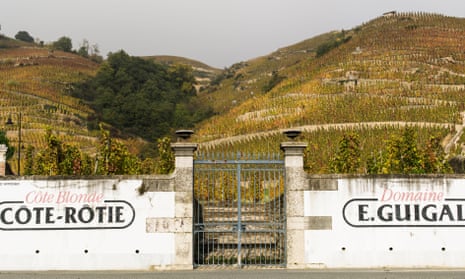
Rail route of the month: vines on the line from Avignon to Lyon, France
Our slow travel expert takes the train through the Rhône’s wine country, hoping for grand cru views and a glass of Condrieu
T rains and wine make natural partners, be it a glass of crisp white over a leisurely lunch in a restaurant car while cruising through the Alps or a rail itinerary that meanders through a region noted for its fine wines. Many of Europe’s most prized wine regions lend themselves naturally to exploration by rail.
Take the train from São Bento station in Porto to Pocinho, for example, for fine views of the estates that have underpinned the port trade. Other classic European wine regions where trains weave through vineyards include Tokay in Hungary, Germany’s Moselle valley, the Ebro valley in Spain (for fine Rioja) and Switzerland’s Lavaux region where one grand cru white, made from Chasselas grapes, even plays up the rail connection: the Massy family’s classy Dézaley is called Chemin de Fer .
North from Avignon to Valence

It is a tempting rail-wine connection that brings me to Avignon on a damp early spring day, to explore the Rhône valley. Few travellers are around. Avignon Centre railway station looks handsome with its yellow and white walls. This is the jumping-off point for the regular slow trains to Lyon (a journey of two and a half hours). This regional rail route once carried grand express trains, but no longer. The TGVs dash north to Paris on a high-speed line that tracks well east of the Rhône valley. Only regional trains stick to the old valley route, along the way taking in a roll call of grand appellations that line either side of the Rhône as one follows the railway upstream from Avignon. The railway passes Châteauneuf-du-Pape and Hermitage, while later in the journey there are fine views across the river to Condrieu and Côte-Rôtie.
Slipping out of Avignon Centre on the blue-and-white train bound for Lyon, there are views to the left of the city’s ancient walls, then we cross the Canal Crillon. We have barely left Avignon’s suburban sprawl when we pause at a station called Sorgues-Châteauneuf-du-Pape. Not a vine in sight, but a few moments later, the distinctive low hill which is home to Châteauneuf-du-Pape’s classiest vineyards is visible away to the west, while on the other side of the railway the rough Provençal countryside stretches east to the Vacqueyras wine district and, in the distance, the hill country around Gigondas and Beaumes de Venise, the latter noted for its aromatic Muscat.

Our train loops slightly west to serve Orange, after which we have our first real encounter with the main channel of the River Rhône. It isn’t all pretty – we pass cement works, graveyards of abandoned cars and nuclear power plants.
Halfway through the journey, I stop for lunch in Valence where the elegant design of Valence Ville railway station recalls the architectural idiom of the Grand Trianon at Versailles. I know this route well, and in either direction a stop at Valence is mandatory. Coming from the north, it’s the first town that embodies the energetic vitality of the scented south of France, and heading north it’s a chance to bid the south adieu . And embrace the famous vineyards that lie ahead.

Beyond Valence, the valley sides close in and the countryside, now a little greener, hosts vineyards from which come powerful red wines made from the Syrah grape, and many opulent whites, the best of which reflect the finesse of three very contrasting grapes: Marsanne, Roussanne and Viognier. The latter brings the prospect of a heady perfume of orange blossom, apricots and almonds.
Northern Rhône vineyards
Leaving Valence, there’s a view over the Rhône to Cornas, renowned for its assertive, peppery reds. Then we cross the River Isère and soon we are cruising past a litany of celebrated vineyards. Signs mark the prized parcels of land owned by illustrious winemakers like Chave, Chapoutier and Jaboulet.
There’s a neck-craning view of a chapel high on a slope above the railway. Not any chapel but the one which dominates a parcel of land in Hermitage known as La Chapelle, associated with revered red wines that develop gently over decades in the bottle.
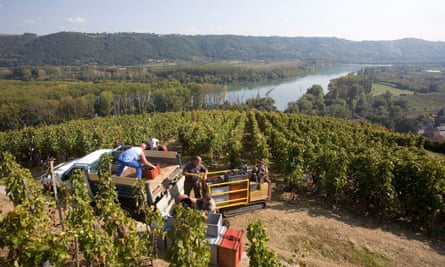
To the left, the slow-flowing waters of the Rhône and to the right the gentle slopes draped with vineyards of the Crozes-Hermitage appellation. Across the river is Saint-Joseph. But the best is yet to come. For lovers of the Viognier grape, and I count myself among their number, the high point of this journey is Condrieu and Chateau-Grillet. The steep slopes of both appellations are visible on the other bank of the river as we approach the station at Saint-Clair-Les Roches where I stay overnight in the Hotel Bellevue (doubles from €115, room only).
It wins no prizes for architectural ambition, but among the hotel’s many redemptive qualities are a Rhône view as fine as its name implies, good food, and access via a bridge over the river to the Condrieu vineyards on the west bank.

“We call that Guigalville,” says the waiter at the hotel gesturing to the vineyards over the river and referring to the family who have done so much to promote the wines of Condrieu and neighbouring Côte-Rôtie. So the next day, I take a local bus to Ampuis to visit the Guigal estate and taste some local wines.
The Condrieu is a star, with its perfect balance of acidity and fruit. Then it’s back to Saint-Clair and the onward train north up the valley to Lyon. There’s a tantalising view across the river to the turreted Château d’Ampuis, home of the Guigal family. Our train pauses at Vienne, a riverside town famous for its Roman remains. Then we run non-stop to Lyon, a hop of 20 minutes, passing through Seyssuel where ambitious young winemakers are buying up land amid rumours that its wines could offer all the finesse of Condrieu and Côte-Rôtie.

Now the last of the vineyards are gone and we enter Lyon, passing factories and oil refineries, power stations and sewage works. I note that the train I am on continues beyond Lyon to Mâcon, giving the option of extending my wine tour north to include Beaujolais and the southernmost portion of the Mâconnais.
I am tempted, but Swiss whites beckon, so I alight at Lyon and make tracks for the Lavaux region on the north side of Lake Geneva (Lac Léman) where I have an appointment with a glass of Luc Massy’s grand cru Dézaley Chemin de Fer.
Travel details
There are 11 direct regional trains each weekday from Avignon Centre to Lyon. The service is less frequent at weekends with nine direct trains on Saturdays and seven on Sundays. The one-way fare from Avignon Centre to Lyon Part Dieu via the Rhône valley is €40.70. Purchase at the station before departure or in advance via Rail Europe for £36 (tickets priced in sterling no longer carry a booking fee).
Nicky Gardner lives in Berlin. She is co-author of Europe by Rail: the Definitive Guide (Hidden Europe, £18.99). To support the Guardian and Observer, order your copy of the 17th edition from guardianbookshop.com . Delivery charges may apply.
- France holidays
- Rail journey of the month
- Wine holidays
- Food and drink
- Europe holidays
- Public transport trips
- Rail travel
Most viewed

Europe's Most Spectacular New Hotel Is Set in a Former WWII Railway Station
High in the mountains between Spain and France, a long-neglected train station has become an opulent hotel.
A few years ago , I was flicking through a magazine when I saw a photo essay about abandoned train stations. They were images of sublime squalor. The grand Greco-Roman columns of Michigan Central Station in Detroit were covered with graffiti. The Art Deco posters on the walls of the St.-Martin Métro in Paris were gradually peeling away. But the most haunting place in the collection was Estación Canfranc, high in the Spanish Pyrenees.
From the outside, this 790-foot-long Beaux-Arts palace looked like it had been transplanted from a fashionable Parisian boulevard. When it was completed in 1925, Canfranc was the second-largest rail station in Europe, after the one in Leipzig, Germany. Inside, the structure had cathedral-like proportions, as though it had been erected not merely to facilitate train travel but to worship it. Huge arched windows let in shafts of beneficent light. The ticket counter could almost pass for an altar. But by the time the photo essay was published, the congregation was long gone. The building closed in 1970 and had been empty ever since. Its vaulted ceiling was slowly moldering, and the floor was covered in dust and debris.
Related: This Little-known Wine Region Is a Hidden Gem of Spain — and It Has a Gorgeous New Luxury Hotel
Now the travelers are back. One recent afternoon I arrived in Canfranc to check in to the station, which has been transformed into one of Europe’s most spectacular new hotels. Its scale and grandeur are incongruous, given that Canfranc is a remote mountain hamlet near the border of Spain and France. The town, which sits in a narrow valley enclosed by steep, forested slopes, has a population of only 600.
After the station closed, Canfranc lured only a trickle of adventure lovers, drawn by glorious summer hiking and two tiny ski resorts farther up the valley. But today, the hotel is a destination in itself. The renovation is the work of the Barceló Hotel Group, who took over the derelict building in 2021. The Spanish firm has given the place a train-centric revamp that balances old-world glamour with contemporary style. As I checked in, I stood gaping at the old ticket hall, which now serves as the hotel lobby. Its polished wooden beams shone with a deep luster, and the ornate plasterwork on the walls was as clean and white as confectioner’s sugar.
"When it was completed in 1925, Canfranc was the second-largest rail station in Europe, after the one in Leipzig, Germany. Inside, the structure had cathedral-like proportions, as though it had been erected not merely to facilitate train travel but to worship it."
In the station’s locomotive heyday, its north and south wings were occupied, respectively, by French and Spanish customs officials. Now the southern wing houses a bar and restaurant tricked out in Art Deco shades of green and gold; the bar is illuminated by pendant lamps that resemble train wheels. In the rooms, antique station windows have been refurbished as quirky wall art.
Yet the hotel’s brand of nostalgic luxury is only one reason to visit; the other is its history. The village of Canfranc may be tiny and remote, but its border location has given it an outsize strategic importance for centuries. The evidence is everywhere. After I arrived at the hotel I headed outside and looked north up the valley. Perched on a ridge high above me was a 16th-century fortress that the Spanish rebuilt after Napoleon’s invasion in 1808; they wanted to defend against another possible incursion through this mountain pass. At the other end I could see concrete bunkers, erected for the same reason by the Franco regime in 1944. As well as being a luxurious stop on the route between Paris and Madrid, the station has played a prominent role in the valley’s history of intrigue and espionage.
Later that afternoon, I met with Ana Badino and Marcelo Boveri, an Argentine couple who moved from Madrid to the Canfranc region in 2020 to enjoy a quieter life in the mountains. Since then, they have immersed themselves in the station’s extraordinary history and now run tours around the valley.
Until the 20th century, this corner of northern Spain was seen as poor and backward. The main economic activity was smuggling: alcohol and cigarettes went from Spain to France, and clothes, clocks, tea, and embroidery went the other way. But the locals wanted more opportunity than contraband provided, and the government wanted to take this roguish part of the country and turn it into a legitimate, modern commercial hub. So in 1912, the government commissioned the station as a statement of ambition and advancement. Fernando Ramírez de Dampierre, a Madrid-born engineer, was hired to design it. Both the president of France and the king of Spain were present at the inauguration ceremony in 1928.
For a few years, life in Canfranc was full of commercial activity. Daily trains from Portugal delivered port wine, cocoa, and coffee imported from Brazil. Industrial goods like coal and aluminum arrived from France. Badino and Boveri pointed out the rusted, obsolete cranes behind the station; they once loaded and unloaded this cargo.
But when war broke out in 1939, everything changed. As Bodina and Boveri explained, the head of the station’s French customs department was a man named Albert Le Lay. He was more than a mere border official. He was a vital member of the French resistance who used his position at the station to help Jews and allied fighters fleeing persecution and capture in Germany and Vichy France. Now remembered as an Oskar Schindler–like figure, Le Lay provided these fugitives with forged papers to help them cross into Spain and on to Portugal. From there they traveled to safety. The identities of Le Lay’s beneficiaries are hard to trace, but according to some historians, those who passed through Canfranc included Max Ernst and Peggy Guggenheim.
Bodina and Boveri led me a little farther down the valley, which is still crisscrossed by old railway lines. Eventually we came to a row of derelict warehouses, their heavy wooden doors bent and buckled from decades of neglect, their roofs full of holes where high winds had ripped the tiles away. Through the gaps we peered into the dark interiors. In one of the buildings, in 2000, a cache of Nazi paperwork was found that listed items the Germans had moved through Canfranc after the Gestapo occupied the station in 1942. They included looted gold bars and opium.
His job as a customs official gave Le Lay the cover he needed to continue his resistance work. He would receive information from agents masquerading as passengers as they arrived at the station. From there, messages were transported by a network of spies down the train line to Zaragoza, the nearest city. Canfranc, then, was a crucial node in a pan-European network of spies that helped disrupt the German war machine.
Like many travelers to Canfranc today, I arrived via the airport in Zaragoza, the regional capital. Zaragoza is an underrated destination compared with Barcelona, Madrid, and Seville. Following the Umayyad invasion from North Africa in the eighth century, it became a major city in the north of Muslim Spain. At its center is a Moorish fortress, the Aljafería Palace, which is built in a magnificent architectural fusion of European and Islamic styles known as Mudejar. On the bank of the Erbo River, which courses through Zaragoza, stands a monumental Baroque basilica whose central dome is surrounded by four towers. But for me, the biggest lure was the opportunity to admire the art of the area’s most famous son, Francisco Goya.
After spending the night at the NH Collection Gran Hotel de Zaragoza, I walked over to the Goya Museum. It’s a small institution that packs a big punch. The star attractions are Goya’s etchings, displayed in a large, crepuscular room that protects these delicate artworks from light damage.
Goya’s etchings rank among his strangest and most personal pieces. “Los Caprichos,” a series of 80 prints, is a pitch-black satire on religious hypocrisy, corruption, and superstition. These images feature grotesque goblins dressed as clergymen; a donkey in an aristocrat’s silk coat studying his family tree; a woman pulling teeth from the mouth of a hanged man to be used as lucky charms. In another series, “The Disasters of War,” the devilish comedy of “Los Caprichos ” is replaced by documentary horror. The etchings captured the violence of conflicts like the Peninsular War, which ravaged Spain between 1808 and 1814.
From Zaragoza I drove two hours across the tinder-dry plains of northern Spain to Jaca, a compact city with a Romanesque cathedral. It dates from the 11th century, when the king of Aragon decided to turn his territory into a stopping point for pilgrims on their way to Santiago de Compostela, 500 miles to the west. Pilgrimage was good business: you had to be wealthy to take several months off work and pay your way across Europe. Jaca did well from the foot traffic. In the Middle Ages, the road outside the cathedral passed 16 shoe shops.
Related: How To Plan the Perfect Trip To Madrid
After a meal of venison carpaccio at a small restaurant, La Cocina, I drove into the mountains to Canfranc. Having been cooped up in the car, I wanted to explore the landscape, so the following morning I met up with Fernando Garrido, a wiry mountain guide with silver hair and a deep tan. Garrido, a partner in a Jaca-based company, Aragon Aventura, is a serious mountaineer. For 30 years he has held the world record for spending the most time at high altitude: he stayed, alone, for two months straight on the summit of Mount Aconcagua, in Argentina, at an altitude of more than 22,000 feet.
Thankfully, our plan was more down to earth. It was a blue and shimmering Sunday, and we decided to head to Ordesa & Mount Perdido National Park, a 90-minute drive southeast of Canfranc. We hiked into a deep canyon, following the course of a river that had been reduced to a slow trickle by a two-month drought. The canyon’s sheer limestone walls rose almost 3,000 feet, and birds of prey circled on the thermals.
"Yet the hotel’s brand of nostalgic luxury is only one reason to visit; the other is its history. The village of Canfranc may be tiny and remote, but its border location has given it an outsize strategic importance for centuries. The evidence is everywhere."
As we walked, Garrido pointed out the fajas, the narrow paths that run along the cliff edges. Looking at the thin lines they traced across the rock, I couldn’t help thinking about those wartime refugees I had heard about in Canfranc. During the German occupation, the route became more perilous, and despite Le Lay’s help, many were arrested at the station. In hopes of avoiding the authorities, thousands walked across the Pyrenees on foot, clinging to these narrow, cliff-edge paths as they searched for safety.
That night, I sat down to dinner at Canfranc Estación’s Restaurant Internacional, which is run by Eduardo Salanova and Ana Acín. Chef Salanova’s food is a fusion of local ingredients and avant-garde presentation. That evening’s 15-course tasting menu included foie gras with strawberries, local caviar, a terrine poached in mulled wine, and sous-vide eggs. (Another restaurant, Canfranc Express, opened after my visit in a restored train car outside the hotel, and has since been awarded a Michelin star.)
As I ate, a fog descended over the valley and a gentle rain began to fall. Through the window I could see the silhouettes of Canfranc’s old cargo warehouses and, beyond them, the wooded hillsides. Sitting there in the warm glow, I thought back to the stories my Argentine guides had told me — about the secret agents running messages through this building, about the villagers sewing notes into the linings of their clothes to protect them from the Gestapo. The setting was worthy of a wartime spy thriller, and as I sat in the opulent dining room I imagined myself waiting not for my dessert to arrive but for a tap on the shoulder from a clandestine contact bearing important papers and, along with them, a chance of freedom.
Where to Stay
Canfranc estación, a royal hideaway hotel.
This spectacular mountain hotel is worth a trip in itself. Tours of the property and the surrounding valley can be arranged through the concierge.
NH Collection Gran Hotel De Zaragoza
Previous guests at this imposing hotel in the center of town include Walt Disney and Ernest Hemingway. Stop by the excellent restaurant, La Ontina, for seasonal dishes like braised white asparagus.
Where to Eat
Jaca la cocina.
A small but stylish restaurant in Jaca that serves regional dishes like venison carpaccio and olla jacetana, a stew of beans and pork.
Aragon Aventura
Fernando Garrido, my hiking guide, co-owns this Jaca-based adventure company . He offers walking excursions as well as a range of other mountain activities, including canyoning and snowshoeing.
Goya Museum
This small museum in Zaragoza has the world’s finest collection of Goya’s etchings.
Pirineo Esencial
Knowledgeable guides Ana Badino and Marcelo Boveri offer tours of Canfranc and the surrounding valley .
A version of this story first appeared in the May 2024 issue of Travel + Leisure under the headline "Full Speed Ahead."
For more Travel & Leisure news, make sure to sign up for our newsletter!
Read the original article on Travel & Leisure .


IMAGES
VIDEO
COMMENTS
SNCF - For all of us. At SNCF, we're fighting for sustainable mobility—for everyone, in every corner of France—with openness, efficiency and commitment. Your gateway to the latest offers and news from SNCF, a global leader in passenger mobility and freight logistics.
TGV, the high-speed rail service which links together the major cities of France like Lyon, Bordeaux and Marseille. With TGV, you can go to more than 230 destinations in France and Europe. If you want to learn more about TGV routes and other fast trains across the continent, visit our high-speed trains in Europe page.
The TGV Train network (Train a Grande Vitesse) runs to major cities in France and Europe.; Intercites trains cover many of the medium distance routes between cities like Amiens, Orleans, Bordeaux, Caen, Lyon, Reims, Troyes, Toulouse, and Paris. They link cities in French regions like Nantes, Bordeaux, and Lyons-Nantes-Tours. TER is the French regional service running from towns and villages ...
Download the SNCF Connect app for faster, easier and cleaner mobility across France. With one touch, you can organise, book and manage your day-to-day trips as well as long-distance trips. Travel with peace of mind, and find all the information you need during your trip: e-tickets, real-time timetables, live traffic information...
Paris to Nice, Lyon or Bordeaux from €25. The best way to travel between French town & cities is by train, in comfort at ground level. France's world-famous TGV travels at up to 199 mph, from city centre to city centre, and if you pre-book direct with the operator you can find some really cheap fares, too.
Expert tips for train travel in France. 1. Buy tickets early for the best price and availability. If you're looking to travel by train and know your plans well in advance, it pays to buy the tickets well in advance. You'll get the best price. Another reason why you'll want to book early whenever possible is because trains in France sell ...
Tips for train travel in France. Train options in France. Several different types of trains travel across France, including local and regional trains, overnight trains with sleeping accommodations and the TGV, the high-speed Trains à Grande Vitesse. To travel between most big cities, the TGV is your best bet: these pioneering high-speed trains ...
TGV high-speed trains. 'Nomad' trains in the Normandy region - the €1.7 reservation fee can be made via Rail Europe and at French stations. All international high-speed trains (such as the Eurostar and ICE) All night trains. You can make reservations up to 3 months in advance.
TGV, the high-speed rail service which links together the major cities of France like Lyon, Bordeaux and Marseille. With TGV, you can go to more than 230 destinations in France and Europe. If you want to learn more about TGV routes and other fast trains across the continent, visit our high-speed trains in Europe page.
If you're planning a trip and want to travel by rail, take a look our train map of France. It highlights some of the most popular routes across the country, including high-speed, regional and the major international routes. Click on each of the routes to find journey times and where to book your tickets. *Routes are subject to change ...
How to travel France by train—tips for buying French train tickets and advice for navigating France by rail. Transportation. August 31, 2023 Share Post It doesn't get much better than zooming through the French countryside at 200mph. In fact, when it comes to train travel, France is one of the best-connected countries in Europe and you can ...
Eurostar trains to France. With Eurostar tickets to suit every budget and trains leaving for Paris throughout the day, start your escape in London and arrive rested and raring to go, right in the heart of the action. The perfect place for romantic strolls or extravagant sprees, Paris is hard to beat for a weekend break.
With TGV INOUI, travel at high speed up to 320 km/h to France aboard a train with optimal comfort, ideal whether you are on a leisure or a professional trip. Enjoy free wifi to France: access content and services on the TGV INOUI portal. Storage spaces for luggage are provided in each car to facilitate your boarding.
Eurostar trains to France. With Eurostar tickets to suit every budget and trains leaving for Paris throughout the day, start your escape in London and arrive rested and raring to go, right in the heart of the action. The perfect place for romantic strolls or extravagant sprees, Paris is hard to beat for a weekend break.
Exploring France by train is easy and affordable. France launched its first high-speed rail route in 1981 and there are now fast TGV (Trains à Grande Vitesse) services connecting most major cities across the country, and the network is ever expanding. The brand new INOUI TGV was launched in 2019 offering a greater comfort.
4. TER (Transport Express Regional) TER trains are regional trains in France, usually referred to as local trains. They are ideal for getting between regional French towns and villages. Like long-distance trains, with TER trains, you can also travel first or second class, but this will change soon (a unique class).
High-speed trains (TGV). TGV trains are the fastest trains in France, and tickets for them are available to purchase 90 days in advance. The prices for them continue to rise as the departure date approaches, so book them early for the lowest price. A ticket purchased 90 days in advance could cost €30.
France Itinerary. Discover the best of French life with this spectacular France itinerary. Start your trip in beautiful Paris and let the train carry you down to the sunny Mediterranean, while cruising through hillside vineyards and endless lavender fields. Reserve a seat on France's TGV high-speed train for fast and comfortable journeys ...
The efficiency of the French train infrastructure has made train travel one of the most popular ways to travel in France. High-speed trains , known as TGV services in France , are perfect for traveling between France's major cities, while regional (TER) trains allow travelers to reach numerous small towns and villages.
Train travel in France is an easy, affordable, and sustainable way to get around and see all that the county has to offer. There are over 1700 kilometers of high-speed train lines all over France. One of the best parts about traveling by train is the fact that there are stations in almost every city rather than only near the airports.
The Eurail or Interrail France Pass allows you unlimited travel on all the 31,000 km of railway network in France, with the freedom to hit the tracks whenever and wherever you want! ... For example, 15 days of unlimited train travel to be used within a 2-month period. With this kind of rail pass, you can pick and choose any days (they don't ...
France 2 Week Itinerary #5: Paris - La Rochelle - Bordeaux - Biarritz. This 2 weeks in France itinerary by train starts from Paris, and it explores some of the most beautiful cities in Western France. Spend 14 days in France, combining sightseeing with relaxing days by the beach.
France is a beautiful country and the beauty is pretty evident in all your pictures. I have only been to Paris in France. So you know there is so much more to explore. Would love to see the lavender fields and explore Alsace and Marseille. Train is our favorite travel companion in Europe. So France will also be by rail in all probability.
The Hirondelles Railway offers one of the most beautiful train rides in France. It crosses Jura, from Dole to Saint-Claude. Open both summer and winter, the 120-kilometre itinerary between mountains and plains features a succession of viaducts. Passengers can enjoy some stunning views of this mountainous area.
Our slow travel expert takes the train through the Rhône's wine country, hoping for grand cru views and a glass of Condrieu Nicky Gardner Wed 24 Apr 2024 02.00 EDT Last modified on Wed 24 Apr ...
Passengers on easyJet and TUI flights departing from London's Gatwick Airport will be left hungry as Dnata catering workers go on strike. Around 100 workers, including HGV drivers and warehouse ...
Europe's Most Spectacular New Hotel Is Set in a Former WWII Railway Station. High in the mountains between Spain and France, a long-neglected train station has become an opulent hotel. A few years ...